 |
PO
Box 9021, Wilmington, DE 19809, USA
E-mail: font@focusonnature.com
Phone: Toll-free in USA 1-888-721-3555
or 302/529-1876 |
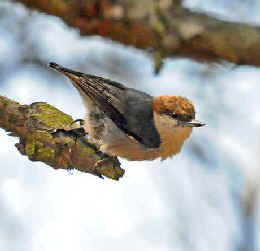 Delmarva
Birds
Delmarva
Birds
on the so-named peninsula
in Delaware, Maryland, Virginia
including those during
Focus On Nature
birding and nature tours
and offshore pelagic trips
Photo at right: Brown-headed Nuthatch
(photo by Howard Eskin)
A List of Birds in
Delaware, Maryland, and Virginia,
on the Delmarva Peninsula, compiled by Armas Hill
Codes:
(p): seen during FONT offshore pelagic trips from Lewes,
Delaware
(t): globally-threatened
species, as designated by Birdlife International
(t1): critical (t2): endangered
(t3): vulnerable
(nt): a near-threatened species
globally
(r/DP): a rare species on the Delmarva Peninsula
(r/NA): a rare species in North America
(u/DP): an uncommon species on the Delmarva Peninsula
(u/NA): an uncommon species in North America
(i): an introduced species
(ph): species with a photo in the FONT website
DE; species that occurs (or has occurred) in
Delaware
bh: species that occurs (or has occurred) at
Bombay Hook Refuge in Delaware
bh*: species that nests (or has nested) at or near Bombay Hook Refuge
MD: species that occurs (or has occurred) in Maryland, on the Delmarva
Peninsula, including Cecil County
bw: species that occurs (or has occurred) at Blackwater Refuge in
Maryland (in Dorchester County)
bw*: species that nests (or has nested) at or near Blackwater Refuge
VA: species that occurs (or has occurred) in Virginia, on the
Delmarva Peninsula
ch: species that occurs (or has occurred) at Chincoteague
Refuge in Virginia
ch*: species that nests (or has nested) at or near Chincoteague
Refuge
Links to Bird
Groupings in this List:
Waterfowl
Pelagic Birds Grebes
Ibises, Spoonbill, Stork
Bitterns, Herons, Egrets
Tropicbirds, Frigatebird, Pelicans, Gannet, Booby Cormorants,
Anhinga Raptors (inc.
Vultures)
Rails Shorebirds
Jaegers, Skuas
Gulls Terns, Skimmer
Alcids Doves
Cuckoos Owls
Nightjars, Nighthawk
Hummingbirds
Kingfisher
Woodpeckers
Flycatchers
Shrikes
Vireos
Corvids Chickadees,
Titmouse Nuthatches, Creeper
Swallows Lark
Kinglets Wrens
Gnatcatcher Thrashers & Allies
Thrushes & Allies Waxwings
Starling Pipits
Finches Warblers Icterids
Tanagers
Sparrows (including Longspurs, Towhees)
Dickcissel, Cardinal, Grosbeaks, Buntings
Other Links: Delmarva
Birds during FONT tours in 2015
A Complete List & Photo Gallery of North American Birds, in 6 parts:
Part #1: Grouse to Anhinga
Part #2: Condor to
Shorebirds Part #3: Jaegers to Cuckoos
Part #4: Owls to Flycatchers Part
#5: Shrikes to Pipits Part
#6: Olive Warbler to
Buntings
Lists with Other Delmarva Nature (each with some photos):
Mammals Butterflies
Moths
Dragonflies & Damselflies
Amphibians & Reptiles
Wildflowers & Other
Plants, a two-part list with about 1,700 species
Directory of Photos in this Website
Upcoming FONT Birding & Nature Tours:
in North
America
by month in: 2016 or: by geographic locations
worldwide

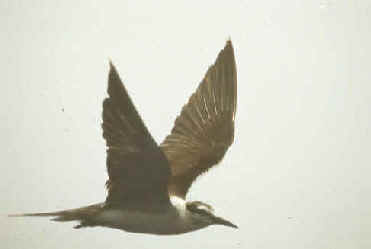
A Bridled Tern off the Delmarva Coast
(photograph by Alan Brady)
An interesting book relating to
birdlife on the Delmarva Peninsula, published back in 1975 and 1983, was
"Birds and Marshes of the Chesapeake Bay Country" by Brook Meanley.
Chapters in the book refer to the King Rail (or "Marsh Hen"), Bald
Eagle, Bobolink (or "Reedbird"), Black Rail, Red-winged
Blackbird,
Osprey, Swamp Sparrow, Rusty Blackbird, Red-cockaded Woodpecker,
Chuck-will's-widow, Brown-headed Nuthatch, Swainson's Warbler, and Canvasback.
Places referred to in the book included Elliot Island, Blackwater, Chincoteague,
and the Nanticoke and Pocomoke River valleys.
Some references are made to the Brook Meanley book in this list below.
Other books used as sources for information here, are the "Birds of
Delaware" by Gene Hess and others, published in 2000, and "Virginia's
Birdlife, an Annotated Checklist" by Stephen Rottenborn and Edward
Brinkley, 4th edition published in 2007.
Bird-List:
- Northern Bobwhite
- NORTHERN BOBWHITE (nt) (ph) ______
DE bh* MD
bw* VA ch*
Colinus v. virginianus
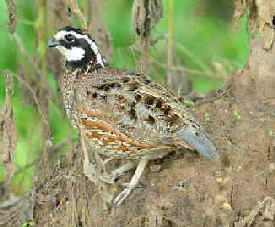
Northern Bobwhite
(photo by Howard Eskin)
- Common Pheasant (i) ______ DE
bh*
Phasianus colchicus
Some Common Pheasants,
dependent upon their race, have also been called "Ring-necked
Pheasant".
On the Eastern Shore of Virginia, the Common Pheasant was
last found near Oyster, by Cape Charles in May 1991.
- Wild Turkey (ph) ______ DE
bh* MD bw(rare) VA
Meleagris gallopavo silvestris
On the Eastern Shore of Virginia,
the Wild Turkey was reintroduced in the early 1990s.
WATERFOWL
- Black-bellied Whistling Duck
(r/DP) ______ DE MD VA
Dendrocygna autumnalis
Black-bellied Whistling Ducks
have been in Delaware:
August
6-7, 2000 at Oceanview, August 4, 2005 at Little Assawoman Bay, July 18,
2007 at Woodland Beach Wildlife Area, June 17, 2008 at Island Farm Road,
August 15, 20 at 1000 Acre Marsh, November 23, 2008 to August 19, 2009 at
Silver Lake, August 13, 2010 near Broadkill Beach
On the Eastern Shore of Virginia, Black-bellied Whistling Ducks were at Locustville
May 19, 1994 and Kiptopeke August 15, 1995.
- Fulvous Whistling Duck (r/DP) ______
DE bh MD
bw(very rare)
VA ch(very rare)
Dendrocygna bicolor
Fulvous Whistling Ducks have been in Delaware:
December 27, 1964 at Little Creek, December 28, 1983 at Silver Lake in
Rehoboth Beach, and May 26, 1990 at Bombay Hook Refuge.
- Mute Swan (i) (ph) ______
DE bh
MD bw(very rare)
VA ch*
Cygnus olor
- Tundra Swan (ph)
______ DE bh
MD bw VA ch
Cygnus c. columbianus
The North American subspecies, C.
c. columbianus, has been called the "Whistling
Swan".
- Greater White-fronted Goose (u/DP) ______
DE bh(rare) MD
bw(rare) VA ch(rare)
Anser albifrons
In 1994, there were said to be 2 subspecies of the Greater
White-fronted Goose. In 2008, there were said to be four.
In 2011, it was said that with the 5 well-defined "population
units" occurring in North America, they may involve 4 subspecies, as
noted below, or one more.
"Tundra White-fronted Goose" (Anser
albifrons gambelli, and possibly A. a.
frontalis) breeds in the Arctic, in Canada and Alaska,
including 2 units, 1 on the tundra and 1 on the taiga; winters in the
south-central US and northern Mexico
"Pacific White-fronted Goose"
(Anser albifrons sponsa) breeds in western Alaska,
winters from California to western Mexico
"Tule White-fronted
Goose" (Anser albifrons elgasi)
a small population that breeds in Alaska, winters in central
California
"Greenland White-fronted Goose"
(Anser albifrons flavirostris) breeds
in Greenland, wintering in Britain and Ireland, a different subspecies than
that on mainland Eurasia (Anser albifrons
albifrons) which has not been known to occur in North America
Of the birds above, the "Tundra White-fronted Goose" and
the "Greenland White-fronted Goose" have been in eastern
North America.
Since 1994, the Greater White-fronted Goose has occurred nearly
annually in Delaware and Maryland.
- Pink-footed Goose (r/DP) (ph)
______ DE bh(very
rare)
MD
Anser brachyrhynchus
A Pink-footed Goose was in Delaware at Bombay Hook
Refuge on
November 1, 1953.
One was said to be in Maryland on March 14, 1959 at Remington Farms
near Chestertown.
There have been two more-recent Pink-footed Goose sightings in
Maryland, in 2012 and 2014, west of the Chesapeake Bay.
- Canada Goose ______ DE
bh* MD bw* VA ch*
Branta c. canadensis
- Cackling Goose (ph) ______
DE bh MD
VA ch(rare)
Branta hutchinsii
In Maryland, there were reports of Cackling Geese on the
Eastern Shore in:
Kent County in December 1964, Dorchester County in November 1966, December
1995, and Cecil County in January
2004.
- Brant (ph) ______
DE MD bw(very rare) VA ch
Branta bernicia
"Black Brant" (r/DP) ______ DE
MD
Branta bernicia nigricans
"Black Brant"
have been in Delaware: October 24, 2004 and December 4-6, 2005
at the Indian River Inlet, and November 25, 2006 to January 28, 2007 at
Bethany Beach.
A "Black Brant" was in Ocean City, Maryland on
February 6, 2004.
- Barnacle Goose (r/DP) (ph) ______
DE bh(very rare) MD
bw(very rare)
Branta leucopsis
Accepted recorded of Barnacle Geese in Delaware have been:
November 13, 1973, January 19, 1980, November 21-24, 2010, all at Bombay
Hook Refuge.
In Maryland, there were accepted records of Barnacle Geese
on the Eastern Shore in:
Wicomico County in February 2000, Kent County in January 2005, January 2006,
and January 2012
- Snow Goose (ph) ______ DE
bh MD bw VA ch
Chen (has
been Anser) caerulescens
Chen caerulescens caerulescens "Lesser
Snow Goose" ______ MD bw
Chen caerulescens atlanticus
"Greater
Snow Goose" ______ DE
bh VA ch
On the Delmarva Peninsula, it is the Lesser Snow Goose
that winters mainly in Maryland in and near the Blackwater National
Wildlife Refuge.
Into the 1970s, there were from 2 to 4 thousand Lesser Snow Geese at
Blackwater, only a small fraction of the many Snow Geese in that
subspecies further west in North America.
It has been and continues that the entire population of the Greater Snow
Goose winters along the Middle Atlantic Coast. Those on the Delmarva
Peninsula congregate in Delaware, from the areas of the Bombay
Hook and Prime Hook National Wildlife Refuges south to Chincoteague Refuge
in Virginia.
in recent years, the number of Greater Snow Geese has significantly
increased.
There are two color morphs of both the Lesser and the Greater Snow
Goose, as is also the case with the similar but smaller Ross' Goose
(the nest species in this list).
The dark morph of the Snow Goose was called the "Blue
Goose". It interbreeds with the white Snow Goose.
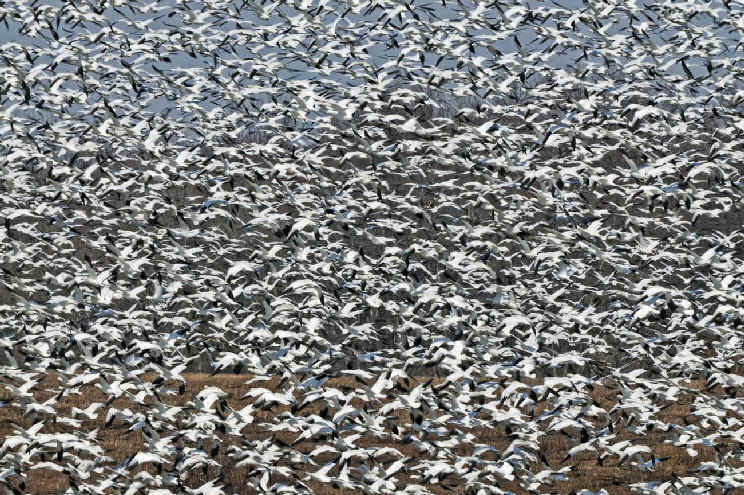
A blizzard of Snow Geese at Bombay Hook Refuge in
Delaware
There are thousands of birds in this photograph. (photo by
Howard Eskin)
- Ross' Goose (u/DP) ______
DE bh(rare) MD
bw(very rare)
VA ch(rare)
Chen rossii
During recent decades, the Ross' Goose has occurred annually in Delaware.
Once considered very rare, the blue morph of the Ross' Goose
was first observed in Delaware on December 4, 1994.
- Wood Duck (ph) ______ DE
bh* MD bw* VA ch*
Aix sponsa
(monotypic)
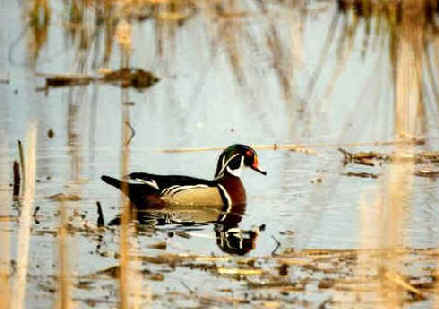
A male Wood Duck in a Delaware marsh
(photo by Marie Gardner)
- Mallard (ph) ______ DE
bh* MD bw* VA ch*
Anas p. platyrhynchos
- American Black Duck (ph) ______
DE bh* MD
bw* VA ch*
Anas rubripes
(monotypic)
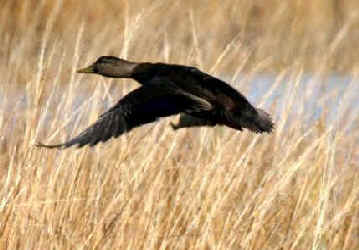
American Black Duck
(photo by Marie Gardner)
- Gadwall (ph) ______ DE
bh* MD bw VA ch*
Anas s. strepera
- Blue-winged Teal (ph) ______
DE bh* MD
bw* VA ch*
Anas discors (monotypic)
- Cinnamon Teal (r/DP) ______
DE bh(very
rare) MD VA ch(very rare)
Anas cyanoptera
Cinnamon Teals
have been in Delaware: October 9, 1995 at the Little Creek Wildlife
Area, August 22-23, 1997 and March 29, 2000 at Bombay Hook Refuge, September 29, 2006 and September 15-16, 2007 at the Ted Harvey
Wildlife Area, September 16 and October 21, 2012 at Bombay Hook Refuge.
Cinnamon Teals
in Virginia included those at Chincoteague Refuge March 24-25, 1991
and at Hog Island Oct 14-17, 1998. Up to 6 were at Hog Island.
- Garganey (r/NA) ______ DE
bh(very rare) MD
VA ch(very rare)
Anas querquedula
An adult male Garganey was at Bombay Hook Refuge, in Delaware,
from April 24 to May 12, 1976.
A female Garganey was in Maryland within the Ocean City
Christmas Count circle on December 29, 1992.
In Virginia, there was a Garganey at Chincoteague Refuge
September 6, 2010.
- Northern Pintail (ph) ______
DE bh MD bw VA ch
Anas acuta (monotypic)
- Northern Shoveler (ph) ______
DE
bh* MD bw VA ch
Anas clypeata
(monotypic)
- American Wigeon (ph) ______
DE bh MD
bw VA ch
Anas americana (monotypic)
- Eurasian Wigeon (u/DP) (ph) ______
DE bh(rare) MD
bw(rare) VA ch(rare)
Anas penelope
- American Green-winged Teal (ph)
______ DE bh
MD bw VA ch
Anas carolinensis
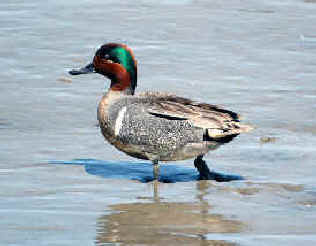
American Green-winged Teal
(photo by Howard Eskin)
- Eurasian Teal (r/DP) (ph) ______
DE bh(very
rare) MD
Anas crecca
The Eurasian Teal (or Common Teal as it is called in Eurasia)
has been in Delaware:
February 14-21, 2004 near Broadkill Beach, February 18, 2008 near Prime Hook
Wildlife Refuge, February 14-15, 2009 and March 21, 2010 and March 20, 2011
near Broadkill Beach, April 19, 2011 at the Ted Harvey Wildlife Area, March
18, 2012 near Broadkill Beach.
A Eurasian Teal was in Maryland at the Vaughn Wildlife Area in
Girdletree March 17-26, 1998.
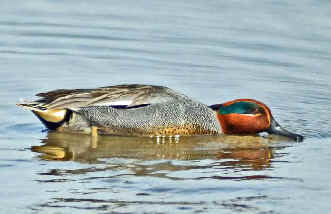
A Eurasian Teal photographed at Bombay Hook Refuge in Delaware in 2014
(photo by Howard Eskin,
Armas Hill was having a
nice day with Howard when he took this picture.)
- Canvasback ______ DE
bh MD bw VA ch(rare)
Aythya valisineria
- Redhead (ph) ______ DE
bh(rare) MD bw VA ch(rare)
Aythya americana
- Ring-necked Duck (ph) ______
DE bh MD
bw VA ch
Aythya collaris
- Greater Scaup ______ DE
bh MD bw VA ch
Aythya marila
- Lesser Scaup (ph) ______ DE
bh MD bw VA ch
Aythya affinis
- Tufted Duck (r/DP) (ph) ______
DE MD VA ch(very
rare)
Aythya fuligula
Tufted Ducks
have been in Delaware: February 20 to March 6, 2000, November
22, 2000 to March 15, 2001, November 4, 2001, and November 24 to December
28, 2002. All of these
were at Spring Lake in Rehoboth Beach.
In Virginia, a Tufted Duck was at Chincoteague Refuge January
27-28, 1996.
- Common Eider (ph) ______ DE MD
VA ch(rare)
Somateria mollissima dresseri
- King Eider (u/DP) (ph) ______
DE MD VA ch(rare)
Somateria spectabilis
In Maryland, 2 immature male King Eiders were in Ocean
City from May 18 to August 2, 1991 (an odd time of year for a normally wintering
species). An immature male was in Cambridge November 22 to December 1,
1997.
Along the seacoast, there have been a number of other
occurrences.
- Harlequin Duck (ph) ______ DE
MD VA ch(rare)
Histrionicus histrionicus
In Virginia, two migrating male Harlequins were in marshes
along the causeway to Chincoteague Island April 3, 1982, and 2 were by
Wallops Island November 7, 1990.
Most records of Harlequin Ducks in Virginia have been at the
Chesapeake Bay Bridge Tunnel. High counts for them there were: 15 on March
5, 1978, 13 on December 26, 1997.
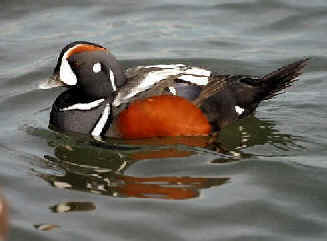
A male Harlequin (photo by
Howard Eskin)
- Surf Scoter (ph) ______ DE
bh MD VA ch
Melanitta perspicillata
- White-winged Scoter ______ DE
bh MD bw(rare) VA ch
Melanitta deglandi
The White-winged Scoter was conspecific with the Velvet Scoter of Europe,
Melanitta fusca. It has also been said to be conspecific with what is now
said to be the Asian White-winged Scoter, Melanitta stejnegeri.
- Black Scoter (ph) ______
DE bh
MD VA ch
Melanitta americana
The Black Scoter was
conspecific with the Common
Scoter of
Europe, Melanitta nigra.
- Long-tailed Duck (t3) (ph) ______
DE
bh MD bw VA ch
Clangula hyemalis
- Bufflehead (ph) ______ DE
bh MD bw VA ch
Bucephala albeola
- Common Goldeneye ______ DE
bh MD bw VA ch
Bucephala clangula
- Barrow's Goldeneye (r/DP) (ph)
______ DE MD VA
Bucephala islandica
Barrow's Goldeneyes
in Delaware were: November 16,1929 in Milford, January 7-9,
1989 at Indian River Inlet.
In Virginia, Barrow's Goldeneyes were at the Chesapeake Bay Bridge
Tunnel February 28, 1982, March 5, 1994.
- Hooded Merganser (ph) ______
DE bh MD bw VA ch
Lophodytes cucullatus
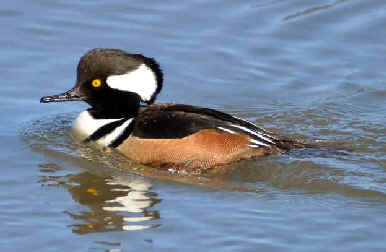
Above & below: Hooded Mergansers, a male
(above)
and a female
(below)
(photos by Howard Eskin)
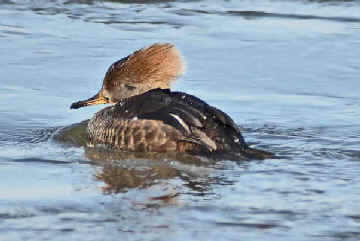
- Common Merganser (ph) ______
DE
bh MD bw VA ch
Mergus merganser americanus
- Red-breasted Merganser (ph)
______ DE bh
MD bw VA ch
Mergus serrator
- Ruddy Duck (ph) ______ DE
bh MD bw VA ch
Oxyura jamaicensis
- Masked Duck (r/NA) ______
MD
Nomonyx dominicus
An adult male Masked Duck was in Maryland at the Elk River
Marshes, about 4 miles from Elkton (in Cecil County), September 8, 1905.
- Common Loon (p) (ph) ______
DE bh MD bw VA ch
Gavia immer (monotypic)
Common Loons (16) were seen during a FONT pelagic trip
offshore from Lewes, Delaware in June 2000.
During other such trips in June 2001 and June 2002, single Common Loons
were seen.
- Red-throated Loon (ph) ______
DE bh
MD bw(very rare) VA ch
Gavia stellata
(monotypic)
- Pacific Loon (r/DP) (ph) ______
DE MD VA
Gavia pacifica
Reports of Pacific Loon in Delaware have been:
In 1996, November 30 at the Indian River Inlet
In 1997: January 20, February 2, February 16, March 1, all at the Indian
River Inlet, October 18 at Lewes.
On the Eastern Shore of Virginia, reports of Pacific Loons
have included these:
December 6, 1994 at Wise Point in Northampton County
November 26, 1996 at Kiptopeke
January 5, 2001 at the Chesapeake Bay Bridge Tunnel
December 30, 2003 at Cherrystone Landing in Northampton
County
PELAGIC BIRDS
- Atlantic Yellow-nosed Albaross (p)
(t2) (r/NAwaters) ______ MD(offshore,
very rare) VA(offshore, very rare)
Thalassarche chlororhynchos
An Atlantic Yellow-nosed Albatross was seen in Maryland
offshore waters on February 1, 1975, 60 miles east of Ocean City. It was
a sub to nearly adult.
Another was seen closer to shore at the Assateague Island National Seashore,
Maryland, on June 6, 2009.
Off Virginia, there was an Atlantic Yellow-nosed Albatross on
December 3, 1979, 55 miles east of Assateague Island.
- Northern Fulmar (p) (ph) ______
DE(offshore)
MD(offshore) VA(offshore)
Fulmarus glacialis
- Trindade Petrel (p) (t3) (u/NAwaters)
______ MD(offshore, very rare)
Pterodroma arminjoniara
The Trindade Petrel is an oceanic species breeding on islands off
northern Brazil in the tropical South Atlantic Ocean.
This pelagic species off the east coast of North America (mostly off North
Carolina), has been called the Herald Petrel, but that name is now
for the species in the Pacific Ocean while Trindade Petrel is for
that in the Atlantic.
One dark-morph Trindade Petrel was seen offshore in Maryland
waters on August 25, 2012.
- Black-capped Petrel (p) (t2) (r/DPwaters)
______ MD(mostly offshore, rare)
VA(mostly offshore, rare)
Pterodroma hasitata
A single Black-capped Petrel was seen in Maryland offshore
waters on July 18, 1979, 180 miles east of Ocean City.
Away from the ocean, a single Black-capped Petrel was at St Michaels,
Maryland on September 11, 1996 with Hurricane
Fran.
In Virginia offshore waters, a single Black-capped Petrel was
east of Chincoteague on April 8, 1973.
Also in Virginia, following some recent hurricanes, Black-capped
Petrels were at the Chesapeake Bay Bridge Tunnel:
July 13, 14, 26, 1996 - Hurricane Bertha (9 birds)
September 7, 1996 - Hurricane Fran (2 birds)
August 27, 1998 - Hurricane Bonnie (1 bird)
September 5, 1999 - Hurricane Dennis (1 bird)
September 19, 20, 2003 - Hurricane Isabel (5
birds)
- Cory's Shearwater (p) (ph) ______
DE(offshore) MD(offshore) VA(offshore) ch(offshore)
Calonectris (diomedea) borealis
What has been Cory's Shearwater has been considered by some to be 3 species:
those that breed in the Mediterranean
as: Scopoli's
Shearwater, Calonectris diomedea;
those
that breed in the Azores, Madeira, & Canary Islands as: Cory's Shearwater, Calonectris
borealis;
and those that breed in the Cape Verde Islands as:
Cape Verde Shearwater, Calonectris edwardsii
Cory's Shearwaters were seen during FONT pelagic trips offshore from Lewes,
Delaware in:
August 1997, June 1998, June 1999, June 2000 (18), September 2000 (25),
June 2001 (5), June 2002 (3).
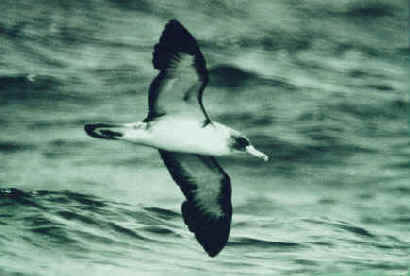
Cory's Shearwater
(photo by Alan Brady)
- Scopoli's Shearwater (p) (r/DPwaters)
______ MD(offshore)
Calonectris (diomedea) diomedea
A single Scopoli's Shearwater was in Maryland offshore waters
on August 28, 2004.
- Cape Verde Shearwater (p) (r/DPwaters)
______ MD(offshore)
Calonectris edwardsii
A single Cape Verde Shearwater was in Maryland offshore waters
on October 21, 2006.
- Great Shearwater (p) (ph) ______
DE(offshore) MD(offshore) VA(offshore) ch(offshore)
Puffinus gravis
(monotypic)
Puffinus gravis
has been called
Greater Shearwater.
Great Shearwaters were seen during FONT pelagic trips offshore from Lewes,
Delaware in:
August 1997, June 1998, Jun 1999, June 2000 (327), September 2000 (15), June
2001 (2), June 2002 (3)

Great Shearwater
(photo by Alan Brady)
- Sooty Shearwater (nt) (p) (ph) (*)
______ DE(offshore) MD(offshore) VA(offshore) ch(offshore)
Puffinus griseus
(monotypic)
Sooty Shearwaters were seen during FONT pelagic trips offshore
from Lewes, Delaware in:
June 1998, June 2000 (595), June 2001 (5), June 2002 (83)
- Audubon's Shearwater (p) (ph) ______
DE(offshore) MD(offshore)
VA(offshore)
Puffinus l. lherminieri
Audubon's Shearwaters were seen during FONT pelagic trips offshore from
Lewes, Delaware in:
August 1997, June 1998 (August 1997 was the first Delaware state
record)
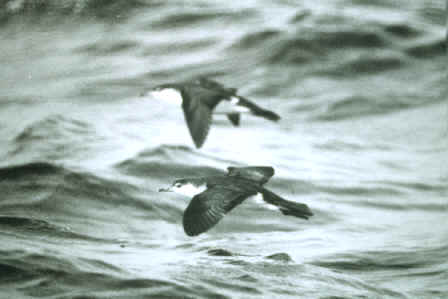
Audubon's Shearwaters
(photo by Alan Brady)
- Manx Shearwater (p) ______ DE(offshore) MD(offshore)
VA(offshore) ch(die-off)
Puffinus puffinus
(now monotypic)
The Manx Shearwater did
include what is now
the Yelkouan
and
Balearic
Shearwaters of
the Mediterranean. Those birds do not occur in the western Atlantic.
Manx Shearwaters were seen during a FONT pelagic trips offshore from
Lewes, Delaware in:
June 2000 (1), June 2002 (1)
- Bulwer's Petrel (p) (r/NA) (ph)
______ VA
Bulweria bulwerii
In Virginia, a Bulwer's Petrel was seen at the Chesapeake
Bay Bridge Tunnel on September 2, 2006, with Hurricane Ernesto.
- Leach's Storm Petrel (p) ______
DE(offshore) MD(offshore)
VA(mostly offshore)
Oceanodroma l. leucorhoa
Leach's Storm Petrels were seen during FONT pelagic trips
offshore from Lewes, Delaware in:
June 1998, June 2000 (1), June 2001 (1)
- Band-rumped Storm Petrel (p) (u/DPwaters) ______
DE(offshore, rare) MD(offshore, rare)
VA(mostly offshore, rare)
Oceanodroma castro
(monotypic)
Oceanodroma castro
has also been called the Harcourt's, or Madeiran Storm
Petrel.
Band-rumped Storm Petrels
were seen in offshore Delaware waters on August 14, 1975 and
August 19, 2011.
There were also sightings July 14 and 15, 1996 from the Lewes Ferry in the
Delaware Bay after Tropical Storm Bertha.
4 Band-rumped Storm Petrels were seen in Delaware offshore
waters on August 7, 2012. 1 of them was photographed,
2012 was the 2nd consecutive year for multiple birds of this species in Delaware
offshore waters.
The Band-rumped Storm Petrel was seen during a FONT pelagic trip
in Maryland waters in:
August 1997 (August 1997 was the first Maryland state record)
- Wilson's Storm Petrel (p) (ph)
(*) ______ DE(mostly offshore) MD(mostly
offshore) VA(mostly offshore) ch(mostly
offshore)
Oceanites oceanicus
There are 2 subspecies of the Wilson's Storm Petrel in the North Atlantic:
O.
o. oceanicus and O. o.
exasperatus.
Wilson's Storm Petrels were seen during FONT pelagic trips
offshore from Lewes, Delaware in:
August 1997, June 1998, June 1999, June 2000 (575), September 2000 (120),
June 2001 (24), June 2002 (112)
In Maryland, away from the ocean, a single Wilson's Storm Petrel
was near Smith Island in the Chesapeake Bay on July 23, 1991.
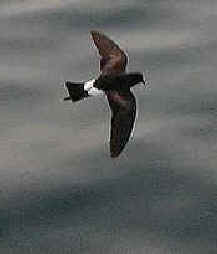
Wilson's Storm Petrel
- White-faced Storm Petrel (p) (u/DPwaters)
(ph) (*)
______ DE(offshore, rare) MD(offshore, rare) VA(offshore,
rare)
Pelagodroma marina (the single member of its genus)
There are 2 subspecies of the White-faced
Storm Petrel in the North
Atlantic:
P. m. hypoleuca, breeding
in the Madeira & Canary Is.,
P. m. eadesi, breeding
in the Cape Verde Is.
White-faced Storm Petrels were seen in Delaware offshore waters:
August 26, 1972, August 25, 2006, August 3, 2007, August 22, 2008, September
15, 2009.
White-faced Storm Petrels were seen in Maryland offshore waters:
August 22, 1993, August 17, 1997, August 28, 2004, August 25,
2006,
All of these were single birds.
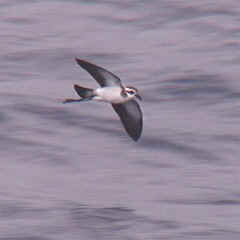
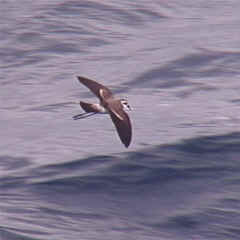
Two photographs of a White-faced Storm Petrel
during a FONT pelagic trip off the East Coast of the US
GREBES
- Pied-billed Grebe (ph) ______
DE bh* MD bw* VA
ch
Podilymbus p. podiceps
- Horned Grebe (ph) ______ DE
bh MD bw VA ch
Podiceps auritus
- Eared Grebe (u/DP) (ph) ______
DE
MD VA ch(rare)
Podiceps nigricollis
Eared Grebes
have been in Delaware: December 20, 1991 at the Indian River
Inlet, January 4, 1992 at Cape Henlopen, June 18, 1994 near Broadkill Beach,
December 30, 1995 at Indian River Inlet, November 16, 1996 and February 5,
1997 at Rehoboth Bay, February 8, 1998 at Dewey Beach, November 26, 2000 at
Cape Henlopen, January 27 to February 16, 2002 and March 16, 2003 at
Rehoboth Bay, March 4, 2007 at the Indian River Inlet, October 18, 2007
northeast of Roosevelt Inlet, February 5, 2012 at Cape Henlopen, February 9
to March 11, 2013 (yes, present over a month).
- Red-necked Grebe (ph) ______
DE bh(rare) MD VA ch(rare)
Podiceps grisegena
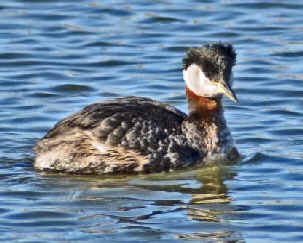
Red-necked Grebe
(photo by Howard Eskin)
- Western Grebe (r/DP) (ph) ______
DE MD bw(very rare) VA ch(very rare)
Aechmophorus occidentalis
Western Grebes
were in Delaware:
November 25, 1948 at the Indian River Inlet, February 14, 1972 at Cape
Henlopen, May 28 to June 2, 2006 at Battery Park along the Delaware
River in New Castle, January 29 to February 14, 2012 at Cape Henlopen and
the ferry terminal in Lewes, December 23, 2012 at and near Augustine Beach,
and January 6, 2013 at the Beach Plum Island Reserve.
Western Grebes were on the Eastern Shore of Virginia: at
Chincoteague Refuge February 17, 1991, and at the Chesapeake Bay Bridge
Tunnel February 1-17, 2001.
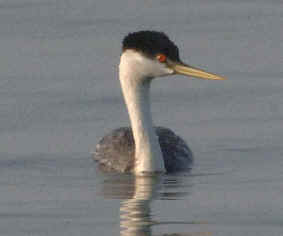
This Western Grebe was photographed in Delaware
in New Castle at Battery Park, in May 2006.
- Clark's Grebe (r/DP) ______
DE VA
Aechmophorus clarkii
A Clark's Grebe was in Delaware at the Indian
River Inlet on November 25, 1988.
In Virginia, a Clark's Grebe was at the Chesapeake Bay Bridge
Tunnel February 11, 2000, December 18-31, 2001.
IBISES, SPOONBILL, STORK
- American White Ibis (ph) ______
DE bh(rare) MD
bw(rare) VA ch(usually rare)
Eudocimus albus
(monotypic)
American White Ibises were seen in Delaware:
August 20, 1989 near Smyrna, August 7, 1995 and July 11, 1998 at Bombay Hook
Refuge.
Since 2002, the American White Ibis has occurred nearly annually in
Delaware.
But in 2015 a tremendous influx of American White Ibises occurred
in Delaware, and elsewhere on the Delmarva Peninsula.
In July of that year, over 100 American White Ibises were roosting,
in the late afternoon and evening, at a pond in Lewes, with the high count
of 111 birds, all immature, but with one having the more-white nearly adult
plumage.
That was an unprecedented number for Delaware, but just as
unprecedented if not more so, was a report of 1,700 American White Ibises
in Virginia near Chincoteague also in July 2015.
Back in 1988, a single American White Ibis at the
Blackwater Wildlife Refuge in Maryland March 7-28 was notable.
In Virginia, during most years (even when there is not an influx of American
White Ibises from the south) in the late summer and fall, a good number
of them can be present in the area of Chincoteague, mostly immature birds.
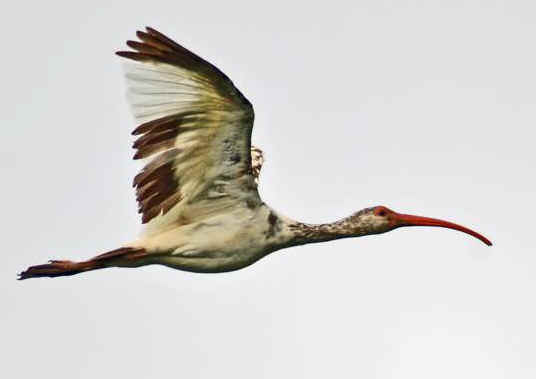
A not-yet adult American White Ibis during the big influx year of 2015
(photo by Howard Eskin)
- Glossy Ibis (ph) ______ DE
bh MD bw VA ch
Plegadis falcinellus
(although
many places world-wide, considered monotypic)
- White-faced Ibis (u/DP) (ph) ______
DE
bh(rare) MD VA ch(rare)
Plegadis chihi
Since 1991, the White-faced Ibis has occurred nearly annually in Delaware,
seen mostly at Bombay Hook Refuge.
In Maryland, a White-faced Ibis was in Worcester County on May
3, 2015, along Public Landing Rd, west of Paw Paw Creek Rd.
On the Eastern Shore of Virginia, White-faced Ibises were: at
Chincoteague Refuge July 8 and August 2, 1979, June 27 to July 4, 1999, May
6-11, 2001, May 19 to June 5, 2002. Also: at Fairview near Cape Charles May
29, 2003 (2 birds), and at Chincoteague Refuge May 4 to August 7, 2003, May
25 to June 26, 2004, April 29 to June 12, 2005.
- Roseate Spoonbill (r/DP) (ph)
______ DE bh
MD
Platalea ajaja
There were Roseate Spoonbill sightings in Delaware, all in
2009:
June 2 to August 19 at Fenwick Island, July 6 at Fowler Beach, July 17 at
Thousand Acre Marsh, July 26 at Bombay Hook Refuge.
In Maryland, there were Roseate Spoonbills: on Smith Island
from April 14 to September 19, 1979, and from July 11 to August 23, 1996.
And in 2009, at Ocean City from June 24 to July 1 (see Fenwick Island above,
at the same time)..
- Wood Stork (r/DP) (ph) ______
DE bh(very rare)
VA
Mycteria americana
Wood Storks
were in Delaware: at Gordon Pond January 10, 1973, and at Bombay Hook
Refuge
August 19-20, 1997.
A Wood Stork was seen at the Ashland hawk watch on October 25, 2009,
an hour and a half after one was seen at another hawk watch a few miles to
the north in southeastern Pennsylvania, at Militia Hill.
On the Eastern Shore of Virginia, Wood Storks were at Wise Point (at
the Eastern Shore of VA Wildlife Refuge) December 1, 1994, and at Fisherman
Island June 10, 2000.

The juvenile Wood Stork that was at Bombay Hook
Refuge in Delaware in August 1997
(photo by Marie Gardner)
BITTERNS,
HERONS, EGRETS
- American Bittern (ph) ______
DE bh*
MD bw* VA ch
Botaurus lentiginosus
- Least Bittern (ph) ______
DE
bh* MD bw* VA ch*
Ixobrychus exilis
- Great Blue Heron (ph) ______
DE bh
MD bw VA ch
Ardea h. herodias
"Great White Heron"
______ (a color morph of the Great Blue Heron)
"Great White
Herons" were in Delaware near Woodland Beach from November 24,
2001 to January 1, 2002, and November 1-7, 2009 at Bethany Beach.
In Maryland, "Great White Herons" were in: Ocean City on
November 13, 2004, at the Eastern Neck Wildlife Refuge from August 20, 2006 to
October 24, 2006, and at Galena in Kent County on August 31, 2006.
- Great Egret (ph) ______ DE
bh MD bw VA ch
Ardea alba egretta
- Snowy Egret (ph) ______ DE
bh MD bw VA ch
Egretta
t. thula
- Little Egret (r/NA) (ph) ______
DE bh(very
rare) VA ch(very rare)
Egretta g. garzetta
Little Egrets have been in
Delaware: April 25-26, 1999 at the Little Creek Wildlife Area, June
13-22, 1999, June 9, 2001, June 7-11, 2008 at Bombay Hook Refuge, and May
22, 2011 at Fowler Beach.
A Little Egret was seen during
a FONT tour at Chincoteague Refuge, in Virginia.
At Chincoteague, there were Little Egrets:
in 1992 from May 17 to September 28, and in 1993 from July 24 to September
25.
The bird seen during the FONT tour was in the late spring of 1992.
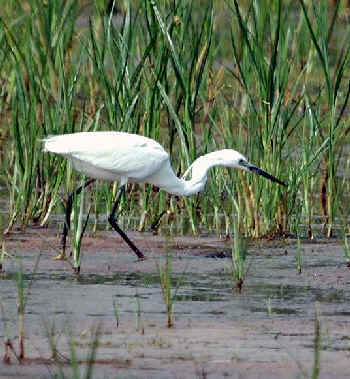
This Little Egret was photographed at Bombay Hook
Refuge in Delaware
(photo by Howard Eskin)
- Little Blue Heron (ph) ______
DE bh
MD bw VA ch
Egretta caerulea
(now monotypic)
- Tricolored Heron
(ph) ______ DE bh
MD bw VA ch
Egretta tricolor ruficollis
Egretta tricolor
was called the Louisiana
Heron.
- Reddish Egret (u/DP) (ph) ______
DE MD VA ch(very rare)
Egretta rufescens
Reddish Egrets
have been in Delaware:
July 2, 1991 at the Little Creek Wildlife Area, August 13-14, 1993 at the
Ted Harvey Wildlife Area.
In Maryland, a Reddish Egret was Skimmer Island in Ocean City
on June 23, 2003.
On the Eastern Shore of Virginia, a white morph Reddish Egret
was at Chincoteague Refuge September 21, 1978, and a dark morph was by the
Chincoteague causeway June 20, 2003.
- Western Cattle Egret (ph) ______
DE bh
MD bw VA ch
Bubulcus i. ibis
As info, the Eastern Cattle
Egret, Bubulcus coromandus, occurs
in southern and eastern Asia.
The first Western Cattle Egret in Delaware was near Leipsic on
May 13, 1954. It may have started nesting in the state in 1962. Two years
later, it was found breeding on Pea Patch Island, where, subsequently, it
has nested for years.
The first Western Cattle Egret in Virginia was at Chincoteague
Refuge on May 13, 1953. The first recorded nesting in Virginia was
near Wachapreague on June 18, 1961.
The population of the bird in Virginia increased through the 1960s.
Since then numbers declined steadily until the mid-1990s. Since then,
numbers have declined dramatically.
A survey in the Eastern Shore area of Virginia in 1993 found 9
colonies containing about 1,460 pairs. A repeat survey in 2003 found 6
colonies containing about 165 pairs.

Western Cattle Egrets
(photo by Howard Eskin)
- Green Heron (ph) ______ DE
bh* MD bw* VA ch*
Butorides v. virescens
The Green Heron was for a
time considered conspecific with the nearly-cosmopolitan Striated Heron,
and was then called the Green-backed Heron.
- Black-crowned Night Heron (ph) ______
DE bh MD bw* VA
ch
Nycticorax nycticorax hoactli
- Yellow-crowned Night Heron (ph)
______ DE bh
MD VA ch
Nyctanassa v. violacea
TROPICBIRDS,
FRIGATEBIRD,
PELICANS, GANNET, BOOBY
- White-tailed Tropicbird (r/DP)
(ph) ______ DE MD VA(mostly
offshore, rare)
Phaethon lepturus
A White-tailed Tropicbird was seen from Fowler Beach in Delaware
on August 28, 2011.
In Maryland offshore waters, there was a White-tailed Tropicbird
on July 13, 2011.
An adult White-tailed Tropicbird was at the Chesapeake Bay Bridge
Tunnel, Virginia, September 19, 2003, with Hurricane
Isabel.
- Red-billed Tropicbird (r/DP)
(ph) ______ DE VA
Phaethon aethereus
Even though the Red-billed Tropicbird is not on the official
list of Delaware birds, as it has never been seen in Delaware,
the bird has occurred in the state - during Hurricane Sandy in late
October 2012.
Related to this, you may read what is in the insert below.
*********************************************************************************************************************
An excerpt from a Birdline narrative and a Cassinia
(DVOC) article by Armas Hill:
"A juvenile Red-billed Tropicbird
was found, exhausted, on the New Jersey side of the Delaware River on
October 30 (2012).
It was taken from the Carney's Point area, to a rehab center in
southern New Jersey, where the bird did well, before being taken to the Tri-State
Rescue Center in Delaware.
Actually, where the bird came ashore, the land is New Jersey, but the
water is Delaware. So, the bird was taken back to a state where it
must have been.
It's said to be the second Red-billed Tropicbird that's been in New
Jersey. I remember apparently the first, also a juvenile, years ago in May
1983, which was taken to a bird rehab center on Long Beach Island (in
NJ)."

The juvenile Red-billed Tropicbird that came
to the Delaware Bay and River during Hurricane Sandy
For the complete narrative from which the above excerpt was
taken:
THE BIRDLINE, NOV 5, 2012:
UNUSUAL BIRDS WITH AN UNUSUAL STORM, HURRICANE SANDY
************************************************************************************************************************
In Virginia, there was a Red-billed Tropicbird in
Northampton County on May 24, 2009. It was the first for the state.
- Magnificent Frigatebird (r/DP)
(ph) ______ DE MD VA ch(very
rare)
Fregata magnificens
Magnificent Frigatebirds have been seen in Delaware:
April 28, 1980 at Fenwick Island, November 7, 2005 at Cape Henlopen and
Lewes.
The April 1980 Magnificent Frigatebird just referred to was also seen
in Maryland at Ocean City.
On the Eastern Shore of Virginia, Magnificent Frigatebirds
have included: an immature at the Chesapeake Bay Bridge Tunnel July 3, 1968,
another near Hog Island July 14, 1972, and at Chincoteague Refuge May 14-17,
1976 (an injured bird, subspecies determined to be rothschildi).
Others: at Hog Island January 29, 1980, an adult male at Chincoteague Refuge
September 20-28, 1998, at the Chesapeake Bay Bridge Tunnel May 23, 2004, an
adult female at Kiptopeke November 9,
2005.
- Brown Pelican (ph) ______
DE MD VA ch
Pelecanus occidentalis carolinensis
4 Brown Pelicans were
seen during a FONT pelagic trip offshore from Lewes, Delaware in June
2000.
The status of the Brown Pelican along the seacoast of the Delmarva
Peninsula has changed dramatically since the late 1970s. The increase
has been due to the ban of the pesticide DDT. That pesticide nearly caused
the extirpation of the species from the United States prior to the ban.
In Virginia, Brown Pelicans began appearing along the coast in the
spring of 1977. There were up to 30 of them at Fisherman Island on May 23 of
that year. Many lingered there until August and some into the fall.
In the 1980s, there was a major increase in the Virginia population,
and nesting in the state was first documented in 1987.
- American White Pelican (u/DP) (ph)
______ DE bh(rare) MD
bw(rare) VA ch(rare)
Pelecanus erythrorhynchos
In Delaware, American White Pelicans were: at the Bombay Hook
Wildlife Refuge on August 17, 1985, May 21-22, 1994, at the Thousand Acre
Marsh July 22 to August 30, 2000, at the Indian River Inlet January 7 to
February 3, 2001, at the Ted Harvey Wildlife Area February 9-10, 2001, at
the Bombay Hook Wildlife Area October 8, 2002, at the Little Creek Wildlife
Area October 27, 2002, by Fowler Beach November 14, 2002, at Port Mahon
December 22, 2002, by Broadkill Beach January 11, 2003, by Port Mahon March
29, 2003, by Broadkill Beach August 28, 2003, at Gordon's Pond November 12,
2003, at the Thousand Acre Marsh November 18, 2003, at the Primehook
Wildlife Area April 30 and May 1, 2004, at the Ted Harvey Wildlife Area
August 22 to September 18, 2005, at Gordon's Pond November 2, 2006, at the
Assowoman Wildlife Area December 31, 2006.
And more recently at the Bombay Hook Wildlife Area September 19, 2013.
10 were at Fowler Beach on May 23, 2015.
In Maryland, in 2010, the American White Pelican was no longer
a "reviewable species". Sightings had become too frequent.
At Blackwater Refuge, they had begun in appear in considerable
numbers. In the spring of 2010, at one time, about 25 were there. In the
fall of 2012, a dozen were there.
In the spring of 2015, there were well over 100 American White Pelicans at
Blackwater at one time. Such a number together on the Delmarva Peninsula was
unprecedented.
Observations during spring of 2015 at Blackwater included: 77 birds on March
29, 123 on April 1 and 4, and 145 on April 7.
On the Eastern Shore of Virginia, American White Pelicans have
occurred every year since 1978. As many as 15 were north of Kiptopeke on
March 25, 1989.
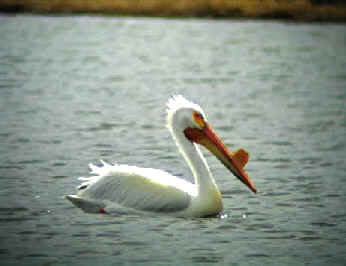
An American White Pelican, photographed during a
FONT tour,
with the large bump that it has on its big bill during its breeding season.
American White Pelicans with such bumps have been seen in Maryland
at the Blackwater Refuge during April, even though the bird does not nest
there.
The breeding range for the species is in western North America.
- Northern Gannet (p) (ph) ______
DE MD VA ch(offshore)
Morus (formerly Sula) bassanus (monotypic)
15 Northern Gannets were
seen during a FONT pelagic trip offshore from Lewes, Delaware in June
2000.
During another such trip in June 2001, there were 3 Northern
Gannets.
- Brown Booby (r/DP) (ph) ______
DE MD VA ch(very rare)
Sula leucogaster
A Brown Booby was in Delaware on July 18, 2010
at Broadkill Beach.
In Maryland, a Brown Booby was at the Assateague Island
National Seashore on August 3, 2009.
In Virginia, an immature Brown Booby was at Chincoteague
Refuge on September 30, 1972.
- Double-crested Cormorant (ph) ______
DE
bh MD bw VA ch
Phalacrocorax a. auritus
Double-crested Cormorants were seen during a FONT pelagic
trip offshore from Lewes, Delaware in June 2002.
CORMORANTS, ANHINGA
- Great Cormorant ______ DE
MD VA ch(rare)
Phalacrocorax carbo
- Anhinga (r/DP) (ph) ______
DE MD
VA ch(very rare)
Anhinga anhinga
Anhingas
were in Delaware on April 23, 1995 over the
Nanticoke River, May 17, 2002 over Newark, October 4, 2006 over Ashland, and
April 20, 2011 at Cape Henlopen.
Anhingas in Maryland have included one in Berlin May 7-8,
1983.
Among Anhingas in Virginia, there were 5 at Chincoteague
Refuge September 29, 1992.
RAPTORS
(including
VULTURES)
- Turkey Vulture (ph) ______
DE bh
MD bw* VA ch
Cathartes aura septentrionalis
- Black Vulture (ph) ______
DE bh
MD bw VA ch
Coragyps atratus (now said to be
monotypic) (the single member of its genus)
- Swallow-tailed Kite (u/DP) (ph) ______
DE bh(very rare) MD bw(very
rare)
Elanoides forficatus
Swallow-tailed Kites
have been in Delaware: May 7, 1977 at the Delaware Seashore State
Park, May 17, 1981 at Bombay Hook Refuge, April 23, 1996 at Cape Henlopen,
May 12, 2004 at Prime Hook Refuge, May 18, 2005 at Cape Henlopen, May 3,
2008 at Trap Pond, May 7, 2008 at Cape Henlopen, September 6, 2008 at
Millsboro, April 25, 2009 and April 4, 2010 and April 19, 2010 at Cape
Henlopen, May 24, 2011 at Middle Run, July 1, 2010 at Ingram Branch
Road.
Swallow-tailed Kites in Maryland have included these: May 21
to June 11, 1972 at the Blackwater Wildlife Refuge, October 13, 1995 at
Turkey Point in Cecil County, May 5, 2001 at Pickering Creek in Easton, May
29 to June 17, 2004 in Elkon.
Since 2005, the Swallow-tailed Kite has not been a reviewable species in
Maryland.
- Mississippi Kite (u/DP) ______
DE bh(very rare) MD
Ictinia mississippiensis (monotypic)
Mississippi Kites have been in
Delaware: May 9, 1992 and July 8, 1997 at Bombay Hook Refuge, May 12,
1997 at the Hoopes Reservoir, May 31, 2002 at Cape Henlopen, May 19, 2003 at
Dover, June 3, 2004 south of Newark (near the DE-MD state line), June 9,
2005 at Port Penn, June 12, 2005 south of Port Penn, June 2, 2007 at Prime
Hook Refuge, May 30, 2011 at Bombay Hook Refuge.
In May 2013, there were 6 different Mississippi Kites in 4 reports in
northern Delaware (from May 20 to 28, in Wilmington, Claymont,
Talleyville, New Castle). But only one of these reports was documented, in
Talleyville on May 27.
Since 2002, the Mississippi Kite has not been a reviewable species in
Maryland.
- White-tailed Kite (r/DP)
______ DE bh(very
rare)
Elanus leucurus
A White-tailed Kite was at Bombay Hook Refuge in Delaware
August 26, 1995.
On the Eastern Shore of Virginia, a White-tailed Kite was in
Cheriton, Northampton County, April 26, 1998.
- Osprey (ph) ______
DE bh* MD bw* VA
ch*
Pandion haliaetus carolinensis (the
single member of its genus)
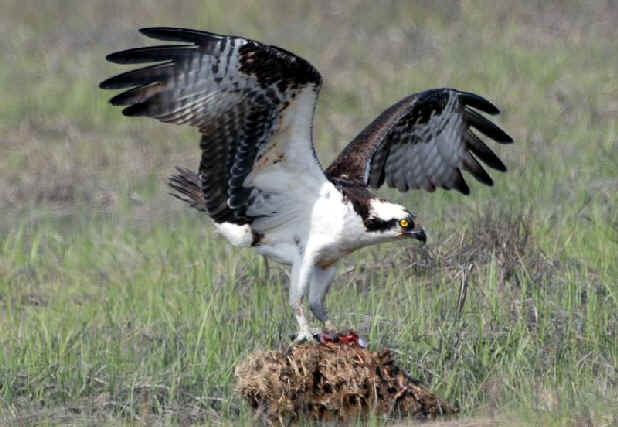
Osprey
(photo by Howard Eskin)
- Bald Eagle (ph) ______ DE
bh* MD bw* VA ch*
Haliaeetus leucocephalus
In Delaware in 2013, 91 active and historic Bald Eagle
territories were monitored, including 74 pairs of eagles that attempted
nesting. 54 of those eagle pairs, or 73 per cent, were successful in raising
a total of at least 81 chicks.
On April 27, 2015, as many as 43 Bald Eagles were counted at Bombay
Hook Refuge in Delaware on the mudflats opposite Shearness Pool at
low tide. There may have been a fish-kill. As the observers were leaving,
even more Bald Eagles were seen flying in.
In Maryland, Dorchester County (where Blackwater Refuge is located)
has had the highest density of nesting Bald Eagles in the eastern
United States north of Florida.
More Bald Eagles nest in that county in Maryland than in any other
county around the Chesapeake Bay. In 1997, there were 52 active nests in
which 92 young were raised.
During an annual census of wintering eagles in Dorchester County in
the area of the Blackwater Refuge conducted during the am of January 8,
2015, there were 129 adult and 63 immature Bald Eagles, along with 1
adult and 2 immature Golden Eagles.
Together with some eagles at a distance too far to be identified, the
total number of Bald Eagles during that 2015 census was 207,
with 52 of them seen in one particular area at at one time.
That eagle census has been conducted yearly for a few decades.
Through 1989, the total counted was less than 50 birds. During some years
until 2008, the number of Bald Eagles was up to nearly 150. Since
2008, during every count the number has been over 150. In 2015, as just
noted, the number was over
200.
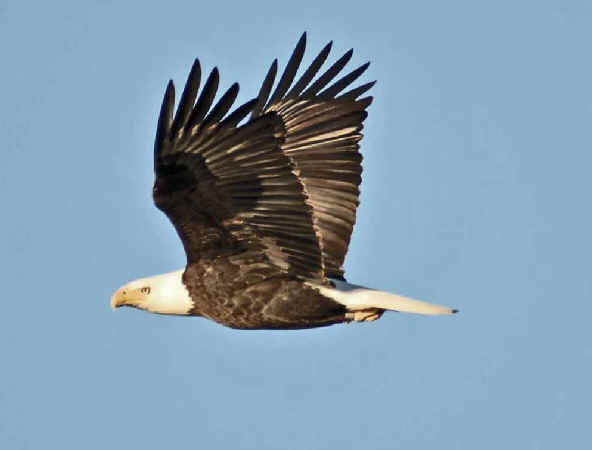
An adult Bald Eagle in flight
(photo by Howard Eskin)
- Sharp-shinned Hawk (ph) ______
DE bh
MD bw VA ch
Accipiter striatus
- Cooper's Hawk (ph) ______
DE
bh MD bw VA ch
Accipiter cooperii
- Northern Goshawk (r/DP) ______
DE MD bw(rare) VA
Accipiter gentilis
At the hawk watch at Kiptopeke, Cape Charles, Virginia, peak
counts for the Northern Goshawk were:
7 on November 12 and 7 on November 17, 1999. That year, there was the fall
season high for species there with 27.
- Red-shouldered Hawk (ph) ______
DE bh*
MD bw VA ch
Buteo l. lineatus

A juvenile Red-shouldered Hawk
(photo by Howard Eskin)
- Red-tailed Hawk (ph) ______
DE
bh* MD bw* VA ch*
Buteo jamaicensis borealis
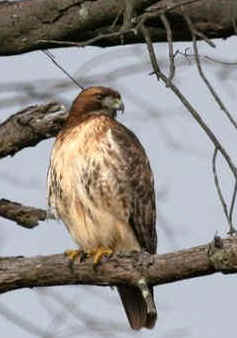
Red-tailed Hawk
(photo by Marie Gardner)
- Broad-winged Hawk ______
DE bh MD bw VA ch(rare)
Buteo platypterus
- Swainson's Hawk (r/DP) (ph) ______
DE MD VA ch(very rare)
Buteo swainsoni
Swainson's Hawks
were in Delaware: October 17, 2008, September 19, 2009, at
Cape Henlopen, October 16-29, 2010 at Cods Road (bird in the photo below),
April 23, 2011 at Little Neck Rd, September 11, 2011 at Ashland, and
September 30, 2011 at Cape Henlopen.
Swainson's Hawks in Maryland included these on: December 18,
2007 in Dorchester County at Hurlock, and September 15, 2012 in Dorchester
County at Swan Harbor.
The first Swainson's Hawk record for Virginia was on August
21, 1978 at Chincoteague Refuge. A winter record on the Virginia
Eastern Shore was at Cheriton, Northampton County, January 5, 1999.
Through 2005, there were 26 Swainson's Hawks at the hawk watch
Kiptopeke, with 12 of them after 2000. The fall season high for the species
was 8 in 1998.
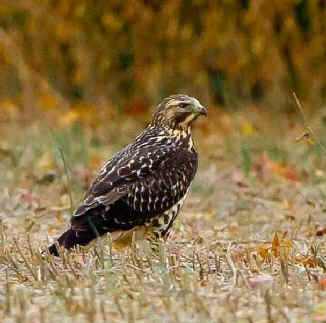
An immature Swainson's Hawk
photographed in southern Delaware, October 29, 2010
(photo by Howard Eskin)
- Rough-legged Hawk (ph) ______
DE
bh MD bw VA ch(rare)
Buteo lagopus
In Virginia, at the hawk watch at Kiptopeke, Cape Charles, there
were, from 1978 to 2003, 23 Rough-legged Hawks, with 14 of them in a
single year, 1999.
- Ferruginous Hawk (nt) (r/DP)
(ph) ______ VA
Buteo regalis
In Virginia, an immature Ferruginous Hawk was at the
Eastern Shore of Virginia Wildlife Refuge January 10 to March 6, 1995. That
bird ranged widely from Oyster in Northampton County south to Fisherman
Island.
- Northern Harrier (ph) ______
DE bh*
MD bw* VA ch*
Circus cyaneus hudsonius
The Northern Harrier was
conspecific with the Hen Harrier of Eurasia, Circus
cyaneus.
- Western Marsh Harrier (r/NA)
______ VA ch(very rare)
Circus aeruginosus
An adult female Western Marsh Harrier was at Chincoteague Refuge
in Virginia on December 4, 1994.
- Golden Eagle (u/DP) ______
DE bh(rare)
MD bw VA ch(very rare)
Aquila chrysaetos
During a census of wintering eagles (both Bald and
Golden) in Maryland in Dorchester County in the area of the
Blackwater Refuge, conducted on January 8, 2015, 1 adult and 2 immature Golden
Eagles were found.
The fall season high for Golden Eagle at the hawk watch at
Kiptopeke, Cape Charles, Virginia was 37 in 1995.
- Northern Crested Caracara (r/DP)
(ph) ______ DE
Caracara cheriway
The first Northern Crested Caracara in Delaware was in
Millville, in the southern part of the state, on March 8, 2013.
Previously, in the winter of 2012-2013, and a bit earlier, there had been
sightings of Northern Crested Caracaras in central and southern New Jersey
in Mercer, Burlington, Atlantic, Cape May, and Salem counties. In New
Jersey, there was more than one bird.
- American Kestrel (ph) ______ DE
bh* MD bw VA ch
Falco s. sparverius
- Merlin (ph) ______ DE
bh MD bw VA ch
Falco c. columbarius
- Peregrine Falcon (ph) ______
DE bh
MD bw VA ch*
Falco peregrinus
- Gyrfalcon (r/DP) (ph) ______
DE bh(very
rare) MD bw(very rare) VA
Falco rusticolus
Gyrfalcons
in Delaware have been: November 5, 1974 north of Wilmington at the
Brandywine Country Club,
October 18, 1977 at Bombay Hook Refuge, February 15, 2005 at Port Mahon, and
December 7, 2007 at the Delaware Seashore State Park.
A Gyrfalcon occurred at the hawk watch at Kiptopeke, Cape Charles, Virginia,
on October 21, 2000.
RAILS
- Clapper Rail (ph) ______ DE
bh* MD bw* VA ch*
Rallus crepitans (formerly R. longirostris)

Clapper Rail
(photo by Howard Eskin)
- King Rail ______ DE
bh* MD bw* VA ch
Rallus elegans
- Virginia Rail (ph) ______
DE bh*
MD bw* VA ch*
Rallus l. limicola

Virginia Rail
(photo by Howard Eskin)
- Black Rail (nt) ______ DE
bh* MD bw*(rare) VA
ch(rare)
Laterallus j. jamaicensis
Black Rails can be heard, and
with effort and luck seen, in certain places in Delaware and Maryland.
In Delaware, those places have been marshes with the appropriate habitat
by the Delaware Bay.
In Maryland, they have been by the Chesapeake Bay, where, again, the habitat
is appropriate. One such place in Maryland, over the years, has been Elliot
Island.
The following text, relating to Elliot Island, is paraphrased from the book
"Birds and Marshes of the Chesapeake Bay Country" by Brooke
Meanley, published in 1975, and reprinted in
1983.
During those decades, in the 1970s and 1980s, Elliot Island was a good,
reliable place for Black
Rails.
"The little Black Rail is the
most secretive bird in North America. One of the best places to HEAR one is
at Elliot Island in Maryland's Chesapeake Bay Country. Elliot lies between
Fishing Bay and the Nanticoke River, and is mostly salt and brackish marsh.
This diminutive rail, about the size of a sparrow, lives in the vast
salt-marsh meadow or savanna, a short-grass marsh studded with still-water
ponds or potholes.
It (that little bird) travels about inconspicuously (to put it
mildly) in the marsh grass. It rarely flies during the day.
Apparently it is more active at night for its call is heard almost
exclusively then.
Also, the bird does extensive migrations at night between its wintering and
breeding grounds.
Black Rails only occur at Elliot Island during the summer-half of the
year. They arrive in late April and are gone by September or October.
The period of calling extends from courtship through nesting season,
that is from the last week of April until the middle of July.
The salt-marsh meadow is not flooded by normal high tides, but it is soggy
most of the time. It has a firm bottom, enabling farmers in some sections to
harvest the "salt-marsh hay", as the salt grass and
salt-meadow cordgrass is locally known.
So dense is the windswept and matted-down meadow that to move about in it, Black
Rails often have to use the tunneled runways of the meadow mouse
or vole.
Most Black Rails call at night from small swallow depressions in the
marsh meadow that are covered sparsely with a broad-leaved type of cordgrass
(Spartina alterniflora or Spartina
cynosuroides).
At night, Black Rails usually begin calling between 9:00 and 10:00
pm, and continue until just before dawn.
Black Rails are very rarely seen during the
day.
For years, until the mid-20th Century, there was some confusion as to which rail
calls were being heard in the dark of night: the Black Rail, the
Yellow Rail, or the courtship call of the Virginia Rail.
In June 1958, I (referring to Brooke Meanley) participated in an
nocturnal expedition, at about midnight, trying a technique where 3 of us
walked abreast as we stalked a calling bird.
The man in the middle had a shotgun, and ones of each side held a
flashlight. When a rail began calling from a position of 20 or 30 feet in
front of us, the men holding the flashlights crossed the beams or
triangulated on the spot from which the calling seemed to come. Then the man
in the center would shoot at the spot where the beams crossed.
But a minute or so after each shot, the bird would start calling to our side
or behind.
After a half-dozen unsuccessful attempts at shooting the bird, I attempted
to stalk it and capture it by hand. Each time the bird called, I approached
the spot and often came within 3 or 4 feet, when it stopped calling and
moved a few yards away.
Finally, after a period of about 5 minutes of not hearing it, it began
calling close to me, and as I pointed my flashlight downward in the short
meadow grass, I could see the bird standing and calling right between my
feet! "
- Yellow Rail ______ DE
bh(rare)
MD VA
ch(rare)
Coturnicops noveboracensis
A Yellow Rail was in Maryland in Ocean City on November 25,
2012.
Yellow Rails were on the Eastern Shore of Virginia in
Northampton County: December 29, 1967, February 26, 1972, November 17, 1994,
November 13, 2004.
And at Assateague Island, Virginia: December 29, 1972, November 23,
1992.
And the Chesapeake Bay Bridge Tunnel: May 12, 1968, October 12, 1985,
October 4, 1989 (a specimen).
- Sora ______ DE
bh MD bw VA ch
Porzana carolina
- Corncrake (r/NA) (ph) ______
MD
Crex crex
The Corncrake is a European species that has greatly declined
during recent decades.
When it was more common in Europe than it is today, it occurred as a rarity
along the East Coast of North America in the fall.
Most recently, there have been occurrences on Briar Island, off Nova Scotia,
Canada on May 4 & 5, 1993 (the most recent) and on the island of
Saint-Pierre (in North America, off Canada, but part of France), on
October 22, 1989.
In the United States, one was on Long Island, New York, November 2,
1963.
Historical records in the United States (mostly prior to the 20th
Century) were in Maine, Rhode Island, Connecticut, New Jersey (in Salem in
1854 and in Dennisville in 1905), and Maryland (in what is now Stockton
in Worcester County in 1900).
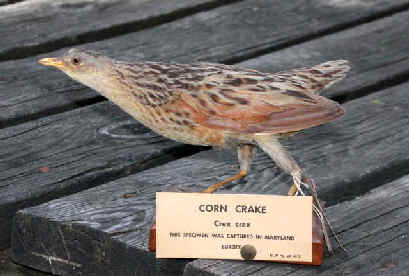
The specimen of the Corncrake, noted above, from 1900 in Maryland.
(photo courtesy of Rick Wiltrout)
- Purple Gallinule (r/DP) (ph) ______
DE bh* VA ch(rare)
Porphyrula martinica
In 1974, from May 18 to September 21, Purple Gallinules (from 1
to 3) were observed in the cattails of the Dragon Run Marsh in northern
Delaware.
Display behavior were seen that year on May 18 and July 18. Young birds were
seen on 3 occasions in the late summer.
Purple Gallinules returned to Dragon Run in 1975 and were seen there
regularly from May 18 to August 10.
3 or 4 birds were observed exhibiting nesting behavior on May 31. A nest
with 4 eggs was found on June 22.
Also in 1975, further south in Delaware, at Bombay Hook Refuge, a different
pair of Purple Gallinules with 3 young were seen on July 24.
The following year, in 1976, a Purple Gallinule was reported again at
Dragon Run, on April 18, but it did not stay to breed.
These Delaware breeding records so far north were unusual. As of
2000, there had been no recent breeding records for Maryland or Virginia.
There were 5 published occurrences of the species in Maryland from
1845 to
1953. After that, there were other Maryland records, but none on the
Delmarva Peninsula.
Included in the realm of this list, there was a Purple Gallinule in
Cecil County, Maryland on June 10, 2010 in the area of the Elk River
near Elkton.
Again, in northern Delaware, there was a Purple Gallinule on
July 2, 2012, staying a few days, at Grier's Pond, a few miles south of the
Dragon Run Marsh location (noted above).
Also in 2102, In southern Delaware, in Bethany Beach, there was
another Purple Gallinule on November 3. When found, it was injured,
and soon thereafter, it died.
In Virginia, Purple Gallinules were at Chincoteague Refuge:
July 28, 1973, July 13-14, 1974, June 25 to July 2, 1977, August 13-17,
1982, June 7-18, 1986, April 24, 1987, June 6, 1997, May 22,
1999.
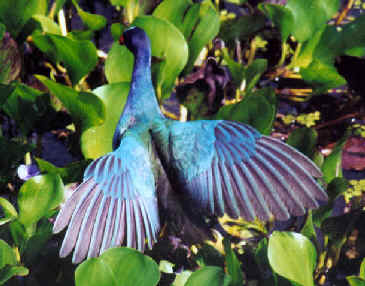
Purple Gallinule
(photo by Marie Gardner)
- Common Gallinule (u/DP) (ph) ______
DE bh*
MD bw VA ch
Gallinula galeata (formerly
chloropus)
- American Coot (ph) ______
DE
bh* MD bw VA ch
Fulica a. americana
- Sandhill Crane (u/DP) (ph) ______
DE bh(rare) VA
Grus canadensis
Sandhill Cranes have been in Delaware at: Bombay Hook
Wildlife Refuge from October 18, 1969 to April 1970, Bellevue State Park
north of Wilmington March 27, 1976, Prime Hook Wildlife Refuge May 3, 1986,
Woodland Beach Wildlife Area December 18 and 31, 1987, Prime Hook Wildlife
Area November 30, 1991.
More recently, occurrences of Sandhill Cranes in Delaware
have been increasing, as they have been in the northeastern United States.
One was in northern Delaware, near Glasgow, on April 28, 2012, and
another in central Delaware at the Bombay Hook Wildlife Refuge starting November 8, 2014.

The Sandhill Crane near Glasgow, Delaware
(photo by Marie Gardner)
SHOREBIRDS
- American Oystercatcher (ph) ______
DE
bh(rare) MD VA ch*
Haematopus p. palliatus
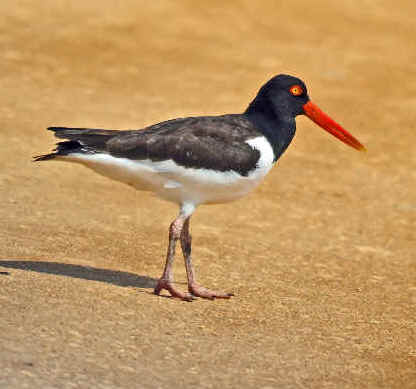
On a beach, an American Oystercatcher
(photo by Howard Eskin)
- Black-necked Stilt (ph) ______
DE bh*
MD bw
VA ch(rare)
Himantopus mexicanus
The Black-necked Stilt has been considered by some to be part of
the nearly-cosmopolitan Black-winged Stilt, Himantopus
himantopus.
Deal Island is a place in Maryland for the Black-necked
Stilt, a rare bird for the state.
- American Avocet (ph) ______
DE bh
MD bw(very rare)
VA ch
Recurvirostra americana (monotypic)
In Maryland, 5 American
Avocets were at Blackwater Wildlife Refuge on November 3, 2007.
- Northern Lapwing (r/NA) (ph) ______
DE bh(very
rare) MD
Vanellus vanellus
A Northern Lapwing was at Bombay Hook Refuge in Delaware
March 14-15, 1953.
Also at Bombay Hook Refuge, there were Northern Lapwings: July 6-7,
1996, December 26-28, 1999, and March 29, 2013.
In 2013, prior to that, there were multiple Northern Lapwings in New
England and elsewhere north of Delaware. 3 were together at one location in
central New Jersey.
On the Eastern Shore of Maryland, a Northern Lapwing was in
Cordova in Talbot County February 3 and 4, 2013.
- Southern Lapwing (r/NA) (ph)
______ MD
Vanellus chilensis
A Southern Lapwing was in West Ocean City, Maryland on
June 17, 2006 - the bird of unknown origin.
- Black-bellied Plover (ph) ______
DE
bh MD bw VA ch
Pluvialis squatarola cynosurae
Another name for Pluvialis
squatarola is the Grey Plover, especially in the Old
World.
- American Golden Plover (ph) ______
DE bh
MD bw(rare) VA ch
Pluvialis dominica (monotypic)
- European Golden Plover (r/NA)
(ph) ______ DE bh(very
rare)
Pluvialis apricaria
A bird said to be a European Golden Plover was found at Bombay Hook
Refuge in Delaware on July 25, 1989.
Another European Golden Plover was near Bombay Hook September 14-15,
2009.
- Pacific Golden Plover (r/DP)
(ph) ______ DE bh(very
rare)
Pluvialis fulva
A Pacific Golden Plover was in Delaware at Bombay Hook
Refuge July 25-27, 1989.
- Semipalmated Plover (ph) ______
DE bh
MD bw VA ch
Charadrius semipalmatus (monotypic)
- Piping Plover (t3) (ph) ______ DE
MD VA ch*
Charadrius melodus (monotypic)
- Wilson's Plover (u/DP) (ph) ______
DE MD VA ch*
Charadrius w. wilsonia
By the end of the 20th Century, the
northernmost breeding location for the Wilson's Plover was the Virginia
portion of the Delmarva Peninsula, on coastal islands, where, at that
time, some 50 pairs were said to nest.
The most recent Delaware occurrence of the Wilson's Plover was
in 1985, when there were sightings at two locations, neither of which
suggested breeding:
May 8 at Gravel Hill, and July 26 by Indian River Bay. Both were sightings
of single birds, and the Gravel Hill location was unusual as it was away
from the more normal coastal habitat for the species.
On the Eastern Shore of Maryland, a Wilson's Plover was said
to be at the Assateague Island National Seashore on July 19, 2008.
- Snowy Plover (r/DP) (ph)
______ VA
Charadrius nivosus
A Snowy Plover was on the Eastern Shore of Virginia, first
found in June 1995, at Cedar Island near Chincoteague.
In 1995, that bird was seen June 19 to 21. It was subsequently seen the
following 3 years: June 18, 1996, June 3, 1997, June 16, 1998.
It performed courtship displays for Piping Plovers, and made nest
scrapes on several occasions.
- Killdeer (ph) ______ DE
bh* MD bw* VA ch*
Charadrius v. vociferus
- Mountain Plover (r/DP) (ph)
______ VA ch(very
rare)
Charadrius montanus
A Mountain Plover was at Chincoteague Refuge in Virginia
October 16-17, 1976. It was photographed.
Previously along the East Coast of the US, a Mountain Plover was in
Massachusetts on October 28, 1916.
As reference, some of the Eurasian plovers are also quite plain in immature
or basic plumage, such as the Lesser Sand-Plover (formerly
called Mongolian Plover), the Oriental Plover, and the Eurasian
Dotterel.
The Lesser Sand Plover has occurred in New Jersey. An Oriental
Plover was collected in Greenland in 1946. And a Eurasian Dotterel
was in Bermuda in September
1991.
- Upland Sandpiper ______ DE
bh(rare)
MD bw(rare) VA
ch(rare)
Bartramia longicauda (monotypic, and
the single member of its genus)
- "American" Whimbrel
(ph) ______ DE bh(rare)
MD VA ch
Numenius phaeopus hudsonicus
"Eurasian" Whimbrel
(r/DP) (ph) ______ DE MD
VA ch(very rare)
Numenius phaeopus phaeopus
(or islandica)
A Whimbrel of one of the white-rumped Eurasian races (noted above) was
in Delaware from December 22, 1984 to January 6, 1985 at Holts
Landing near the seacoast.
There was a "Eurasian Whimbrel" in Maryland on April 24,
2009 at the Assateague Island National Seashore.
On the Eastern Shore of Virginia, there were "Eurasian
Whimbrel": at Mockhorn Island September 12, 1981, at Hog Island
April 17 to June 1, 1983, and July 6, 1984, at Chincoteague Refuge April 27,
1991, August 2, 2003, and at Willis Wharf, Northampton County May 21,
2005.
- Long-billed Curlew (nt) (r/DP)
(ph) ______ MD VA
Numenius americanus
Long-billed Curlews have been in Maryland:
June 12, 1976 at Deal Island, August 31, 2003 in Elkton (very close to the
DE-MD state line).
Prior to the 1976 record, the last occurrence of the species in Maryland was
in 1899.
Long-billed Curlews have been on the Eastern Shore of Virginia:
near Hog Island November 14, 2003 (with seemingly the same individual in the
early fall of 2004, and again from August 28, 2005 to April 2, 2006), also
Fisherman's Island October 10, 2005.
Although they were rare, Long-billed Curlews were formerly a more
common occurrence on the Delmarva
Peninsula.
- Eurasian Curlew (r/NA)
______ DE bh(very
rare)
Numenius arquata
A Eurasian Curlew was in Delaware at Bombay
Hook Refuge on October 20, 2003.
- Eskimo Curlew (now presumed
extinct) ______ MD
Numenius borealis
The was a sighting of a single Eskimo Curlew in Ocean City, Maryland
on September 15, 1913.
- Marbled Godwit (ph) ______
DE bh(rare)
MD bw(very rare) VA ch
Limosa f. fedoa
- Hudsonian Godwit (ph) ______
DE bh MD
bw(rare)
VA
ch
Limosa haemastica
- Black-tailed Godwit (r/NA) (ph) ______
DE VA ch(very rare)
Limosa limosa
Black-tailed Godwits
have been in Delaware:
October 19, 1987 near Woodland Beach, June 12-14, 1994 near Broadkill Beach,
July 20-21, 2012 near Prime Hook.
In Virginia, there was a Black-tailed Godwit at Chincoteague
Refuge August 11, 2012, and again March 11-14, 2013.
- Bar-tailed Godwit (r/DP) (ph)
______ VA ch(very
rare)
Limosa lapponica
Three times there have been Bar-tailed Godwits in Virginia,
and all three have been at Chincoteague, either on the refuge or by the
causeway (Queen Anne Sound): December 28, 1973, September 5-15, 1991, August
3-5, 2013.
The August 2013 bird was the European subspecies: Limosa
lapponica lapponica.
- Greater Yellowlegs ______ DE
bh MD bw VA ch
Tringa melanoleuca (monotypic)
- Lesser Yellowlegs (ph) ______
DE bh
MD bw VA ch
Tringa flavipes (monotypic)
- Common Redshank (r/DP) (ph)
______ DE bh(very
rare)
Tringa totanus
A Common Redshank was in Delaware at Bombay Hook Refuge
on August 19, 1992.
- Wood Sandpiper (r/NA) (ph)
______ DE
Tringa glareola
Wood Sandpipers have been in Delaware: July 2, 1996 at
the Little Creek Wildlife Area,
and in Sussex County
May 5-12, 2008.
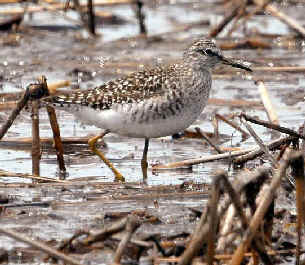
Wood Sandpiper, photographed in Delaware in May
2008
(photo by Howard Eskin)
- Solitary Sandpiper ______
DE bh MD bw VA ch
Tringa s. solitaria
- Spotted Sandpiper (ph) ______
DE bh
MD bw VA ch
Actitis macularius (monotypic)
- Willet (ph) ______ DE
bh* MD bw* VA ch*
Tringa
(formerly Catoptrophorus) s. semipalmatus

Willet
(photo by Howard Eskin)
- Ruddy Turnstone (ph) ______
DE bh
MD bw VA ch
Arenaria interpres morinella
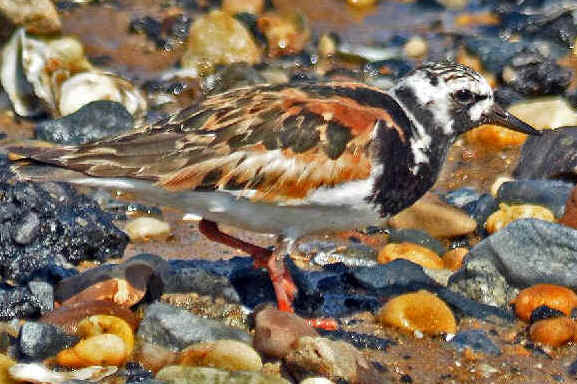
Even with its splash of orange coloring,
the breeding-plumaged Ruddy Turnstone can blend in
(photo by Howard Eskin)
- Red Knot (ph) ______ DE
bh MD bw(very rare) VA ch
Calidris canutus rufa
The subspecies of the Red Knot, that
migrates through the Delmarva Peninsula, and stages by the
Delaware Bay in the spring, is Calidris
canutus rufa.
When present on Delmarva in the spring, in May, the birds feed
to have the fuel that they need for the remainder of their long journey to
northern Canada where they nest.
Back in 1909, during his journey home from his discovery of the North
Pole, Admiral Peary found the first nest of a Red Knot
ever seen by man, in Grinnell Land, on northern Ellesmere Island.
Previous Arctic explorers, having observed Knots feeding by tundra
pools, mistakenly assumed the nests to be in the nearby grass. Rather, Knots
usually nest on high rock shale far from water, affording an ideal
camouflage.
During their non-breeding season, Red Knots, Calidris
canutus rufa, travel thousands of miles, going as far south
as Tierra del Fuego, in far-southern Argentina and
Chile.
For more about Calidris canutus rufa,
click the link here:
KNOTS AND OTHER SHOREBIRDS THAT STAGE
EACH SPRING BY THE DELAWARE BAY
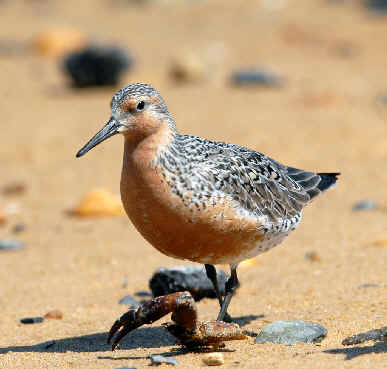
Red Knot
(photo by Howard Eskin)
- Sanderling (ph) ______ DE
bh MD bw VA ch
Calidris alba rubida
- Semipalmated Sandpiper (ph) ______
DE bh
MD bw VA ch
Calidris pusilla
(monotypic)
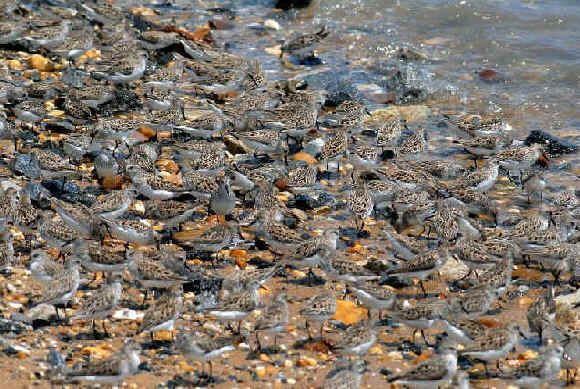
Above & below: A
flock of Semipalmated Sandpipers, in Delaware in May, by the Delaware
Bay
(photos by Howard Eskin)
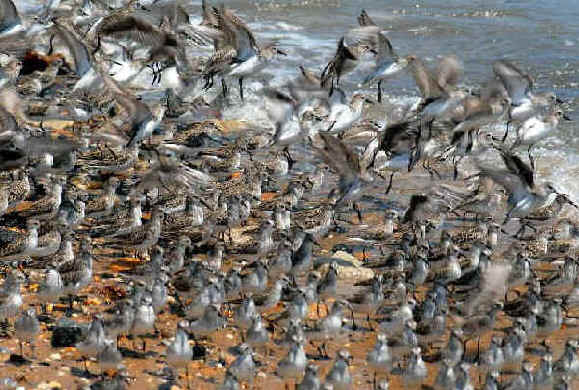
- Western Sandpiper (ph) ______
DE bh
MD bw VA ch
Calidris mauri (monotypic)
- Least Sandpiper (ph) ______
DE bh
MD bw VA ch
Calidris minutilla (monotypic)
- White-rumped Sandpiper (ph) ______
DE bh
MD bw VA ch
Calidris fuscicollis (monotypic)
- Baird's Sandpiper (ph) ______
DE bh(rare)
MD bw(very rare) VA ch
Calidris bairdii
- Red-necked Stint (r/DP) (ph) ______
DE bh(very rare) MD
Calidris ruficollis
Red-necked Stints
were in Delaware: July 25, 1984 and July 28, 1987 at Port
Mahon, May 10-14, 1994 near Woodland Beach, September 4, 2004 at Bombay Hook
Refuge.
Red-necked Stints in Maryland have included these: at Ocean City August 19, 1995 (West Ocean
City), August 4, 2007 (Skimmer Island)
- Little Stint (r/NA) ______
DE bh(very rare)
Calidris minuta
Little Stints
were in Delaware: at Port Mahon on August 11, 1985, at Bombay
Hook Refuge: July 7, 1996, August 11-12, 1996, August 2, 1997, July 4,
2005.
There may have been a Little Stint at Port Mahon on July 28, 1982,
but that record was not accepted.
- Pectoral Sandpiper (ph) ______
DE bh
MD bw VA ch
Calidris melanotos (monotypic)
- Sharp-tailed Sandpiper (r/NA) (ph)
______ DE bh
VA ch(very rare)
Calidris acuminata
A Sharp-tailed Sandpiper, in breeding plumage, was at Bombay Hook
Refuge in Delaware, August 8-19, 1993.
Also at Bombay Hook Refuge, there were Sharp-tailed Sandpipers: April
19, 1997, August 5-6, 2002, September 29, 2002.
Sharp-tailed Sandpipers on the Eastern Shore of Virginia were:
September 14, 1984 at Chincoteague Refuge, and September 4, 2003 at
Capeville, Northampton County.
- Purple Sandpiper (ph) ______
DE MD VA ch(rare)
Calidris maritima
- Dunlin (ph) ______ DE
bh MD bw VA ch
Calidris alpina hudsonia
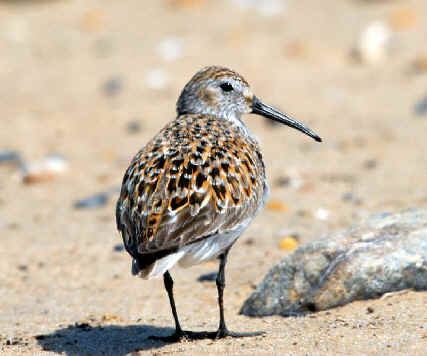
Above & below: the Dunlin
Sometimes in the fall and winter in Delaware, there can be large flocks of
them as
in the photo below.
(photos by Howard Eskin)

- Curlew Sandpiper (u/DP) (ph) ______
DE bh MD VA ch(rare)
Calidris ferruginea
(monotypic)
Since 1994, the Curlew Sandpiper has
occurred nearly annually in Delaware. .
In Maryland, August 9-21, 2004, there was a Curlew Sandpiper
at the Assateague State Park, near Berlin.
October 9-13, 2005 there was one in West Ocean City.
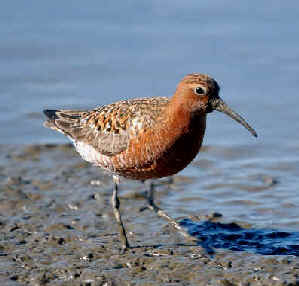
A Curlew Sandpiper in breeding plumage
(photo by Howard Eskin)
- Stilt Sandpiper (ph) ______
DE bh
MD bw VA ch
Calidris (formerly Micropalama) himantopus
- Ruff / Reeve (u/DP) (ph) ______
DE bh MD
bw(very rare)
VA ch(rare)
Philomachus pugnax (monotypic, and
the single member of its genus)
Ruffs and Reeves are
rare, but regular, on the Delmarva Peninsula. The species is
Eurasian.
It occurs on Delmarva mostly in the spring, as it heads north, from late
March to mid-May, and in July and early August as it heads south. It occurs
less commonly between the two migrations, from late May to July, and in
September and beyond (until November).
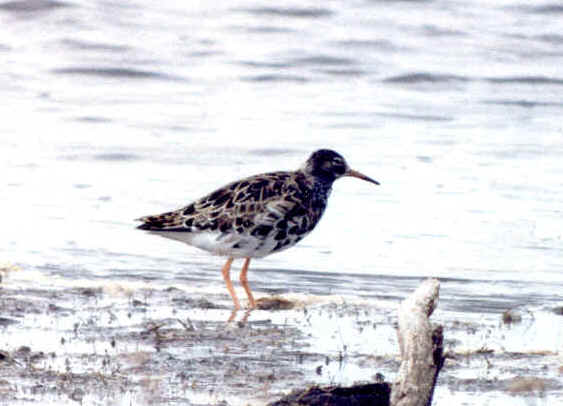
A Ruff photographed at Bombay Hook Refuge in
Delaware on July 30, 1994
(photo by Marie Gardner)
- Buff-breasted Sandpiper (nt) (ph) ______
DE bh(rare) MD
bw(very rare) VA ch
Tryngites subruficollis
(the single
member of its genus)
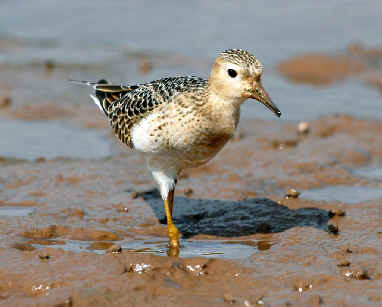
Buff-breasted Sandpiper
(photo by Howard Eskin)
- Short-billed Dowitcher (ph) ______
DE bh MD bw VA ch
Limnodromus griseus hendersoni

Short-billed Dowitcher
(photo by Howard Eskin)
- Long-billed Dowitcher (ph) ______
DE bh
MD bw VA ch
Limnodromus scolopaceus (monotypic)
- Wilson's Snipe (ph) ______
DE
bh MD bw VA ch
Gallinago delicata
- American Woodcock (ph) ______
DE
bh* MD bw* VA ch*
Scolopax minor
- Wilson's Phalarope ______ DE
bh MD bw(very rare) VA ch(rare)
Phalaropus (formerly Steganopus) tricolor
(monotypic)
- Red-necked Phalarope (p) (ph) ______
DE bh
MD bw(very rare)
VA ch
Phalaropus lobatus (monotypic)
15 Red-necked Phalaropes were
seen during a FONT pelagic trip offshore from Lewes, Delaware in June
2000.
Since 1994, the Red-necked Phalarope has occurred nearly annually in Delaware.
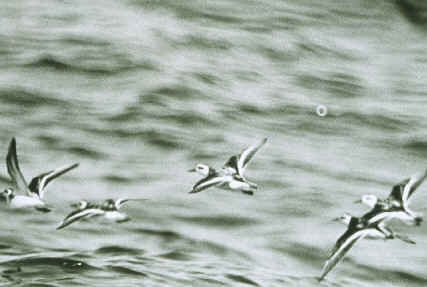
Red-necked Phalaropes at sea
(photo by Alan Brady)
- Red Phalarope (p) (u/DP) (ph) ______
DE bh(very
rare)
Phalaropus fulicaria
Red Phalaropes
have been in Delaware: November 12, 1977 at the Indian River Inlet,
July 26, 1996 at the Little Creek Wildlife Area, November 10, 2002 at Bombay
Hook Refuge, May 17, 2003 near Broadkill Beach, December 11, 2004 offshore
in DE waters, July 12, 2005 at Bombay Hook
Refuge.
JAEGERS, SKUAS
- Pomarine Jaeger (p) (ph) ______
DE MD VA ch(mostly
offshore)
Stercorarius pomarinus (monotypic)
Another name for Stercorarius
pomarinus
is Pomarine Skua,
especially in the Old World.
Pomarine Jaegers were seen during FONT pelagic trips offshore from Lewes,
Delaware in:
June 1998, June 2000 (7), June 2001 (1), June 2002 (2)
Related to certainly Pomarine and possibly Parasitic Jaegers,
and some other birds, in Delaware during Hurricane Sandy
in late October 2012, you may read what is in the insert below.
****************************************************************************************************************************
An excerpt from a Birdline narrative and a Cassinia
(DVOC) article by Armas Hill:
"Further south along the Delaware
River, in the state of Delaware, where the river widens at Delaware
City, some observers (on October 30, 2012) saw as many as 80 Pomarine
Jaegers. There were over 50 in one flock.
South of Delaware City, that same day, from 9:30am to 1:30pm, 68 Jaegers
were tallied, mostly Pomarine, some thought to be Parasitic.
There was a large group of 41 Jaegers at once.
Also seen there were some Common Terns and Brant.
Also near Delaware City, a Sandwich Tern was seen with a Laughing
Gull.
Further south in Delaware, along the coast of the Delaware Bay, from
Delaware City to Cedar Swamp, birds seen included: a Cave Swallow, a Northern
Gannet, a "dark-winged" tern, and Pomarine Jaegers.
More Pomarine Jaegers were reported at Fowler's Beach by the Delaware
Bay.
On October 31, in northern Delaware, away from the river, a Pomarine
Jaeger was seen flying by the Ashland Hawk Watch, heading
south."
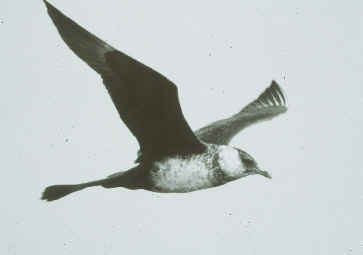
Pomarine Jaeger
(photo by Alan Brady)
For the complete narrative from which the above excerpt was
taken:
THE BIRDLINE, NOV 5, 2012:
UNUSUAL BIRDS WITH AN UNUSUAL STORM, HURRICANE SANDY
*******************************************************************************************************************************
- Parasitic Jaeger (p) (ph) ______
DE MD VA ch(rare)
Stercorarius parasiticus
(monotypic)
Another name for Stercorarius
parasiticus is Arctic Skua, especially in the Old
World.
3 Parasitic Jaegers were seen during a FONT pelagic trip offshore
from Lewes, Delaware in June 2000.
- Long-tailed Jaeger (p) (ph) ______ DE
VA ch(rare, mostly offshore)
Stercorarius longicaudus pallescens
Another name for Stercorarius
longicaudus is Long-tailed Skua, especially in the Old
World.
2 Long-tailed Jaegers were seen during a FONT pelagic trip
offshore from Lewes, Delaware in September 2000.
Another Long-tailed Jaeger sighting in Delaware offshore waters
was on August 26, 2005. One was seen from shore on November 5, 2005 at Cape
Henlopen.
In Maryland offshore waters, there were Long-tailed Jaegers on
September 28, 1991, August 18, 1996, September 3, 2000 (F), August
26, 2006
(F): seen during a FONT pelagic trip
Inshore on the Delmarva Peninsula, there was a Long-tailed
Jaeger on September 19, 2003 at Tilghman Island in Talbot County, Maryland.
- South Polar Skua (p) (ph) ______
DE
Stercorarius
(formerly Catharacta) maccormicki
(monotypic)
South Polar Skuas were seen during FONT pelagic trips offshore from
Lewes, Delaware in:
June 2000 (1), September 2000 (2), June 2001 (1)
Other South Polar Skua sightings in Delaware offshore waters:
May 30, 1999 and August 26, 2006.
- Great Skua (p) (r/DPwaters) (ph) ______
DE
Stercorarius (formerly Catharacta) skua (monotypic)
Great Skuas were seen in Delaware offshore waters: December 1,
1991, February 19, 1995.
GULLS
- Laughing Gull (p) (ph) ______
DE bh
MD bw VA ch*
Leucophaeus (formerly Larus) atricilla megalopterus
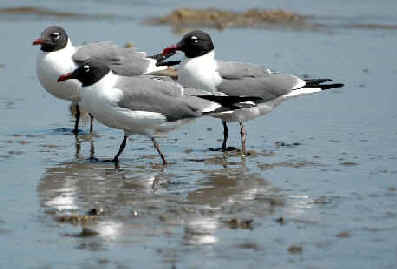
Laughing Gulls
(photo by Howard Eskin)
- Franklin's Gull (r/DP) (ph) ______
DE bh(very rare) MD
VA
Leucophaeus
(formerly Larus) pipixcan
Franklin's Gulls were in Delaware: September
1015, 1991 at Bombay Hook Refuge, July 9, 1995 at Pickering beach, July
20-27, 1996 at Port Mahon, November 21, 1998 at the Port of Wilmington, July
22-23, 2000 at Port Mahon, October 5, 2003 at Bombay Hook Refuge, October
12, 2003 near Broadkill Beach, June 26, 2004 at Port Mahon, October 18, 2004
at Cherry Island Landfill, July 30, 2005 at Bombay Hook Refuge, July 4, 2007
at Pickering Beach, September 4, 2011 near Bombay Hook, December 17, 2011 at
Cherry Island Landfill.
Franklin's Gulls on the Maryland Eastern Shore have included these on: October 11, 1991 at Ocean
City, December 10, 2005 at Salisbury at the Newland Park
Landfill.
Franklin's Gulls on the Virginia Eastern Shore have included
these on: March 14, 1995 at Assateague Island (in VA), and December 16, 1998
at the Chesapeake Bay Bridge Tunnel.
- Little Gull (u/DP) (ph) ______
DE MD VA ch(rare)
Hydrocoloeus
(formerly Larus) minutus
Since 1994, the Little Gull has occurred nearly
annually in Delaware.
The Little Gull was first recorded in Virginia at the
Chesapeake Bay Bridge Tunnel on December 5, 1964. In recent years, highest
numbers on the Eastern Shore of Virginia have been associated with Bonaparte's
Gulls near the mouth of the Chesapeake Bay. Numbers have declined in the
past 15 to 20 years, a trend also noted a place known for the species.
further north, the Niagara Rover Gorge in New York and Ontario.
Some occurrences of the Little Gull on the Virginia Eastern
Shore have been: at Chincoteague Wildlife Refuge (1 to 3 birds) August 24 to
September 24, 1972. and 1 bird August 8 to 27, 1974. Also at Fisherman
Island December 26, 1982, and at the Chesapeake Bay Bridge Tunnel August 15,
1983.
Most occurrences of the Little Gull on the Eastern Shore of Virginia
and elsewhere on the Delmarva Peninsula have been from the fall
through spring.
- Bonaparte's Gull (*) (ph) ______
DE bh MD bw
VA ch
Chroicocephalus (formerly Larus) philadelphia
(monotypic)
- Black-headed Gull (u/DP) (ph) ______
DE bh(very
rare)
VA ch(rare)
Chroicocephalus
(formerly Larus) ridibundus
Since 1994, the Black-headed Gull has occurred nearly
annually in Delaware.
- Ring-billed Gull (ph) ______
DE bh MD bw
VA ch
Larus delawarensis (monotypic)
- "American" Herring Gull (p) ______
DE bh MD bw
VA ch
Larus argentatus smithsonianus
Larus argentatus has been considered
conspecific with the Herring
Gulls of
Europe, L. a. argenteus & L. a. argentatus,
and with the Vega
Gull of
eastern Asia, L. vegae.
- Great Black-backed Gull (ph) ______
DE bh MD bw
VA ch
Larus marinus (monotypic)
- Lesser Black-backed Gull (p) (u/DP) (ph)
______ DE bh
MD bw VA ch
Larus fuscus graellsii
A Lesser Black-backed Gull was seen during a FONT pelagic trip
offshore from Lewes, Delaware in June 2001.
In Maryland, the first record of a Lesser Black-backed Gull was
on October 7, 1948 at the Assateague Island National Seashore just north of
the VA-MD state line.
The first specimen of a Lesser Black-backed Gull in North
America was first seen at the Chincoteague Wildlife Refuge in Virginia
on October 7, 1948. That bird flew across the state line to Maryland where,
as noted above, it was collected.
The first sight record, by the way, of a Lesser Black-backed Gull
in North America was not far north of the Delmarva Peninsula, in New
Jersey on September 9, 1934.
Numbers of Lesser Black-backed Gulls in the eastern United States,
in the winter, have increased steadily since the mid
1970s.
- Glaucous Gull (u/DP) (ph) ______
DE MD VA ch(rare)
Larus hyperboreus leuceretes
There was a Glaucous Gull in Delaware on January 3, 1994
at Gordon Pond. On January 17, 1996, there was one at the Port of
Wilmington.
Since then, the Glaucous Gull has occurred nearly annually in Delaware.
In coastal Virginia, the Glaucous Gull has been recorded
annually since 1971, except during one year, 1977.
Occurrences on the Eastern Shore of Virginia during the summer have
been: at Hog Island August 7, 1961, at Chincoteague Wildlife Refuge August
22, 1974, and at Cape Charles July 1,
1984.
- Iceland Gull (u/DP) (ph) ______
DE MD VA ch(rare)
Larus glaucoides kumlieni
Since 1994 (and maybe previously), the Iceland Gull has occurred
nearly annually in Delaware.
- Thayer's Gull (r/DP) ______
DE
Larus thayeri
Birds said to be Thayer's Gulls have been in Delaware: May
9, 1981 at Cape Henlopen, February 15 and November 23, 2002, March 1, 2003,
March 20, 2004 at the Cherry Island Landfill, February 8, 2008 at Port
Mahon, December 30, 2010 at the Cherry Island Landfill.
- Mew Gull (r/DP) ______
DE VA
Larus canus
The Mew Gull of western North America is called the Common
Gull in Eurasia.
The Mew Gull has been in Delaware: April 13, 1978 un Kenton,
February 15, 2002 at the Cherry Island Landfill.
In Virginia, Mew Gulls were at the Chesapeake Bay Bridge Tunnel:
December 26, 2001, December 19, 2002.
The 2001 bird was the nominate subspecies, the Common Gull, that
breeds in northern Europe.
The 2002 bird was the subspecies L. c.
brachyrhynchus, that breeds in western North
America.
- California Gull (r/DP) (ph)
______ DE MD
Larus californicus
The California Gull has been in Delaware: June 24. 1995 at
Port Mahon, March 6, 1996 at the Port of Wilmington, December 28, 2002 at
the Indian River Inlet.
On the Eastern Shore of Maryland, adult California Gulls were in: West Ocean City
November 28, 1994, and Poplar Island in Sherwood, Talbot County November 26,
2001.
On the Eastern Shore of Virginia, California Gulls were: at the
Chesapeake Bay Bridge Tunnel March 16, 1991, January 3, 1992, December 26,
1996 (during the Christmas Count), March 10, 1999, February 12, 2002,
December 25, 2002.
One was at Kiptopeke December 30, 2002.
- Yellow-legged Gull (r/NA) (ph)
______ DE MD
Larus cachinnaris
A Yellow-legged Gull was in Delaware on March 13, 2002 at
the Cherry Island Landfill.
In Maryland, there was an adult Yellow-legged Gull in
Cambridge on November 13, 2009.
- Black-tailed Gull (r/NA) (ph)
______ MD VA
Larus crassirostris
A Black-tailed Gull was in Maryland at the Assateague
Island National Seashore October 7-15, 2000. It was a third-winter bird.
In Virginia, Black-tailed Gulls were at the Chesapeake Bay Bridge
Tunnel: from December 27, 1996 to March 20, 1997, from December 13, 1997 to
March 24, 1998, December 8, 1998 to March 13, 1999.
2 birds were at the CBBT from December 31, 1998 to January 10, 1999.
Presumably 1 of them was at Fisherman Island December 27, 1998 on the Cape
Charles Christmas Count.
Also at the Chesapeake Bay Bridge Tunnel: December 26, 1999 to January 15,
2000.
- Sabine's Gull (p) (r/DP) (ph) ______
DE MD VA ch(very rare)
Xema sabini
Sabine's Gulls were in Delaware: May 16, 1983 and October 7, 2006 at Cape
Henlopen, and May 20-23, 2012 at Mispillion Harbor.
And in Delaware offshore waters on August 26,2006.
Sabine's Gulls in Maryland have included this one:
on May 25, 2010 at Tilghman
Island in Talbot County
And in Maryland offshore waters: May 9, 1976, September 6,
2012
On the Eastern Shore of Virginia, Sabine's Gulls were: at the
Chesapeake Bay Bridge Tunnel June 20-22, 1968, Chincoteague Refuge May 19,
1979, September 1, 1983, and at the Chesapeake Bay Bridge Tunnel December 9,
2001.
- Ivory Gull (r/DP) (ph) ______
DE
Pagophila eburnea
An Ivory Gull was in Delaware on February 21,
1969 at Cape Henlopen.
- Ross' Gull (r/DP) (ph) ______
DE (MD:
not on Delmarva)
Rhodostethia rosea
A Ross' Gull was in Delaware in the area of the Indian
River Inlet November 16-29, 1996.
In Maryland, not on the Delmarva Peninsula, there was a famous
Ross' Gull was in Baltimore May 3 to April 24, 1990, at a sewerage
treatment plant that became a very popular spot for birders from near and
far.
- Black-legged Kittiwake (p) (u/DP) (ph)
______ DE(mostly offshore) MD(mostly
offshore) VA(mostly offshore)
Rissa tridactyla
Inshore, in Maryland, there was a Black-legged Kittiwake
at Bellevue in Talbot County October 9, 1988.
TERNS, SKIMMER
- Gull-billed Tern (ph) ______
DE bh
MD bw(rare) VA ch
Gelochelidon
(formerly Sterna) nilotica aranea
Gull-billed Terns have been in
Maryland: August 18, 1968 at Blackwater Wildlife Refuge (3 birds),
August 6, 1989 and August 15, 2004 at the Hurlock Wastewater Treatment Plant
(2 adults in 1989, 4 birds in 2004),
In Maryland, others have been along the coast in Worcester County,
and in some Chesapeake Bay tributaries.
- Caspian Tern (ph) ______ DE
bh MD bw VA ch
Hydroprogne (formerly Sterna) caspia
- Royal Tern (p) (ph) ______
DE bh
MD bw VA ch
Thalasseus
(formerly Sterna) m. maxima
Royal Terns were seen during FONT
pelagic trips offshore from Lewes, Delaware in:
June 1998, June 2000 (12), June 2001 (12), June 2002 (6)
- Sandwich Tern (p) (ph) ______
DE MD VA ch
Thalasseus
(formerly Sterna)
sandvicensis acuflavida
Since 1998, the Sandwich Tern has
occurred nearly annually in Delaware.
- Elegant Tern (r/DP) (ph)
______ VA ch(very rare)
Thalasseus
(formerly Sterna) elegans
Elegant Terns
were in the area of Chincoteague, Virginia: on the refuge June 10,
1985, September 5-16, 2001, and by the causeway to Chincoteague (Queen Anne
Sound) on August 4, 2004.
- Common Tern (p) ______ DE
bh(rare) MD bw VA ch*
Sterna h. hirundo
Common Terns were seen during FONT
pelagic trips offshore from Lewes, Delaware in:
June 2000 (25), June 2001 (7), June
2002 (6)
- Arctic Tern (p) (u/DP) (ph) ______
DE MD VA ch(rare)
Sterna paradisaea (monotypic)
Arctic Terns have been seen in
Delaware: May 30, 1977, May 27, 1978 at Cape Henlopen, July 15, 1996
from the Lewes Ferry, June 7, 1997 at Cape Henlopen, May 20, 2001 at the
Indian River Inlet, July 27, 2002 at Cape Henlopen, June 2, 2010 at Fowler
Beach.
And in Delaware offshore waters on August 27, 2004 and August 25,
2006.
In Maryland offshore waters, there was an Arctic Tern on
August 1, 1992. And possibly others since.
- Forster's Tern (ph) ______
DE bh*
MD bw VA ch*
Sterna forsteri
(monotypic)
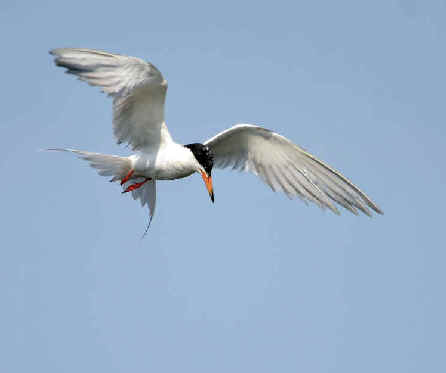
Above and below: Forster's Terns
Above, breeding plumage; below, non-breeding
(both photos by Howard Eskin)
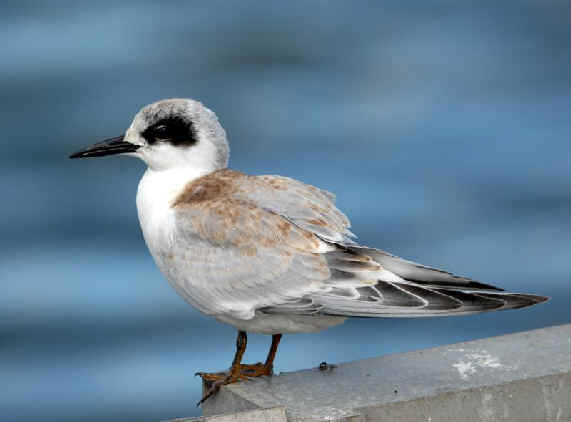
Forster's Tern
(photo by Howard Eskin)
- Roseate Tern (u/DP) (ph) ______
DE MD bw(very rare)
VA ch(rare)
Sterna dougallii
The population of the Roseate Tern in eastern North America, in the
subspecies Sterna
dougallii dougallii, has been classified as endangered.
Roseate Terns have been in Delaware: May 30, 1977, June 8, 1997,
May 31 and June 30, 2002 at Cape Henlopen, April 30, 2003 at the Indian
River Inlet, June 7, 2004 at Cape Henlopen, July 9, 2004 at Gordon Pond, May
24, 2005 at the Indian River Inlet, September 1-2, 2006 at Cape Henlopen.
Roseate Terns in Maryland have included these on: June 18, 1991 at the
Ocean City Inlet, June 7-8, 1992, June 18-25, 1994, and May 26, 1999 at
Skimmer Island in Ocean City.
- Least Tern ______
DE bh MD bw VA ch*
Sternula
(formerly Sterna) a. antillarum
- Bridled Tern (p) (u/DP) (ph) ______
DE(offshore) MD(mostly
offshore)
Onychoprion
(formerly Sterna) anaethetus melanoptera
Offshore (pelagic) sightings of Bridled Terns in Delaware
waters have included those on:
August 22, 1993, September 6, 1997, June 19, 1999 (F), June 4, 2000 (F:
1 bird), September
3, 2000 (F: 15 birds)
(F): seen during FONT pelagic trips from Lewes, Delaware
In Maryland, onshore, a Bridled Tern was in Salisbury - Mount
Hermon, on September 12, 1960.
Offshore, in Maryland waters, there have been sightings of Bridled
Terns on: September 26, 1976, June 7, 1986, and since.

Bridled Tern
(photo by Alan Brady)
- Sooty Tern (u/DP, mostly with
tropical storms) (ph)
______ DE MD VA
Onychoprion (formerly Sterna) fuscata
Sightings of Sooty Terns in Delaware have usually been with
tropical storms coming north along the seacoast.
On such occasions, the species has been over the Delaware River miles
inland.
Sooty Terns have been seen in Delaware:
June 26, 1976 at South Dewey Beach, September 9, 1979 at Wilmington,
September 7, 1996 from the Cape May-Lewes Ferry, August 31, 2000 at Cape
Henlopen, September 6, 2008 near Broadkill Beach, September 28, 2011 at
Fowler Beach.
Relating to dates above:
September 7, 1996 was after Tropical Storm Fran, September 6, 2008
was with Tropical Storm Hanna, August 28, 2011 was after Hurricane
Irene.
In Maryland, on September 12, 1960, at Salisbury (Mount Herman),
there were at least 80 Sooty Terns, with all of them adults except
for one immature bird.
Also in Maryland, there were Sooty Terns: October 21, 1979 at
Poplar Island in Sherwood, Talbot County (one adult), August 5, 1995 at
Ocean City (an adult female), July 21, 1996 at Smith Island in the
Chesapeake Bay, September 7, 1996 at Sherwood and in Bellevue in Talbot
County (adults and an immature), September 19, 1999 at Ocean City (an
immature bird), September 9, 2004 at the Assateague State Park near Berlin
(an immature bird), September 2, 2006 at Tilghman Island in Talbot County (2
birds).
Relating to dates above: September 12, 1960 with Hurricane Donna,
August 5, 1995 with Hurricane Erin, September 7, 1996 after Tropical
Storm Fran, September 19, 1999 after Hurricane Floyd, September 2,
2006 with Hurricane Ernesto.
On the Eastern Shore of Virginia, and offshore, occurrences of Sooty
Terns were: an adult offshore 55 miles east of Wachapreague Inlet July 22,
1978, 1 at Fisherman Island July 17,1971 a day with strong easterly winds, 2
there on August 28, 1971 were with Hurricane Doria, and about 110 birds
(98 adults and 12 juveniles) were offshore about 135 miles east of the Virginia
capes September 11, 1979 with Hurricane David.
That storm brought many Sooty Terns ashore, September 5-8, 1979, with
some alive and some dead. Among them: 3 at Nassawadox in Northampton County, 7
at the Chesapeake Bay Bridge Tunnel (all dead), 2 at Fisherman Island (dead).
Later single birds were found dead at Chincoteague Wildlife Refuge November 17.
1979 and February 17, 1980, and at Myrtle Island December 30, 1979.
Other Eastern Shore of Virginia occurrences of Sooty Terns were at
Ship Shoal Island in Accomack County June 17, 1985 a day with strong easterly
winds, 1 offshore from Assateague Island June 13, 1987, 1 at the Chesapeake Bay
Bridge Tunnel August 19, 1991 with Hurricane Bob, and another on a day
with strong easterly winds at Little Cobb Island, Northampton County June 23,
1993,
1 was at the Chesapeake Bay Bridge Tunnel July 13, 1996 with Hurricane
Bertha, 11 there at the CBBT September 6, 1996, and 7 the next day, with Tropical
Storm Fran.
3 Sooty Terns were at the Chesapeake Bay Bridge Tunnel August 27, 1998
with Hurricane Bonnie, as were 3 there at the CBBT August 28, 1998.
1 found dead at Myrtle Island, Northampton County, May 29, 1988 was not
apparently related to weather.
1 was at the Eastern Shore of Virginia Wildlife Refuge August 30, 1999 with Hurricane
Dennis, 7 at Sunset Beach in Northampton County September 28, 2003 with Hurricane
Isabel, as was one at the Chesapeake Bay Bridge Tunnel September 19,
2003.
Relating to dates above: August 2, 1971 with Hurricane Doria, September
11, 1979 with Hurricane David, August 19, 1991 with Hurricane Bob,
July 13, 1996 with Hurricane Bertha, September 6 and 7, 1996 with Tropical
Storm Fran, August 27 and 28, 1998 with Hurricane Bonnie,
August 30, 1999 with Hurricane Dennis, September 28, 2003 with Hurricane
Isabel.
- Black Tern (p) (ph) ______
DE bh
MD bw VA ch
Chlidonias niger surinamensis
Black Terns (4) were seen
during a FONT pelagic trip offshore from Lewes, Delaware in September
2000.
- White-winged Tern (r/NA) (ph) ______
DE bh(very
rare) VA ch(very rare)
Chlidonias leucopterus
The White-winged Tern is a Eurasian species. In North America, it
occurred as a rarity along the East Coast, in the area of the Great Lakes,
and once further north at Churchill, and along the West Coast, from Alaska
to California.
Along the East Coast, there were, in the 1970s, 1980s, and 1990s, a
number of occurrences in Delaware:
in Jul-Sep 1974, Jul 1978, the summer of 1988, and Jul-Sep 1993. In 1993,
there were at least 2 birds present.
All of the above birds in Delaware were in the same area of
marshes (from Port Mahon to Little Creek).
Additional occurrences of White-winged Terns in Delaware have
been: May 22 to August 19, 1995 at Bombay Hook Refuge, April 27-30, 2008 at
the Ted Harvey Wildlife Area.
Elsewhere in the East, the White-winged Tern has been in New
Jersey (in 1989) and Virginia (in 2002).
In all, as of 2014, there have been from 20 to 30 records of the White-winged
Tern in eastern North America.
Occurrences of the White-winged Tern on the Eastern Shore of Virginia
are these, all at Chincoteague Refuge: May 16 to early August 1963, May 9 to
August 1964, May 8-30, 1965, July 7 to September 17, 1974, July 10 to August
17, 1975 with also 2 birds present August 25-27in 1975, July 7-13, 1980,
September 6-9, 2002.
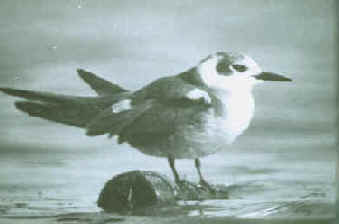
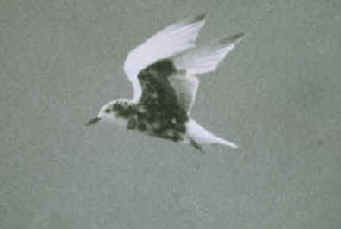
Two photographs of
a White-winged Tern, taken in Delaware.
(photos by Alan
Brady)
- Whiskered Tern (r/NA) (ph) ______
DE
Chlidonias hybridus
The Whiskered Tern is a bird of the Old World, where it is
widespread.
The first Whiskered Tern in North America was seen in Delaware
(and photographed there) in July 1993.
Presumably that same bird had been across the Delaware Bay at Cape May,
New Jersey from Jun 30 to Jul 17.
It was found central Delaware (at the Ted Harvey Wildlife Area) on
Jul 19 where it remained until probably Aug 24, ranging north a few miles to
the area of Pickering Beach and the Little Creek Wildlife
Area.
- Brown Noddy (p) (r/DP)
______ VA
Anous stolidus
In Virginia, a Brown Noddy was seen at the Chesapeake Bay
Bridge Tunnel on September 2, 2006, with Hurricane Ernesto.
- Black Skimmer (ph) ______
DE bh
MD bw(very rare) VA ch*
Rynchops n. niger
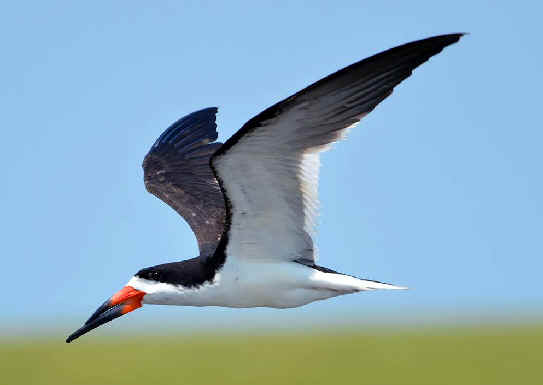
Black Skimmer
(photo by Howard Eskin)
ALCIDS
- Dovekie (u/DP) ______ MD(mostly
offshore) VA(mostly offshore) ch(rare)
Alle alle
Inshore, there were Dovekies in Maryland at Cambridge in
Dorchester County on December 15, 1952, and a t Fruitland in Wicomico County
on December 9, 1972.
- Common Murre (p) (u/DP) ______ DE
MD VA(mostly offshore, rare)
Uria aalge
Common Murres
were seen in Delaware offshore waters: February 15, 1993,
February 28, 2005, February 25, 2007, February 5, 2011.
In Maryland, from shore, there were Common Murres: December
29-31, 1976, April 12, 2009 in Ocean City.
And in Maryland offshore waters: January 16, 1977, March 12, 1994,
February 25, 1995, February 18, 1996, March 15, 2003, April 3,
2004
- Thick-billed Murre (p) (u/DP) (ph) ______
DE MD VA ch(very rare)
Uria lomvia
Thick-billed Murres
were seen in Delaware: March 1, 1987 at Bethany Beach, February
2, 2005 at Cape Henlopen.
And in Delaware offshore waters on March 15, 2003.
Thick-billed Murres were seen in Maryland: January 9, 1977 at
the Assateague Island National Seashore, February 17 to March 3, 2007 at
Ocean City.
And in Maryland offshore waters: February 26, 1995 (more than 1 bird,
but 1 in breeding plumage), November 6, 1999.
A Thick-billed Murre was at Chincoteague Refuge, Virginia
February 22, 1991.
- Razorbill (p) (ph) ______
DE MD VA
Alca torda
- Black Guillemot (r/DP) ______
DE
Cepphus grylle
Black Guillemots have been in Delaware: December 28,
2003 at Cape Henlopen, January 29 to February 7, 2005 at the Indian
River Inlet.
- Atlantic Puffin (p) (u/DP) ______
DE(offshore) VA(offshore)
ch(rare)
Fratercula a. arctica
Offshore (pelagic) sightings
of Atlantic Puffins in Delaware waters have included those on:
February 16, 1997, May 30, 1999, June 2000 (F: 3 birds)
(F): seen during a FONT pelagic trip from Lewes, Delaware
In Maryland offshore waters, there were 2 Atlantic Puffins
March 16, 1975.
DOVES
- Feral Pigeon (i) ______ DE
bh* MD bw* VA ch
Columba livia
- Mourning Dove ______ DE
bh* MD bw* VA ch*
Zenaida macroura carolinensis
- White-winged Dove (r/DP) (ph)
______ DE VA ch(very rare)
Zenaida asiatica
White-winged Doves have been in Delaware: June 11,
1998 at Cape Henlopen, May 23, 2015 at Slaughter Beach.
Among White-winged Doves on the Eastern Shore of Virginia:
east of Kiptopeke May 11-12, 2003, at Cape Charles May 10-13, 2006.
- Eurasian Collared Dove (i) ______
DE MD
Streptopelia d. decaocto
The Eurasian Collared Dove
has been in recent years in Selbyville, Delaware, a town on the
state's border with Maryland.
The species was noted there August 10-16, 1998, and from May 18, 2001 to
February 23, 2002, and was still there May 4, 2012.
But in January 2014, only one Eurasian Collared Dove was found in
Selbyville.
In Maryland, Eurasian Collared Doves have included these:
at the Assateague Island National Seashore October 13, 2002, in Berlin at
South Point April 19 to May 3, 2006, at Fishing Creek/Hooper Island from
November 19, 2006 to January 21, 2007, at Blackwater Wildlife Refuge August
19, 2007, in Berlin at South Point November 10, 2007 to November 9, 2008, at
Pocomoke 2 birds March 5, 2009 to May 30, 2009 and April 2-20, 2010, in
Newark (MD) May 29, 2010, in Cecilton February 28, 2011, at Snow Hill May
29. 2011, at the Assateague Island National Seashore August 9, 2011 and
September 11, 2011.
- Common Ground Dove (r/DP) (ph)
______ DE VA ch(very rare)
Columbina passerina
A Common Ground Dove was in Delaware from
October 1979 to January 1980 near Pickering Beach.
On the Eastern Shore of Virginia, Common Ground Doves were: at the
Chesapeake Bay Bridge Tunnel October 13, 1980, on the Chincoteague Christmas
Count December 29, 1983, on the Chesapeake Bay Bridge Tunnel by the south
toll plaza July 13, 1996 with Hurricane Bertha, and at Cape Charles December
1, 2004.
In the past, the Common Ground Dove occurred more often in Virginia,
but the population of the species in the southeastern US has declined
steadily since the 1970s.
CUCKOOS
- Yellow-billed Cuckoo (ph) ______
DE bh*
MD bw* VA ch*
Coccyzus americanus (monotypic)
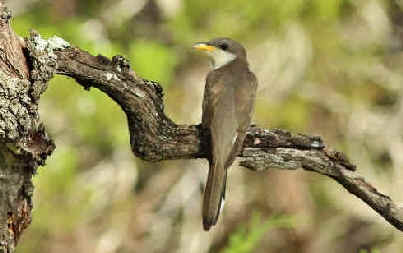
Yellow-billed Cuckoo
(photo by Rhett Poppe)
- Black-billed Cuckoo ______ DE
bh* MD bw VA ch*
Coccyzus erythropthalmus
- Groove-billed Ani (u/NA normally
in south Texas) (r/DP) ______ MD
Crotophaga sulcirostris
A Groove-billed Ani was in Maryland on November 3, 1975 in
Kent County at the Millington Turf Farm.
OWLS
- American Barn Owl (ph) ______
DE bh*
MD bw* VA ch*
Tyto furcata
The American Barn Owl has
been part of the Barn Owl of Eurasian and Africa, Tyto
alba.
But Tyto furcata is a heavier
bird, with a larger and stouter head and body, and much more powerful
talons.

An American Barn Owl (when it was called just
the "Barn Owl"),
back in the 1980s, in an old industrial building in Wilmington, Delaware.
Today, that old building is gone (replaced by "Riverfront
development"),
and now Barn Owls no longer occur in the city, or nearby.
(photo by Armas Hill)
- Eastern Screech Owl (ph) ______
DE bh*
MD bw* VA ch*
Megascops
(formerly Otus) a. asio
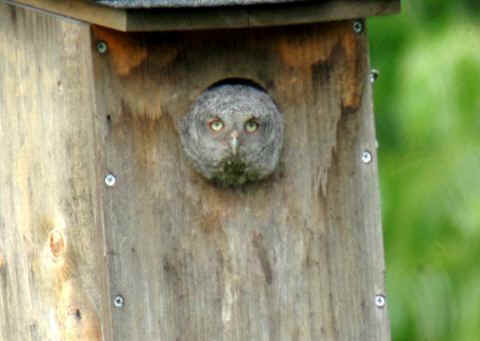
A young Eastern Screech Owl
(photo by Howard Eskin)
- Great Horned Owl (ph) ______
DE bh*
MD bw* VA ch*
Bubo v. virginianus
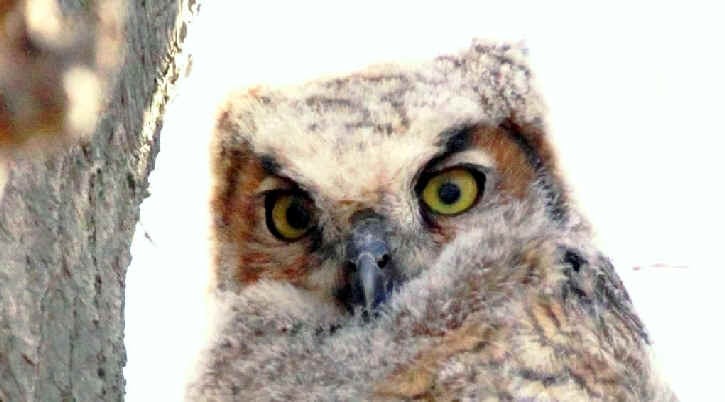
A young Great Horned Owl, photographed in the month of April,
at Bombay Hook Refuge in Delaware
(photo by Marie Gardner)
- Snowy Owl (ph) ______ DE
bh(rare) MD bw(very rare)
VA ch(rare)
Bubo
(formerly Nyctea) scandiaca
Snowy Owls have been in Delaware: March 21,
1992 at Beach Plum Island, December 2, 1992 near Bombay Hook Refuge,
December 18, 1993 and December 23, 1994 at Cape Henlopen, December 25, 1994
near Broadkill Beach.
In November and December 2013, there was a massive invasion of Snowy Owls
in eastern North America, with single birds as far south as Florida and the
Bahamas.
By December 1, in Delaware, there were 5 known Snowy Owls,
with 2 near Indian River Inlet, 1 at Port Mahon, 1 south of Port Penn, and 1
at Bombay Hook Refuge.
As December continued, the number of Snowy Owls increased, with at
least a dozen in Delaware. Up to 3 were in New Castle, 2 at Cape
Henlopen, 2 at Mispillion, 4 at Broadkill Beach and Beach Plum Island, and 4
at the Dover Air Base, in addition to those that continued along the
Delaware seacoast near Indian River
Inlet.
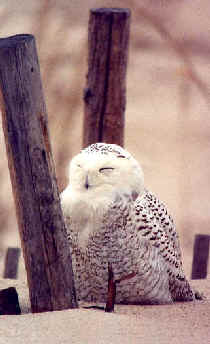
Above: the Snowy Owl at Cape Henlopen, Delaware on
December 18, 1993
Below: also in Delaware, but about 20 years later, the Snowy Owl south of
Port Penn in November 2013
(these photos by Marie Gardner)
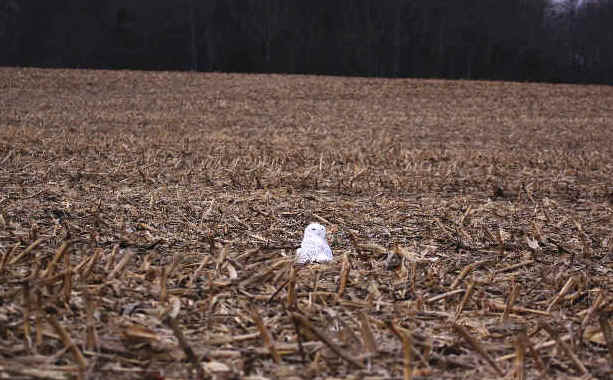
Below: a closer look at that Snowy Owl in the field south of Port Penn,
Delaware

- Barred Owl (ph) ______ DE
bh*
MD bw*
Strix varia georgica
- Long-eared Owl (ph) ______
DE bh(rare)
MD bw(rare) VA ch
Asio otus
- Short-eared Owl (ph) ______
DE bh
MD bw VA ch
Asio flammeus
Over the years, the Short-eared Owl has possibly been the rarest
nesting bird in the southern Dorchester County marshes in Maryland.
From the book: "Blackwater" by Brook Meanley, published in
1978:
Only two nests have been found in Maryland:
one, back in June 1923, in the "Blackwater area", a "marsh
owl" nest with eggs, and another on May 13, 1958 in a brackish marsh
near the mouth of the Blackwater River, a nest with 5 half-grown
young.
In Virginia, during the Chincoteague Christmas Count on December 29,
1965 there were 31 Short-eared Owls.
- Northern Saw-whet Owl (ph)
______ DE bh(rare)
MD bw(rare) VA
Aegolius acadicus
Starting in 1994, there was banding of Saw-whet Owls on the lower
Eastern Shore of Virginia near Cape Charles, from mid-October thru
mid-December, with most November 1 thru December 5.
Over the years, banding totals have varied, but in 1995 there was a high
tally of 1,007 Saw-whet Owls.
During invasion years (such as 1995 and 1999), about 80 per cent of the owls
were first-year birds.
During non-invasion years, adults predominated.
- Burrowing Owl (ph) ______
DE bh(rare)
Athene cunicularia
A Burrowing Owl was seen and photographed in Delaware at
Bombay Hook Refuge on April 17, 2015 in late afternoon and evening. Although
searched for the next day, it was not found again.
NIGHTJARS, NIGHTHAWK
- Chuck-Will's-Widow ______
DE MD bw VA ch*
Caprimulgus carolinensis (monotypic)
- Eastern Whip-poor-will ______ DE
bh MD bw VA
Caprimulgus vociferus
On the Eastern Shore of Virginia,
the Eastern Whip-poor-will now occurs generally as a migrant. The
most recent breeding-season record was June 4, 1991 at Saxis.
In Virginia, an Eastern Whip-poor-will was found on the Cape
Charles Christmas Count on December 30, 1983.
- Common Nighthawk (ph) ______
DE bh(rare)
MD bw* VA ch
Chordeiles m. minor
SWIFT
- Chimney Swift ______ DE
bh MD bw VA ch*
Chaetura pelagica (monotypic)
A Chimney Swift was seen
during a FONT pelagic trip offshore from Lewes, Delaware in June
2002.
HUMMINGBIRDS
- Ruby-throated Hummingbird (ph) ______
DE bh* MD bw* VA ch*
Archilochus colubris
(monotypic)
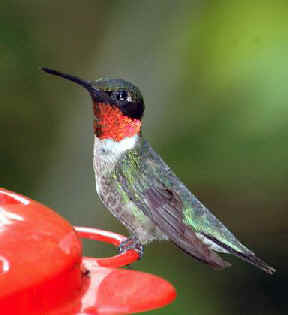
A male Ruby-throated Hummingbird
(photo by Howard Eskin)
- Black-chinned Hummingbird (r/DP)
(ph) ______ VA
Archilochus alexandri
An immature male Black-chinned Hummingbird was in Virginia at
Cape Charles from November 28 o December 19, 2004.
- Rufous Hummingbird (u/DP) (ph) ______
DE MD VA
Selasphorus rufus
The first record of a Rufous Hummingbird in Delaware was on
November 27, 1978 in New Castle.
Since then, in Delaware: December 18, 1996 in Wilmington, December
17-28, 1998 in Bellefonte (north of Wilmington), November 19, 1999 and
November 28, 2000 in Hockessin, December 15, 2001 in Lewes, August 29, 2002
in Newark, November 20, 2003 in Middletown, November 16-23, 2003 and
December 10, 2003 near Wilmington.
In Maryland, Rufous Hummingbirds have included these: September 12,
1963 in Ocean City, October 19 to December 29, 1993 in Elkton (in Cecil
County), November 12 to December 22, 2000 in Cambridge, November 16, 2000 to
January 1, 2001 in Bishopville (in Worcester County).
On the Eastern Shore of Virginia, an adult male Rufous Hummingbird
was at Melfa in Accomack County from August 4 to September 9,
1986.
- Allen's Hummingbird (r/DP) (ph)
______ DE VA
Selasphorus sasin
Allen's Hummingbirds
were in Delaware: from November 1,
1997 to February 12, 1998 north of Wilmington,
November 23, 2002 at the Woodland Beach Wildlife Area .
In Virginia, an immature male Allen's Hummingbird was banded
at Cape Charles from October 26 to December 30, 2005.
- Broad-tailed Hummingbird (r/DP)
(ph) ______ DE
Selasphorus platycercus
A Broad-tailed Hummingbird was in Delaware March 22, 1998 in
Rehoboth Beach. It was banded.
- Calliope Hummingbird (r/DP)
(ph) ______ DE MD
Selasphorus (formerly Stellula) calliope
The first Calliope Hummingbird in Delaware was at a feeder
in Newark November 8-11, 2012. Identification was from a photograph,
In Maryland, a male Calliope Hummingbird was in Easton,
coming to backyard purple salvia, October 23 to December 16, 2011.
The following year, also in Talbot county, there was a female Calliope
Hummingbird in Tilghman, November 15-22, 2012.
- Anna's Hummingbird (r/DP) (ph) ______
DE
Calypte anna
An Anna's Hummingbird was in northern Delaware, in Newark,
from October 12, 2012 to April 7, 2013.
Interesting about this Delaware-first, is that when the bird was captured
and banded on November 15, 2012, it was mistakenly identified as a
hatch-year female. It was fortunate that the bird stayed until April 2013
because by the end of March it was evident that it was a
male.
In Maryland, there were two occurrences of Anna's Hummingbirds,
in 2006 and 2010, but neither were on the Delmarva Peninsula.
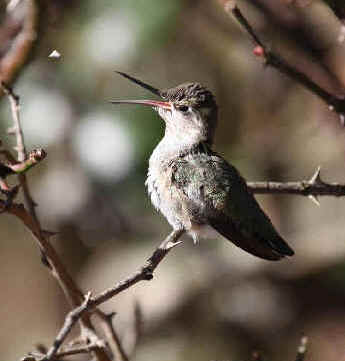
An Anna's Hummingbird in Newark, Delaware
present from the fall of 2012 until the spring of 2013.
It was a first for the state.
In the first photo below,
some coloration
is visible on the bird's throat.
(both photos here by Marie Gardner)
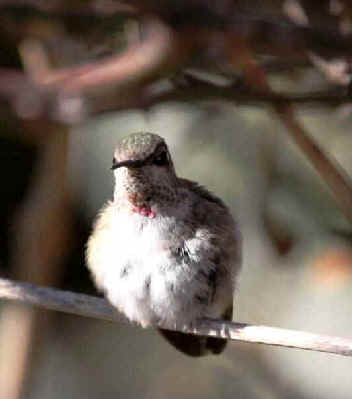
In the following photo below, there is obviously much more coloration.
This lower photo was taken about 4 months later than the one above,
on the last day that the bird was seen, April 7, 2013.
(photo by Howard Eskin)
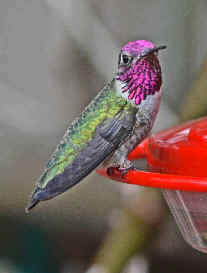
- Green Violetear (r/NA) (ph)
______ MD
Colibri thalassinus
A Green Violetear was in Cecil County, Maryland, in Elkton
October 10-12, 2011.
Prior to 2011, there was no record of the species in the state.
KINGFISHER
- Belted Kingfisher (ph) ______
DE
bh* MD bw* VA ch
Megaceryle
(formerly Ceryle) alcyon
(monotypic)
A Belted Kingfisher was seen
during a FONT pelagic trip offshore from Lewes, Delaware in September
2000.
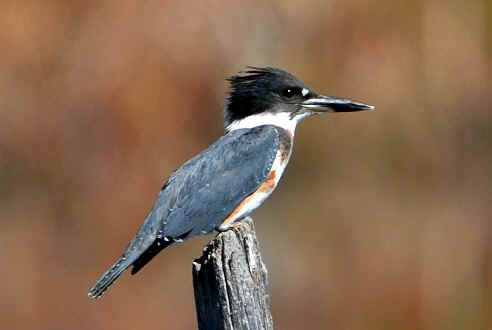
Belted Kingfisher
(photo by Howard Eskin)
WOODPECKERS
- "Yellow-shafted" Northern Flicker
______ DE bh* MD bw*
VA ch*
Colaptes auratus luteus
- Red-bellied Woodpecker (ph) ______
DE
bh* MD bw* VA ch*
Melanerpes carolinus
(monotypic)
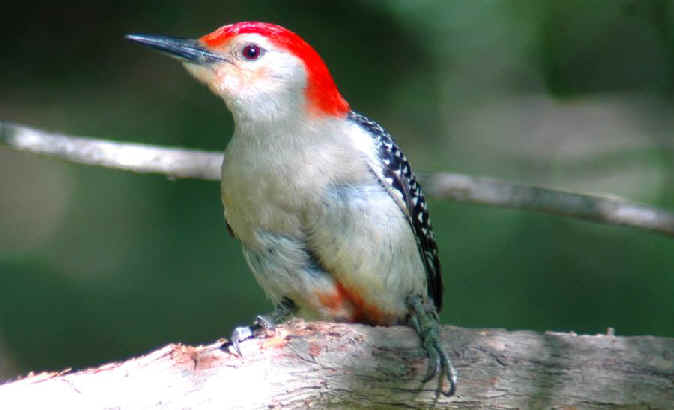
Red-bellied Woodpecker
(photo by Howard Eskin)
- Red-headed Woodpecker (ph) ______
DE bh(rare) MD bw(rare) VA
ch*
Melanerpes erythrocephalus (monotypic)
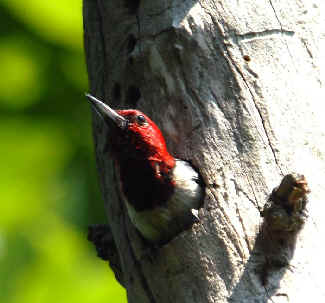
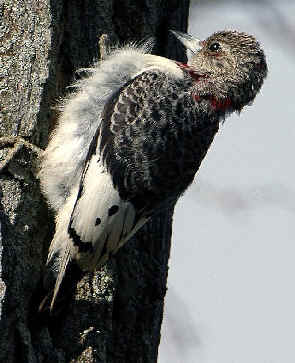
Red-headed Woodpeckers,
an adult
(above) and an immature
(below)
(photos by Howard Eskin)
- Yellow-bellied Sapsucker (ph)
______ DE bh MD bw VA ch
Sphyrapicus varius
- Downy Woodpecker (ph) ______
DE bh* MD bw* VA ch*
Picoides p. pubescens
- Hairy Woodpecker (ph) ______
DE bh* MD bw* VA ch
Picoides v. audubonii
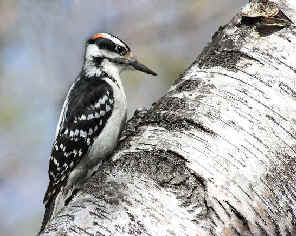
Hairy Woodpecker
(photo by Doris Potter)
- Red-cockaded Woodpecker (t3) (extirpated/DP)
______ MD VA ch(very rare)
Picoides borealis
The following text is paraphrased from the book: "Birds and Marshes of
the Chesapeake Bay Country" by Brook Meanley, published first in 1975,
reprinted in 1983:
During parts of the 20th Century, the Red-cockaded Woodpecker was Maryland's
rarest native bird.
A southern species, it was observed in the state almost exclusively in the
maritime Loblolly Pine forest of the lower Eastern Shore,
where it reached its northern limit.
The Red-cockaded Woodpecker occurred in Maryland in
Dorchester, Worcester, and Prince George's Counties, with only single
occurrences in the last two counties.
As alluded to above, the Red-cockaded Woodpecker only occurs in pine
forests, and there it only nests in mature or overripe pines that have been
infested with red-heart disease. To reach that stage, a tree must be about
70 years old.
The Red-cockaded Woodpecker was first observed in Maryland in 1932 in
the area of the Blackwater Wildlife Refuge. Several nesting pairs
were found in loblolly pine-woods in that area.
The species was not seen in that area again until the middle 1950s, when it
was rediscovered in a small tract of mature loblollies close to Blackwater,
near Golden Hill.
There were about a half-dozen pairs of Red-cockaded Woodpeckers in
that Golden Hill colony.
The mature tract of Loblolly Pines in which Maryland's last known Red-cockaded
Woodpecker nesting colony occurred was mostly destroyed in the late
1960s.
Since then, the nearest nesting Red-cockaded Woodpeckers have been in
Virginia, and south of the Delmarva Peninsula.
A rare extralimital Red-cockaded Woodpecker was at Chincoteague
Refuge in Virginia April 10, 1981.
- American Three-toed Woodpecker
(r/DP) ______ DE
Picoides dorsalis
American Three-toed Woodpeckers
has been in Delaware:
February 21, 1968 in Hockessin, April 7, 1974 at Dragon Run Marsh near
Delaware City.
- Pileated Woodpecker (ph) ______
DE
MD bw* VA ch*
Dryocopus p. pileatus
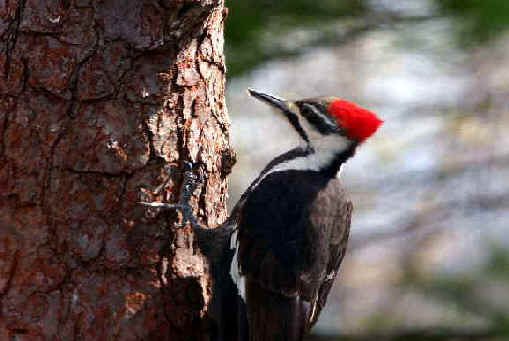
Pileated Woodpecker
(photo by Ed Kendell)
FLYCATCHERS
- Eastern Kingbird (ph) ______
DE
bh* MD bw* VA ch*
Tyrannus tyrannus (monotypic)
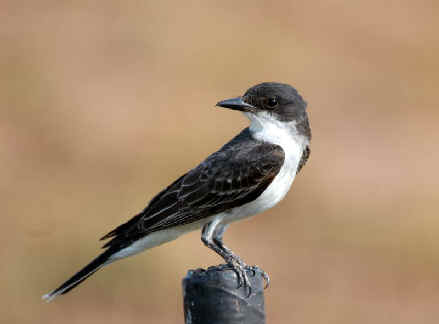
Eastern Kingbird
(photo by Howard Eskin)
- Western Kingbird (u/DP) (ph) ______
DE bh(rare) MD bw(rare) VA
ch(rare)
Tyrannus verticalis
Western Kingbirds
were in Delaware: December 31, 1912 at Rehoboth Beach, October 10,
1997 at Bombay Hook Refuge, December 29, 2001 to January 6, 2002 at the
Cedar Swamp Wildlife Area, November 20, 2005 at Bombay Hook Refuge, November
2, 2009 at Cape Henlopen, August 16-17, 2010 by Whitehall Neck Rd south of
Bombay Hook, October 28, 2010 at Cape Henlopen, and July 11, 2012 again by
Whitehall Neck Rd.
Western Kingbirds in Maryland included these on: December
23, 1946 near Snow Hill, November 14, 1954 near Berlin, May 22, 1958 in
Claiborne in Talbot County, September 17-18, 1956 and September 15, 1958 in
Ocean City, October 11, 1958 at the Assateague National Seashore, September
13, 1959 at Tilghman in Talbot County, October 26, 1959 at Belleview in
Talbot County, November 1, 1959 by the Little Choptank River in Dorchester
County, November 22, 1959 in Cambridge, November 5, 1961 in Ocean City,
September 15, 1962 at Tilghman in Talbot County, September 30 1962 in Ocean
City, November 12, 1962 near Berlin, November 20, 1965 at Bellevue in Talbot
County, November 21, 1966 at Golden Hill near Blackwater Refuge, November
13, 1966 at Blackwater Refuge, September 29, 1968 at Hooper's Island in
Dorchester County, October 22, 1972 two birds at the Shad Landing Park near
Snow Hill, November 12, 1972 at Rock hall in Kent County, November 28, 1985
near Berlin, October 13 and November 3, 1990 at the Assateague National
Seashore.
Since 1991, the Western Kingbird has not been a reviewable species in
Maryland.
On the Eastern Shore of Virginia, generally up to 8 Western
KIngbirds are found each fall.
- Tropical Kingbird (r/DP) (ph)
______ DE MD
Tyrannus melanoholicus
A Tropical Kingbird was in Delaware near Prime Hook Refuge
on October 13, 2009.
In Maryland, there was a Tropical Kingbird December 17, 2006
to January 3, 2007 at Princess Anne in Somerset County.
- Gray Kingbird (r/DP) (ph) ______
MD VA ch(very rare)
Tyrannus dominicensis
A Gray Kingbird was in Delaware near Prime Hook Refuge on
November 6, 2013.
A Gray Kingbird was near Girdletree, in Maryland, June 14,
1975. That was the first for the state.
Since then, on the Delmarva Peninsula, there was one October 19-23, 2005 in Worcester County, near
Stockton at George Island Landing.
- Scissor-tailed Flycatcher (u/DP) (ph)
______ DE bh(very rare)
MD bw(very rare) VA ch(very rare)
Tyrannus forticatus
Scissor-tailed Flycatchers
were in Delaware:
May 21, 1988 and May 20, 1989 at Bombay Hook Refuge, May 19, 1990 at South
Bethany Beach, from July 22 to August 14, 1995 at Bombay Hook Refuge, May
11, 1996 at Frederica, August 7-15, 2006 by Route 9, and May 8, 2013 at Cape
Henlopen.
Scissor-tailed Flycatchers in Maryland included these:
June 2, 1963 in Easton, May 16, 1984 at Blackwater Wildlife Refuge, May
26-27, 2009 at Eastern Neck Wildlife Refuge.
Scissor-tailed Flycatchers on the Eastern Shore of Virginia
were: June 28, 1980 at Cape Charles, July 22, 1982 at Nassawaddox, November
1, 1989 at Kiptopeke, May 2, 1992 at Capeville, August 6-9, 1994 at the
Eastern Shore of Virginia Wildlife Refuge, mid-June 1995 at Chincoteague
Wildlife Refuge, September 24, 1996, October 20, 1997 at Kiptopeke, mid-May
1999 near Eastville, July 21-31, 2000 at the Eastern Shore of Virginia
Wildlife Refuge, May 8, 2003 by Metompkin Bay, and April 25, 2006 in
Northampton County. .
- Fork-tailed Flycatcher (r/DP) (ph)
______ DE MD VA ch(very
rare)
Tyrannus savana
Fork-tailed Flycatchers
were in Delaware: October 19, 1985 at the Little Creek
Wildlife Area,
September 27, 1989 in Camden, September 23, 2000 by Miller's Neck Rd, May 3,
2012 at the Coverdale Preserve.
In Maryland, there was a Fork-tailed Flycatcher on October 21,
2007 at the Eastern Neck Wildlife Refuge.
On the Eastern Shore of Virginia, there were Fork-tailed
Flycatchers May 17-19, 1990 at Chincoteague Wildlife Refuge, and October
26, 1999 at Kiptopeke.
- Great Crested Flycatcher (ph) ______
DE
bh* MD bw* VA ch*
Myiarchus crinitus (monotypic)
- Ash-throated Flycatcher (r/DP)
(ph) ______ DE VA ch(very
rare)
Myiarchus cinerascens
Ash-throated Flycatchers
were in Delaware: November 24, 1996 at Cape Henlopen, December 29,
2007 at Fresh Pond, November 14-15, 2009 at Prime Hook Wildlife
Refuge.
Ash-throated Flycatchers were on the Eastern Shore of Virginia:
December 13, 1969 at Chincoteague Wildlife Refuge, December 27-30, 1978 at
Cheriton in Northampton County, December 30-31, 1979 at Kiptopeke, December
27, 1986 on the Cape Charles Christmas Count, December 10-23, 1987 near
Melfa in Accomack County, December 27, 1992 at Riverview Farm in Northampton
County, November 7, 1994 and November 6-7, 2004 at the Eastern Shore of
Virginia Wildlife Refuge, November 28, 2004 at the Chesapeake Bay Bridge
Tunnel, November 19-26, 2005 at Kiptopeke.
A Myiarchus flycatcher in the early fall, on September 13, 1986, at
Chincoteague Refuge lacked the documentation to determine the
species.
- Acadian Flycatcher ______ DE bh*
MD bw* VA ch*
Empidonax virescens (monotypic)
- Willow Flycatcher ______ DE
bh* MD bw VA ch
Empidonax trailii
- Alder Flycatcher ______ DE
bh(rare)
Empidonax alnorum
- Yellow-bellied Flycatcher ______
DE VA ch
Empidonax flaviventris
- Least Flycatcher ______ DE bh
MD bw(rare) VA ch(rare)
Empidonax minimus
- Hammond's Flycatcher (r/DP) ______
MD
Empidonax hammondii
A Hammond's Flycatcher was in Maryland on October 9, 1963,
in Ocean City, an immature female.
- Dusky Flycatcher (r/DP) (ph) ______
DE
Empidonax obehholseri
A Dusky Flycatcher was in Delaware at the Cedar Swamp
Wildlife Area in New Castle County in January and February
2002.

Dusky Flycatcher, photographed in Delaware in the winter of 2002.
(photo by Marie Gardner)
- Gray Flycatcher (r/DP) ______
DE
Empidonax wrightii
A Gray Flycatcher was in Delaware November 30
to December 20, 1991 at Cape Henlopen.
- Pacific-slope Flycatcher (r/DP)
______ VA
Empidonax difficilis
An empidonax flycatcher with a vocalization suggesting a Pacific-slope
Flycatcher was at the Eastern Shore of Virginia Wildlife Refuge, near
Cape Charles, Virginia, November 12 to 29, 1993.
- Eastern Phoebe (ph) ______
DE
bh* MD bw* VA ch*
Sayornis phoebe (monotypic)
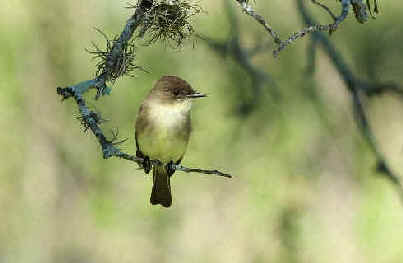
Eastern Phoebe
(photo by Rhett Poppe)
- Say's Phoebe (r/DP) (ph)
______ DE bh(very rare)
VA
Sayornis saya
A Say's Phoebe was in Delaware at Bombay Hook Refuge
November 1, 2003.
On the Eastern Shore of Virginia, Say's Phoebes were: near the
Eastern Shore of Virginia Wildlife Refuge on September 30, 1989, and at
Kiptopeke October 1, 1996.
- Eastern Wood Pewee (ph)
______ DE bh* MD bw*
VA ch
Contopus virns (monotypic)
- Olive-sided Flycatcher (nt)
______ DE bh(rare) MD VA
ch(rare)
Contopus cooperi
- Vermilion Flycatcher (r/DP) (ph)
______ DE VA
Pyrocephalus rubinus
An adult male Vermilion Flycatcher was in Delaware May
2-5, 1993 on Burtons Island near the Indian River Inlet.
On the Eastern Shore of Virginia, a Vermilion Flycatcher was
at Nassawaddox in Northampton County from January 15 to February 27,
1993.
SHRIKES
- Loggerhead Shrike (r/DP) (ph) ______
DE bh(very rare) MD bw
VA
Lanius ludovicianus
Loggerhead Shrikes
were in Delaware: February 9, 1991 at Prime Hook Wildlife Refuge, October 17, 1997 at Bombay
Hook Refuge, that same day near Little Creek, December 26, 1999 near
Pickering Beach, January 2, 2000 and December 22, 2000 near Broadkill
Beach, April 5-7, 2008 at the Grass Dale Center, March 5, 2010, February 6,
2011, November 7, 2011 by Bennett's Pier Rd, and May 12, 2012 by Cods Road
north of Prime Hook
Into the 1970s, there were migrant Loggerhead Shrikes in the fall
along the Virginia coast. 4 such migrants were banded at Kiptopeke:
September 25, 1966, October 3, 1966, October 3, 1969, August 27, 1977. The
last of these was the most recent coastal migrant. The species has not been
reliably reported on the Eastern Shore of Virginia since December
1988.
- Northern Shrike (r/DP) (ph) ______
DE MD bw(very rare) VA ch(very rare)
Lanius excubitor
Northern Shrikes
were in Delaware: December 30, 1995 at Clarksville, February 18-19,
1996 at Cape Henlopen, December 30, 2011 and November 7, 2004 to January 29,
2005 by Island Farm Rd, December 27, 2005 to January 12, 2006 and December
3, 2006 to January 28, 2007 by Broadkill Beach Rd.
Northern Shrikes were on the Eastern Shore of Virginia: March
6, 1978 (an immature bird). from November 24 to December 10, 1978, December
16, 1995, and October 25, 2000 at Chincoteague Wildlife Refuge, and from
December 30, 2004 to April 2, 2005 at Fisherman Island.
VIREOS
- White-eyed Vireo (ph) ______
DE
bh* MD bw* VA ch*
Vireo g. griseus
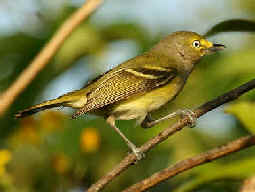
White-eyed Vireo
(photo by Dick Tipton)
- Blue-headed Vireo (ph) ______
DE
bh MD bw VA ch(rare)
Vireo s. solitarius
The Blue-headed Vireo was
part of the former Solitary Vireo.
- Yellow-throated Vireo ______ DE bh*
MD bw* VA ch(rare)
Vireo flavifrons (monotypic)
- Red-eyed Vireo ______ DE bh*
MD bw* VA ch*
Vireo o. olivaceus
- Philadelphia Vireo ______ DE
bh(rare)
VA ch(rare)
Vireo philadelphicus
- Warbling Vireo ______ DE
bh(rare)
VA ch(rare)
Vireo gilvus
- Bell's Vireo (r/DP)
______ MD
Vireo bellii
Bell's Vireos have been in Maryland, with both of these birds in
2011:
October 8 at the Assateague State Park near Berlin, October 17 at Turkey
Point in Cecil County.
CORVIDS
- Blue Jay (ph) ______ DE bh*
MD bw* VA ch*
Cyanocitta c. cristata
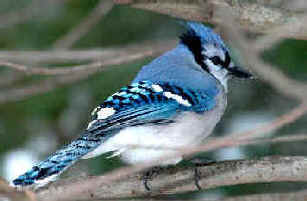
Blue Jay
(photo by Howard Eskin)
- American Crow (ph) ______
DE bh* MD bw* VA ch*
Corvus b. brachyrhynchos
- Fish Crow ______ DE bh*
MD bw* VA ch*
Corvus ossifragus (monotypic)
- Common Raven (r/DP) (ph) ______ VA
Corvus corax
On the Eastern Shore of Virginia, the Common Raven was,
years ago in the 1880s, a breeding bird. It was found to be so on Cobb,
Bone, and Mockhorn Islands.
Since then it was, rarely, a winter visitor on Virginia's Eastern
Shore. Recently, the only record there was at Kiptopeke on October 26,
2002.
CHICKADEES, TITMOUSE
- Carolina Chickadee (ph) ______
DE
bh* MD bw* VA ch*
Poecile
(formerly Parus) c. carolinensis
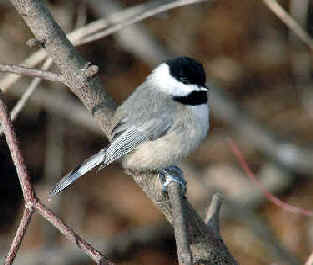
Carolina Chickadee
(photo by Howard Eskin)
- Black-capped Chickadee (r/DP) (ph)
______ DE MD bw(rare) VA ch(very
rare)
Poecile atricapillus
On the Eastern Shore of Virginia, the Black-capped Chickadee
has been a rare and irregular winter visitor.
It has occurred: December 29, 1954 at Chincoteague Wildlife Refuge (2 birds
during the Christmas Count), October 13, 1978 one banded at Kiptopeke,
October 3, 1983, one banded at Kiptopeke, November 8, 2000, three banded at
Chincoteague Wildlife Refuge.
There has not been a significant flight year for Black-capped Chickadees
in the mid to lower Delmarva Peninsula since 1983.
- Boreal Chickadee (r/DP) ______
DE
Poecile hudsonicus
A Boreal Chickadee was in Delaware April 6-9, 1982 in
Wilmington. It was photographed.
- Tufted Titmouse ______ DE bh*
MD bw* VA ch(rare)
Baeolophus (formerly Parus) bicolor
NUTHATCHES,
CREEPER
- White-breasted Nuthatch (ph) ______
DE
bh MD bw VA ch(rare)
Sitta c. carolinensis
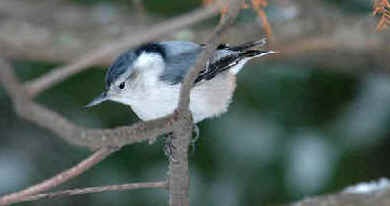
White-breasted Nuthatch
(photo by Howard Eskin)
- Red-breasted Nuthatch (ph)
______ DE bh MD bw
VA ch
Sitta canadensis
- Brown-headed Nuthatch (ph) ______
DE MD bw* VA ch*
Sitta p. pusilla (this subspecies
endemic to the southeast US; the other subspecies is in the Bahamas)
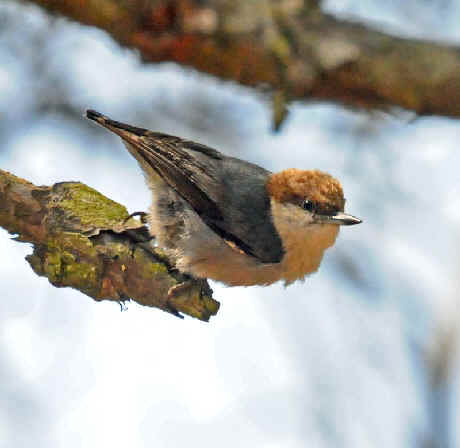
Brown-headed Nuthatch
(photo by Howard Eskin)
- Brown Creeper (ph) ______
DE
bh MD bw VA ch
Certhia anericana
SWALLOWS
- Purple Martin (ph) ______
DE
bh* MD bw* VA ch
Progne s. subis
- Barn Swallow (p) (ph) ______
DE
bh* MD bw* VA ch*
Hirundo rustica erythrogaster
- American Cliff Swallow ______
DE bh MD bw VA ch(rare)
Petrochelidon pyrrhonota
- Cave Swallow (r/DP) (ph) ______
DE bh(very rare)
VA ch(very rare)
Petrochelidon fulva
The Cave Swallow has, during recent years, been expanding its range
and population as a breeding bird in Texas and nearby states. By the late
fall of 1990, it began to appear on the East Coast of the US, mostly in
November.
The subspecies of the Cave Swallow that has occurred in the Eastern
US is that of the south-central US and Mexico, Petrochelidon
fulva pallida.
Cave Swallows
have been in Delaware: September 22, 1996 at Bombay Hook, December
11, 1999 at Leipsic, December 2, 2006 at Augustine Beach, November 22, 2007
at Fowler's Beach, November 24, 2007 at Cape Henlopen, November 13, 2008 at
Woodland Beach, November 15, 2008 near Prime Hook, November 16, 2008 at
Prime Hook Wildlife Refuge, November 18-19, 2008 and November 4, 2012 at
Augustine Beach, November 10, 2012 at Cape Henlopen..
The first Cave Swallow reported in Delaware was in 1996 (or
1999, as accepted by the state record committee).
Since then, as noted here, there have been 1 in Delaware in 2006, 2 in 2007,
4 in 2008, and 2 in 2012.
Across the Delaware Bay, at Cape May, New Jersey, during the two decades or
so from the mid-1990s to the early-2010s, the species gathered in
substantial numbers in the
fall.
On the Eastern Shore of Virginia, the Cave Swallow was first
found November 4-18, 1999 at the Eastern Shore of VA Wildlife Refuge.
(Although there may have been a report the previous year, November 1, 1998
at Fisherman Island).
Since then, the Cave Swallow was been recorded on the Virginia
Eastern Shore every year in the fall, except 2003.
Records have included: November 20, 2000 north of Kiptopeke, October 15,
2001 at Kiptopeake, where November 3-24, 2002 there were 6 reports totaling
nearly 20 individuals. More than 100 birds occurred in 2004.
Early were 6 at Kiptopeake on September 19, seemingly with Hurricane Ivan.
On November 5, 2004, were were 11 on November 5, 2004 at Kiptopeke, building
up to 40 on November 28 and continuing to a dozen as late as December 12.
A Cave Swallow was photographed at Chincoteague Wildlife Refuge
December 4-5, 2004.
From October 25 to November 2, 2005, in southernmost Northampton County,
there was a roost of several birds in the supports of the bridge over
Fisherman Inlet.
Spring records were at Cape Charles May 1, 2000 (2 birds) and June 5,
2001.
- Tree Swallow (ph) ______ DE bh*
MD bw* VA ch*
Tachycineta bicolor (monotypic)
- Northern Rough-winged Swallow
(ph) ______ DE bh MD bw*
VA ch(rare)
Stelgidopterys s. serripennis
- Bank Swallow ______ DE bh
MD bw VA ch
Riparia riparia
LARK
- Horned Lark (ph) ______
DE
bh* MD bw* VA ch*
Eremophila alpestris
KINGLETS
- Golden-crowned Kinglet (ph)
______ DE bh MD bw
VA ch
Regulus satrapa
- Ruby-crowned Kinglet (ph)
______ DE bh MD bw
VA ch
Regulus calendula
WRENS
- Carolina Wren (ph) ______
DE
bh* MD bw* VA ch*
Thryothorus l. ludovicianus

Carolina Wren
(photo by Howard Eskin)
- Bewick's Wren (r/DP)
______ MD VA
Thryothorus bewickii
A Bewick's Wren was in Maryland in Ocean City on December 27,
1967.
- House Wren (ph) ______
DE bh* MD bw* VA ch*
Troglodytes a. aedon
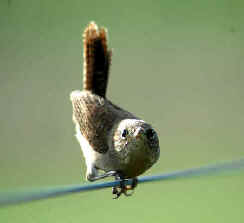
A House Wren, looking at you!
(photo by Howard Eskin)
- Winter Wren (ph) ______ DE
bh MD bw VA ch
Troglodytes hiemalis
- Sedge Wren (ph) ______ DE bh*
MD bw VA ch
Cistothorus platensis
It was in the 1980s when the Sedge Wren disappeared from nesting
sites in Dorchester County in Maryland, along the road to Elliott
Island. They bred in grassy areas dominated by Wand-like
Switch-grass, Panicum virgatum, as did the Henslow's Sparrow
(later in this list).
- Marsh Wren (ph) ______ DE bh*
MD bw* VA ch
Cistothorus palustris waynei
- Rock Wren (r/DP) (ph)
______ MD VA
Salpinctes obsoletus
A Rock Wren was in Maryland at the Assateague Island National
Seashore October 11-14, 1993.
On the Eastern Shore of Virginia, a Rock Wren was at the
Chesapeake Bay Bridge Tunnel October 29-30, 1988.
GNATCATCHER
- Blue-gray Gnatcatcher (ph)
______ DE bh* MD bw*
VA ch*
Polioptila c. caerulea
THRASHERS and
Allies
- Gray Catbird (ph) ______
DE
bh* MD bw* VA ch*
Dumetella carolinensis
(monotypic, and the single member of its genus)
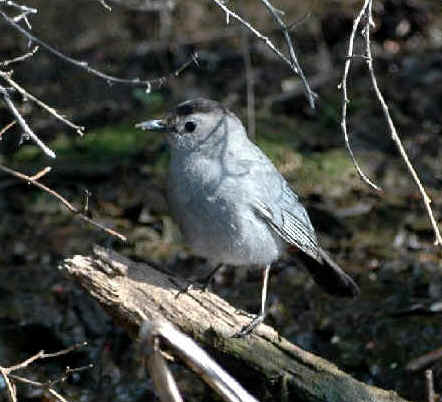
Gray Catbird
(photo by Howard Eskin)
- Northern Mockingbird (ph) ______
DE bh*
MD bw* VA ch*
Mimus p. polyglottos
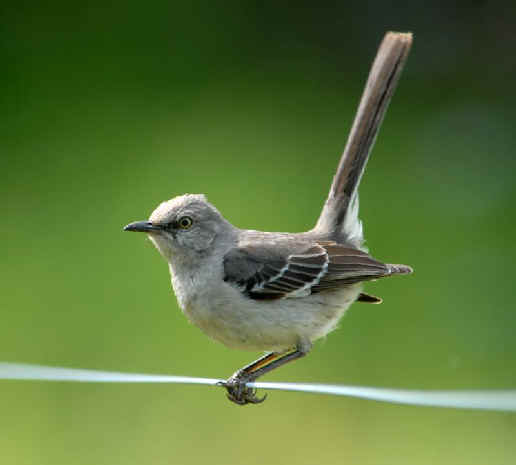
Northern Mockingbird
(photo by Howard Eskin)
- Brown Thrasher (ph) ______
DE
bh* MD bw* VA ch*
Toxostoma r. rufum

Brown Thrasher
(photo by Doris Potter)
- Sage Thrasher (r/DP) (ph) ______
DE
bh(very rare) MD VA
ch(very rare)
Oreoscoptes montanus
A Sage Thrasher was in Delaware at Bombay Hook Refuge on
October 29, 1985.
In Maryland, a Sage Thrasher was at the Assateague State Park
near Berlin on October 24, 1971.
On the Eastern Shore of Virginia, there was a Sage Thrasher at
Chincoteague Wildlife Refuge on October 10, 1985.
THRUSHES and Allies
- American Robin (ph) ______
DE
bh* MD bw* VA ch*
Turdus m. migratorius
- Fieldfare (r/NA) ______ DE
bh(very rare)
Turdus pilaris
A Fieldfare was in Delaware at Bombay Hook Refuge from March
30 to April 1, 1969.
- Varied Thrush (r/DP) (ph) ______
DE
Ixoreus naevius
A Varied Thrush was found in Delaware on January 9, 1996 north
of Wilmington, where it remained that winter.
On the Eastern Shore of Virginia, a Varied Thrush was at
Chincoteague Wildlife Refuge on October 19, 2003.
- Wood Thrush ______
DE bh*
MD bw* VA ch
Hylocichla mustelina (monotypic, and the single member of its genus)
- Veery ______
DE bh
MD bw VA ch
Catharus fuscescens
- Hermit Thrush (ph) ______
DE
bh MD bw VA ch
Catharus guttatus
- Swainson's Thrush ______
DE bh
MD bw VA ch
Catharus ustulatus
- Gray-cheeked Thrush ______ DE bh
MD bw VA ch
Catharus minimus
- Bicknell's Thrush (t3) (u/DP) ______
DE
bh(rare) VA ch(rare)
Catharus bicknelli
Most records of the Bicknell's Thrush on the Eastern Shore of
Virginia are of birds banded during the fall migration at Kiptopeke.
Captures there declined precipitously from approximately 100 per year in the
late 1960s and early 1970s to 1 to 3 birds per year in the 1980s and 1990s.
Captures of Bicknell's Thrushes dropped from being 30 per cent of the
Gray-cheeked Thrush complex to less than 5 per
cent.
- Eastern Bluebird (ph) ______
DE
bh* MD bw* VA ch*
Sialia s. sialis
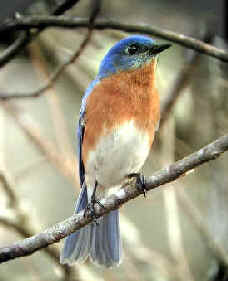
Eastern Bluebird
(photo by Howard Eskin)
- Mountain Bluebird (r/DP) (ph)
______ MD VA
Sialia currucoides
A female Mountain Bluebird was in Maryland at the Assateague
Island National Seashore on November 8, 2003.
On the Eastern Shore of Virginia, a male Mountain Bluebird was
at Dixon Farm, north of the Eastern Shore of Virginia Wildlife Area in
Northampton County November 27-28, 2004.
- Northern Wheatear (r/DP) (ph) ______
DE VA ch(very rare)
Oenanthe oenanthe
A Northern Wheatear was found in Delaware on September 21,
1957 near the Indian River Inlet.
Over 50 years later, the 2nd Northern Wheatear in Delaware was
found on December 22, 2010, at the opposite end of the state, in Claymont at
the Fox Point Park by the Delaware River.
On the Eastern Shore of Virginia, Northern Wheatears were: at
Townsend in Northampton County October 3-4, 1971, at Chincoteague Wildlife
Refuge May 23, 1978 and October 2, 1982, and at Kiptopeke October 15,
1995.
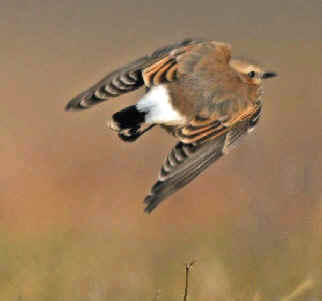
A photograph of the Northern Wheatear
in northern Delaware in December 2010
(photo by Howard Eskin)
WAXWINGS
- Cedar Waxwing (ph) ______
DE bh* MD bw VA ch
Bombycilla cedrorum (monotypic)
- Bohemian Waxwing (r/DP)
______ MD
Bombycilla garrulus
A single Bohemian Waxwing was in Maryland at the
Assateague State Park near Berlin February 13-15, 1994.
STARLING
- European Starling (i) (ph) ______
DE bh* MD bw* VA ch*
Sturnus v. vulgaris
PIPITS
- American Pipit (ph) ______
DE
bh MD bw VA ch
Anthus rubescens
- Sprague's Pipit (t3)
______ VA ch(very
rare)
Anthus spragueii
On the Eastern Shore of Virginia, a Sprague's Pipit was at
Chincoteague Wildlife Refuge on September 28, 1976.
OLD WORLD SPARROW
- House Sparrow (i) ______ DE bh* MD
bw* VA ch*
Passer d. domesticus
FINCHES
- House Finch (i) (ph) ______
DE bh* MD bw* VA ch*
Haemorhous
(formerly Carpodacus) mexicanus frontalis
On the Delmarva Peninsula,
there was a population decline of the House Finch in the mid-1990s,
due at least in part to birds having mycoplasmal conjunctivitis. Numbers are
still generally lower than they were in the early 1990s.
- Purple Finch (ph) ______
DE
bh MD bw VA ch
Haemorhous
(formerly Carpodacus) purpureus
- Red Crossbill (ph) ______
DE MD bw VA ch(rare)
Loxia curvirostra
The Red Crossbill is a highly irruptive species. Irruptions have
occurred as far south as Virginia during the winters of 1963-64,
1969-70, and 1975-76. Such large irruptions have not occurred since.
In 1975, there were 223 Red Crossbills on the Southern
Dorchester County Christmas Count in Maryland.
Not during the winter, on the Eastern Shore of Virginia, a single
Red Crossbill was a Kiptopeke August 31, 1985, and another single was
at Fisherman Island July 31, 2000.
In the fall, 22 Red Crossbills were at the Eastern Shore of Virginia
Wildlife Refuge November 4, 1999.
In the winter, 122 were tallied on the Chincoteague Christmas Count on
December 29, 1969, and 42 were on the Cape Charles Christmas Count December
27, 1972, and 19 were on that count December 27, 1990.
- White-winged Crossbill (u/DP) (ph)
______ DE MD bw(very
rare) VA ch(very rare)
Loxia leucoptera
Like the previous species, the White-winged Crossbill is highly
irruptive.
In 1969, there was one White-winged Crossbill on the
Southern Dorchester County Christmas Count in Maryland.
On the Eastern Shore of Virginia, one White-winged Crossbill
was Kiptopeke November 28, 1997, 5 were at the Eastern Shore of Virginia
Wildlife Area November 18, 1999, 3 at Kiptopeke November 23, 2001. 12 were
at Chincoteague Wildlife Refuge November 25, 2001.
- Common Redpoll (u/DP) (ph) ______
DE bh(rare)
MD bw(rare) VA ch(rare)
Acanthis
(formerly Carduelis) flammea
- Pine Siskin (ph) ______ DE
bh MD bw VA ch
Spinus
(formerly Carduelis) pinus
- American Goldfinch (ph) ______
DE bh* MD bw* VA ch*
Carduelis t. tristis
- Evening Grosbeak (u/DP) (ph) ______
DE bh(rare) MD bw(rare) VA
ch(rare)
Coccothraustes verpertinus
Particularly large irruptions of Evening Grosbeaks occurred on the Delmarva
Peninsula during several winters from 1966 to 1978, and to a lesser
extent later in November-December 1995.
Generally the species has declined across the Midwestern and Eastern United
States since the mid-1980s.
In 1975, there were 400 Evening Grosbeaks on the Southern
Dorchester County Christmas Count in Maryland.
On the Eastern Shore of Virginia, 548 Evening Grosbeaks
were on the Cape Charles Christmas Count on December 27, 1971.
- Pine Grosbeak (r/DP) (ph)
______ DE MD bw(very
rare)
Pinicola enucleator
Pine Grosbeaks were in Delaware: November 18, 1974 in Wilmington,
and on the same date (different year) November 18, 1983 in
Newark.
In Maryland, in 1968, there were 2 Pine Grosbeaks on
the Southern Dorchester County Christmas Count.
WARBLERS
- Black-and-white Warbler ______
DE bh
MD bw VA ch
Mniotilta varia (monotypic, and the single species of its genus)
- Blue-winged Warbler (ph) ______
DE
bh MD bw VA ch(rare)
Vermivora pinus (monotypic)
- Golden-winged Warbler (nt)
______ DE bh(rare) MD
bw(rare)
VA ch(rare)
Vermivora chrysoptera
- Tennessee Warbler (ph) ______
DE
bh MD bw VA ch(rare)
Oreothlypis
(formerly Vermivora) peregrina
- Nashville Warbler (ph) ______
DE
bh MD bw(rare) VA
ch(rare)
Oreothlypis
(formerly Vermivora) ruficapilla
- Orange-crowned Warbler (ph)
______ DE bh(rare)
MD bw(rare)
VA ch(rare)
Oreothlypis
(formerly Vermivora) celata
- Virginia's Warbler (r/DP)
______ MD
Oreothlypis virginiae
A Virginia's Warbler was in Maryland in Easton from
January 26, 2012 to March 25, 2012.
- Northern Parula (ph) ______
DE
bh MD bw* VA ch*
Setophaga (formerly Parula) americana
(monotypic)
- Yellow Warbler (ph) ______
DE
bh* MD bw* VA ch*
Setophaga (formerly Dendroica)
petechia
A Yellow Warbler was seen during a
FONT pelagic trip offshore from Lewes, Delaware in June 2002.
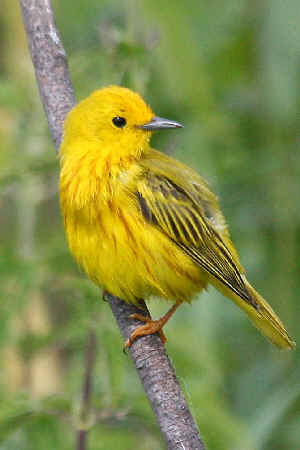
Yellow Warbler
(photo by Doris Potter)
- Chestnut-sided Warbler (ph)
______ DE bh MD bw
VA ch(rare)
Setophaga
(formerly Dendroica) pensylvanica
- Magnolia Warbler (ph) ______
DE
bh MD bw VA ch
Setophaga (formerly Dendroica) magnolia
(monotypic)
- Cape May Warbler ______
DE bh
MD bw VA ch
Setophaga
(formerly Dendroica) tigrina
- Black-throated Blue Warbler ______ DE bh
MD bw VA ch
Setophaga (formerly Dendroica) caerulescens
- Black-throated Green Warbler
(ph) ______ DE bh VA ch(rare)
Setophaga (formerly Dendroica) virens
- Black-throated Gray Warbler
(r/DP) ______ DE MD VA
Setophaga
(formerly Dendroica) nigrescens
A Black-throated Gray Warbler was in Delaware
on October 9, 1991 at Cape Henlopen.
Black-throated Gray Warblers in Maryland included these: on
September 30, 1994 in Easton, October 22, 2003 at the Assateague Island
National Seashore, November 20, 2011 in Salisbury.
On the Eastern Shore of Virginia, an adult male Black-throated
Gray Warbler was at Fisherman Island September 13, 2004.
- Townsend's Warbler (r/DP)
______ MD VA
Setophaga (formerly Dendroica)
townsendi
A Townsend's Warbler was in Maryland on September 17, 2011
at the Assateague Island National Seashore.
On the Eastern Shore of Virginia, believe it or not, a female or
immature Townsend's Warbler was in a town called Townsend in
Northampton County from December 30, 1999 to January 12,
2000.
- "Myrtle" Yellow-rumped
Warbler (ph) ______ DE bh MD bw
VA ch
Setophaga
(formerly Dendroica) c. coronata
In the 1990s, at the southern tip of the Delmarva Peninsula,
at Kiptopeke, near Cape Charles, Virginia, October flights of
warblers included up to 500,000 birds that were mostly "Myrtle"
Yellow-rumped Warblers and Palm Warblers (below in this
list).
"Audubon's" Yellow-rumped Warbler
(r/DP) ______ MD VA
Setophaga
(formerly Dendroica) coronata audubonii
"Audubon's" Yellow-rumped Warblers in Maryland
included these: from December 26, 1994 to February 18, 1995 near Berlin, on
December 29, 1999 at the Vaughn Wildlife Area near Stockton.
On the Eastern Shore of Virginia, an "Audubon's" Yellow-rumped
Warbler was at a place called Cheapside in Northampton County from
December 30, 2000 to January 5, 2001.
- Bay-breasted Warbler ______
DE bh
MD bw VA ch(rare)
Setophaga (formerly Dendroica)
castanea (monotypic)
- Blackburnian Warbler (ph) ______
DE bh
MD bw VA ch(rare)
Setophaga (formerly Dendroica)
fusca (monotypic)
- Yellow-throated Warbler (ph) ______
DE MD
bw VA ch
Setophaga (formerly Dendroica)
dominica dominica
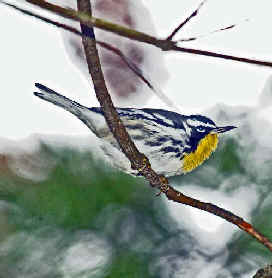
Yellow-throated Warbler
(photo by Howard Eskin)
- Blackpoll Warbler (ph) ______
DE bh
MD bw VA ch
Setophaga (formerly Dendroica)
striata (monotypic)

Blackpoll Warbler
- Pine Warbler (ph) ______ DE
bh MD bw* VA ch*
Setophaga
(formerly Dendroica) p. pinus
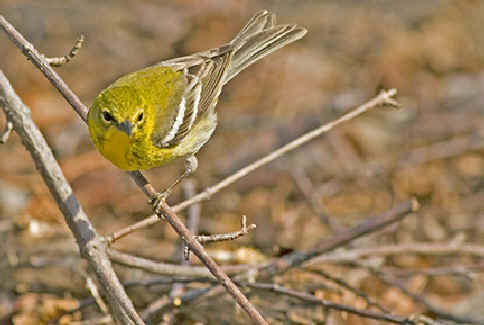
Pine Warbler
(photo by Andy Smith)
- Prairie Warbler (ph) ______
DE bh
MD bw* VA ch*
Setophaga (formerly Dendroica)
discolor
"Scrub Warbler" might
be a better name! But Alexander Wilson did not name the bird after the
western prairies or grassy plains, but rather after "the barrens of
southwestern Kentucky" where he found the bird, an area known to local
residents as "prairie country".
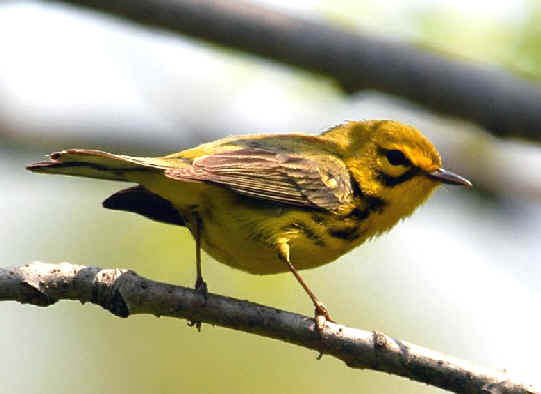
Prairie Warbler
(photo by Howard Eskin)
- Palm Warbler (ph) ______
DE
bh MD bw VA ch
Setophaga
(formerly Dendroica) palmarum
Setophaga palmarum palmarum _____ the
duller-plumaged Western Palm Warbler, that breeds primarily in
central
and
western Canada
Setophaga palmarum hypochrysea _____ the more
yellowish Yellow Palm Warbler, that breeds in New England and eastern
Canada
On the Delmarva Peninsula, particularly on the Eastern Shore of
Virginia, in the fall, and especially in the winter, Western Palm
Warblers outnumber Yellow Palm Warblers considerably. In the
winter, in coastal Virginia, the Yellow subspecies is
relatively rare. Small numbers persist into December in mild winters.
In coastal Virginia, in their fall migrations, the Western Palm
Warbler passes through an average of 10 days earlier than the Yellow
Palm Warbler.
Both subspecies are more numerous, and often much more so, in the fall than
in the spring along the Virginia
coast.
- Cerulean Warbler (t3) ______
DE bh(rare) VA
ch(rare)
Setophaga
(formerly Dendroica) cerulea
- Prothonotary Warbler (ph) ______
DE
bh* MD bw* VA ch(rare)
Protonotaria citrea (monotypic, and the single species of its genus)
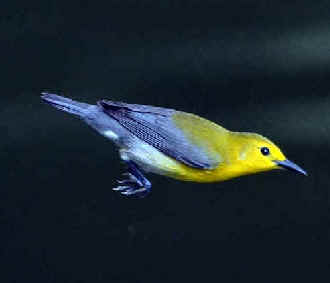
Above & below: Prothonotary Warblers
Above, a female in flight; below, a male perched.
(photos by Howard Eskin)
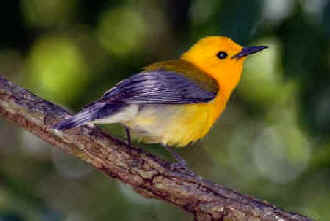
- Swainson's Warbler (r/DP) ______
DE MD VA ch(rare)
Limnothlypis swainsonii
(monotypic, and the single species of its
genus)
A Swainson's Warbler was in Delaware on January 20, 2001 at
Bethany Beach. Most at that time are either in the Yucatan of Mexico or
Jamaica.
In Virginia, away from breeding areas, many of the records of Swainson's Warblers
are old. There have been rare transient records in
the spring and early summer at Chincoteague Wildlife Refuge and at the
Chesapeake Bay Bridge Tunnel.
In the fall, one was banded at Kiptopeke on September 12, 1971, and one was
at the Chesapeake Bay bridge Tunnel on September 30,
1984.
- Worm-eating Warbler ______ DE bh
MD bw* VA ch(rare)
Helmitheros vermivorum (monotypic, and the single species of its
genus)
- Ovenbird (ph) ______ DE bh
MD bw* VA ch*
Seiurus a. aurocapilla
- Northern Waterthrush ______ DE bh
MD bw VA ch
Parkesia (formerly Seiurus) noveboracensis
(now said to be monotypic)
- Louisiana Waterthrush ______ DE bh*
MD bw VA ch(rare)
Parkesia (formerly Seiurus) motacilla
(monotypic)
- Kentucky Warbler ______ DE bh*
MD bw* VA ch(rare)
Geothlypis (formerly Oporornis)
formosus (monotypic)
- Mourning Warbler (ph) ______
DE bh MD bw VA ch
Geothlypis (formerly Oporornis) philadelphia
(monotypic)
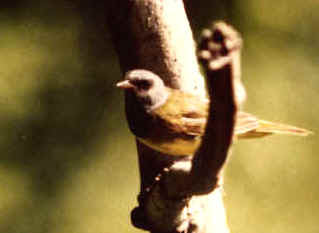
Mourning Warbler
(photo by Armas Hill)
- MacGillivray's Warbler (r/DP)
______ VA
Geothlypis tolmiei
On the Eastern Shore of Virginia, an immature MacGillivray's
Warbler was banded at Kiptopeke November 8,
2005.
- Connecticut Warbler (ph) ______
DE bh(rare)
MD bw VA
ch(rare)
Oporornis agilis
On the Eastern Shore of Virginia, 10 Connecticut Warblers
were banded at Kiptopeke October 20, 1968, where also 4 were observed, not
banded, October 6, 1983.
- Common Yellowthroat (ph) ______
DE
bh* MD bw* VA ch*
Geothlypis t. trichas
- Hooded Warbler ______ DE
bh(rare)
MD bw VA ch(rare)
Setophaga (formerly Wilsonia) citrina (monotypic)
- Canada Warbler (ph) ______
DE
bh MD bw VA ch(rare)
Cardellina (formerly Wilsonia) canadensis (monotypic)
- Wilson's Warbler ______ DE bh
MD bw VA ch
Cardellina
(formerly Wilsonia) pusilla
- American Redstart (ph) ______
DE bh* MD bw VA
ch
Setophaga ruticilla (monotypic, and the single species of its
genus)
- Yellow-breasted Chat (ph) ______
DE
bh* MD
bw VA ch*
Icteria v. virens (the single member of its genus)
ICTERIDS
- Eastern Meadowlark (ph) ______
DE
bh* MD bw* VA ch*
Sturnella magna argutula
- Western Meadowlark (r/DP)
______ MD
Sturnella neglecta
Western Meadowlarks in Maryland have included: one from August
31 to September 13, 2008 at Hurlock in Dorchester County.
- Red-winged Blackbird (ph) ______
DE
bh* MD bw* VA ch*
Agelaius p. phoeniceus

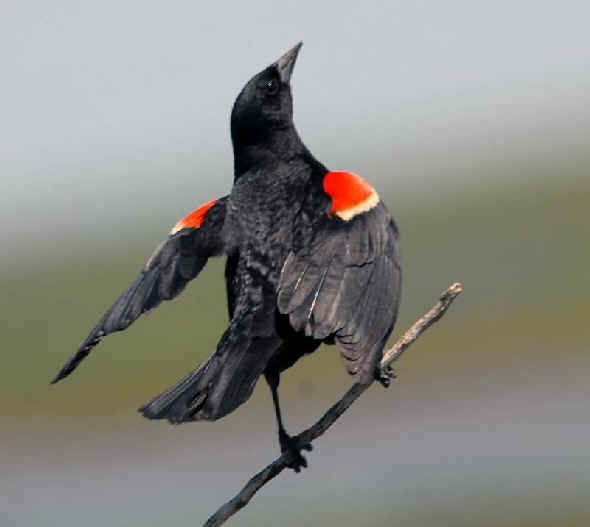
Red-winged Blackbirds
(upper photo by Doris Potter; lower photo by Howard Eskin)
- Yellow-headed Blackbird (u/DP) (ph)
______ DE MD bw(very rare) VA ch(rare)
Xanthocephalus xanthocephalus
- Rusty Blackbird (t3) (ph)
______ DE bh MD bw
VA ch
Euphagus carolinus
- Brewer's Blackbird (u/DP) (ph) ______
DE MD bw(very rare) VA
Euphagus cyanocephalus
- Orchard Oriole (ph) ______
DE
bh* MD bw* VA ch*
Icterus s. spurius
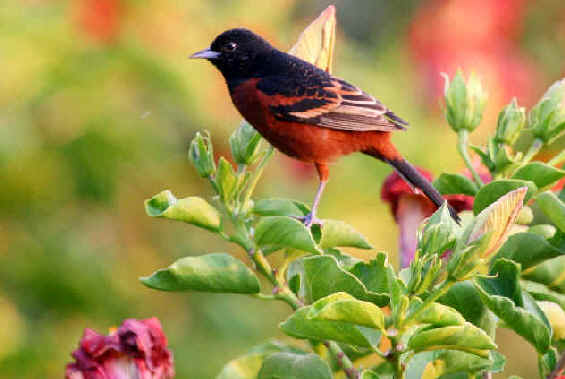
Orchard Oriole
(photo by Marie Gardner)
- Baltimore Oriole (ph) ______
DE
bh* MD bw VA ch
Icterus galbula
(monotypic)
The Baltimore Oriole was, for a while, said to be conspecific with
the Bullock's Oriole of western North America, and when so it was
called the Northern Oriole.
- Bullock's Oriole (r/DP) (ph)
______ DE MD bw(very
rare) VA ch(very rare)
Icterus bullockii
A Bullock's Oriole was in Delaware in late December 1993
at the Brandywine Creek State Park.
In Maryland, there was a Bullock's Oriole was at the
Blackwater Wildlife Refuge September 25, 1994.
On the Eastern Shore of Virginia, there was a Bullock's Oriole
at Chincoteague Wildlife Refuge November 3, 1991.
- Boat-tailed Grackle (ph) ______ DE bh
MD bw VA ch*
Quiscalus major torreyi
On the Eastern Shore of Virginia, there were 7,384 Boat-tailed
Grackles on the Chincoteague Christmas Count on December 28, 1974.
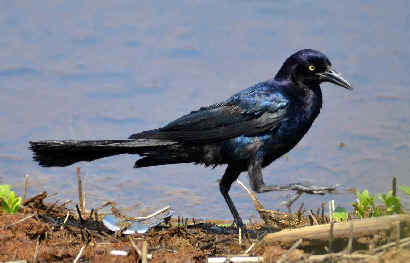
A male Boat-tailed Grackle
(photo by Howard Eskin)
- Common Grackle ______ DE bh*
MD bw* VA ch*
Quiscalus quiscula
- Brown-headed Cowbird (ph) ______
DE
bh* MD bw* VA ch*
Molothrus a. ater
A Brown-headed Cowbird was seen during a FONT pelagic trip
offshore from Lewes, Delaware in June 2002.
- Bobolink (ph) ______ DE
bh
MD bw VA ch
Dolichonyx oryzivorus
The following text is paraphrased from the book "Birds and Marshes of
the Chesapeake Bay Country" by Brooke Meanley, published in 1975,
reprinted in 1983:
The Reedbird, Ricebird, or Bobolink, as it has been
variously known, has always been one of my favorites.
There are many reasons why, but ones that come to mind at the moment have to
do with its association with wildrice marshes, one of our most
attractive wetland areas - its identification with domestic rice culture in
the South Carolina Low Country in years gone by, a romantic era in a
romantic section of the country, and because the plaintive PINK of
the Reedbird high in the sky over the late summer marsh is one of the
early sounds of southward-bound birds that tells us that the exciting event
of fall migration is about to gather momentum.
Bobolink
is the standard or book name for the species, and the one that is usually
applied to the birds on their nesting ground.
Reedbird was the Chesapeake marsh gunner's name 75 years ago when the
reedys, as they were also known, were gunned at various Maryland
locations.
Ricebird was the commonly used name for the species in the Carolina
Low Country because of its depredations on domestic rice. Indeed, Ricebird
was its first name, the one applied by Mark Catesby, a father of
North American ornithology.
The bird's penchant for rice was suggestive to the scientific ornithologists
who gave it the name Dolichonyx oryzivorus,
which translated means "Long-clawed eater of rice". Oryza
is a term for domestic rice.
During their southward flight, beginning in the late summer, Reedbirds
become more coastal in their distribution (and are thus on the Delmarva
Peninsula), with their main route of travel In the East, going south
through the Delaware Valley and Chesapeake Bay Country.
Major concentrations occur in fresh and brackish tidal river marshes
where they feed as noted on wild rice, and also on millet and other
aquatic plant seeds, and where they roost at night.
Many of them leave the marshes during the day to feed on the seeds of foxtail
grass that grows in and around the edges of many Maryland and
Virginia cornfields.
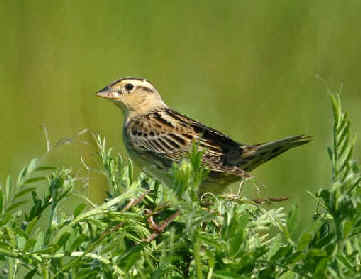
The Bobolink, or "Reedbird" or "Ricebird", as it looks
in the fall
(photo by Howard Eskin)
TANAGERS
- Summer Tanager (ph) ______
DE
bh MD bw* VA ch*
Piranga r. rubra
- Scarlet Tanager (ph) ______
DE
bh* MD bw* VA ch
Piranga olivacea
- Western Tanager (r/DP) (ph)
______ MD
Piranga ludoviciana
Western Tanagers in Maryland
included these: on October 21, 1962 at Ocean City, and on September 27, 2000 at
Northeast in Cecil County.
SPARROWS
(including LONGSPURS, TOWHEES)
- Grasshopper Sparrow (ph) ______
DE
bh* MD bw* VA ch(rare)
Ammodramus savannarum pratensis
- Henslow's Sparrow (r/DP) ______
DE MD bw(rare)* VA ch(rare)
Ammodramus henslowii susurrans
Recently, Henslow's Sparrows have been in Delaware: on May 2,
1995 at the Logan Lane Tract, October 25, 2003 at Gordon Pond.
Historically, Henslow's Sparrows were in Delaware: on June 6,
1903 at Choptank Mills, May 13, 1905 at Bethany Beach, and half a century
later November 7, 1957 again at Bethany Beach.
It was in the 1980s when the Henslow's Sparrow disappeared from
nesting sites in Dorchester County, in Maryland, along the road to
Elliott Island. They bred in grassy areas dominated by Wand-like
Switch-grass, Panicum virgatum, as
did the Sedge Wren (earlier in this list).
On the Eastern Shore of Virginia, the Henslow's Sparrow was
formerly a regular summer resident in Chesapeake Bay marshes in the Saxis
area, but numbers declined until the last was found there was in 1995.
The disappearance of the Henslow's Sparrow from tidal marshes in Delaware,
Maryland, Virginia, (and New Jersey), may be due to loss of
habitat to Phragmites
infestation.
- LeConte's Sparrow (r/DP) (ph) ______
DE bh(very rare)
MD VA ch(very rare)
Ammodramus leconteii
LeConte's Sparrows
were in Delaware: February 9, 1992 at Gordon Pond, October 25 to
November 25, 1998 at Lewes, December 5, 1999 at Bombay Hook Refuge, from
December 24, 2006 to February 4, 2007 at Prime Hook Refuge, December 30,
2007 near Broadkill Beach, October 19, 2009 at Cape Henlopen, December 20,
2009 by Deep Branch Rd.
LeConte's Sparrows
in Maryland included these: from December 27, 1974 to February
1975 and on October 23, 1977 in Ocean City, November 8-11, 1992 at Marion
Station in Somerset County, December 29, 1993 to February 20, 1994 in
Berlin, April 2, 1994 and May 2-4, 1999 at Girdletree, December 4-27, 1999
at Marion Station in Somerset County, December 29, 1999 at the Vaughn
Wildlife Area in Stockton, from January 9 to April 29, 2000 and from
November 11, 2000 to March 24, 2001 at Girdletree, from December 29, 2000 to
February 17, 2001 at the Vaughn Wildlife area in Stockton, February 8-17,
2001 at Girdletree, November 9-17, 2013 at the Assateague Island National
Seashore.
On the Eastern Shore of Virginia, there were 5 fall records of
LeConte's Sparrows (as of 2007) in southern Northampton County, with one
banded at Kiptopeke November 8, 1998, and 4 other records at Kiptopeke and
the nearby Eastern Shore of Virginia Wildlife Refuge between October 21 and
November 21. There were 7 fall records from the Chesapeake Bay Bridge Tunnel
between September 29 and November 24.
Leconte's Sparrows were at Chincoteague Wildlife Refuge April 26,
1980, at the Chesapeake Bay Bridge Tunnel April 27, 1989, Fisherman Island
April 25, 1991. A bird included above in the fall records at the Eastern
Shore of Virginia Wildlife Refuge, as being there on November 21, 1999,
actually remained until at least January 3, 2000.
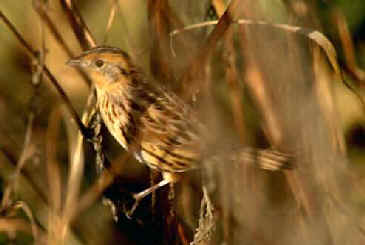
LeConte's Sparrow
(photo by Howard Eskin)
- Seaside Sparrow ______ DE bh*
MD bw* VA ch*
Ammodramus maritimus macgillivrayi
On the Delmarva Peninsula, the Seaside Sparrow is found not just by
the sea, but in salt marshes both on the ocean side (and the Delaware Bay
side) as well as on the Chesapeake Bay side. It favors the plant Black
Needlerush, Juncus roemerianus.
- Saltmarsh Sparrow (t3) (ph) ______
DE bh*
MD bw* VA ch*
Ammodramus caudacutus diversus
The Saltmarsh Sparrow was conspecific with what is now the Nelson's
Sparrow (below). When so, it was called the Sharp-tailed Sparrow.
As does the Seaside Sparrow (above), the Salt Marsh
Sparrow, as its name implies, inhabits salt marshes, but it is found
commonly in the low, bright green Salt Meadow Cordgrass, Spartina
patens, and Salt-meadow Spike-grass, Distichlis
spicata.

Saltmarsh Sparrow
(photo by Howard Eskin)
- Nelson's Sparrow ______
DE bh VA ch(rare)
Ammodramus nelsoni
- Baird's Sparrow (r/DP)
______ MD
Ammodramus bairdii
A Baird's Sparrow was in Maryland on October 14, 1966 in
North Ocean City. A female.
- Bachman's Sparrow (r/DP)
______ VA
Aimophila aestivalis
On the Eastern Shore of Virginia, there are old records of the Bachman's
Sparrow: 1 on the Cape Charles Christmas Count on December 28, 1975, and
1 at the Chesapeake Bay Bridge Tunnel on October 12,
1980.
- Chipping Sparrow (ph) ______
DE
bh* MD bw* VA ch*
Spizella p. passerina
- Field Sparrow (ph) ______
DE
bh* MD bw* VA ch*
Spizella p. pusilla
- American Tree Sparrow ______ DE bh
MD bw VA ch
Spizelloides arborea (formerly Spizella arborea)
- Clay-colored Sparrow (u/DP) (ph)
______ DE MD VA ch(rare)
Spizella pallida
Since 1999, the Clay-colored Sparrow has not been a reviewable species in
Maryland.
- Vesper Sparrow (ph) ______
DE
MD bw VA ch
Pooecetes gramineus
- Lark Sparrow (u/DP) (ph) ______
DE MD
VA ch(rare)
Chondestes grammacus
Since 1999, the Lark Sparrow has not been a reviewable species in Maryland.
- Lark Bunting (r/DP) (ph) ______
DE
bh(very rare) MD
Calamospiza melanocorys
Lark Buntings
have been in Delaware: at the Indian River Inlet on May 4, 1981, and
at Bombay Hook Refuge on August 15, 1995 and in September 2010.
In Maryland, Lark Buntings have included those in: Smithville in Dorchester
County July 10, 1958, Galena in Kent County from November 18 to December 25,
1977, at the Assateague Island National Seashore September 5, 1994, and the
Eastern Neck Wildlife Refuge September 23, 1994.
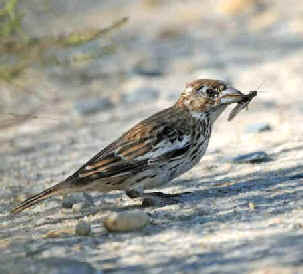
Lark Bunting, photographed at Bombay Hook Refuge
in Delaware in September 2010
(photo by Howard Eskin)
- Savannah Sparrow (ph) ______
DE
bh MD bw VA ch
Passerculus sandwichensis
"Ipswich" Savannah Sparrow (ph) ______ DE
MD VA ch
Passerculus sandwichensis princeps
Passerculus sandwichensis princeps,
or the "Ipswich Sparrow" is a distinctive subspecies of
the Savannah Sparrow that breeds only on Sable Island in Nova
Scotia.
Along the Delmarva seacoast, it is a locally uncommon winter visitor,
generally from mid-November to late March, along the dune line of the
immediate coast.
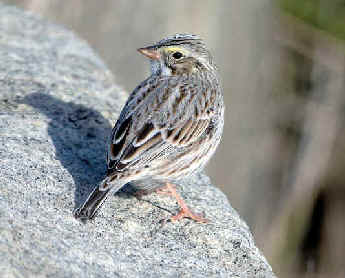
The "Ipswich" Savannah Sparrow
(photo by Howard Eskin)
- "Red" Fox Sparrow ______ DE bh
MD bw VA ch
Passerella iliaca iliaca
"Slate-colored" Fox Sparrow _____
Passerella iliaca schistacea
The "Slate-colored" Fox Sparrow was said to have
occurred, once, in Maryland, but not on the Delmarva Peninsula.
That possible Maryland occurrence was
"unreviewable".
- Song Sparrow (ph) ______
DE
bh* MD bw* VA ch*
Melospiza melodia atlantica
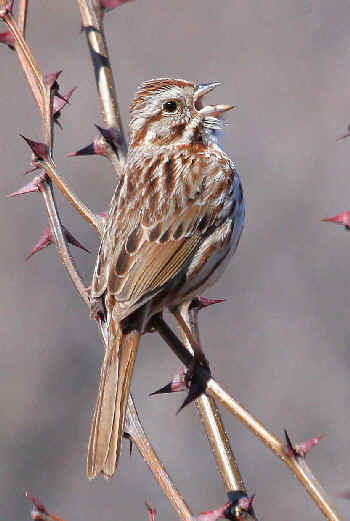
Song Sparrow
(photo by
Doris Potter)
- Lincoln's Sparrow (ph) ______ DE
MD bw VA ch(rare)
Melospiza lincolnii
- Swamp Sparrow (ph) ______
DE
bh* MD bw* VA ch
Melospiza georgiana
Swamp Sparrows
that breed on the Delmarva Peninsula are the subspecies Melospiza
georgiana nigrescens, the "Coastal Plain Swamp
Sparrow". It nests in tidal fresh and brackish
marshes.
Transients and many wintering birds on the Delmarva Peninsula are
probably mostly the subspecies Melospiza
georgiana ericrypta.
- White-throated Sparrow ______ DE
bh MD bw VA ch
Zonotrichia albicollis
- White-crowned Sparrow (ph)
______ DE bh MD bw
VA ch
Zonotrichia leucophrys
"Gambel's White-crowned Sparrow" (r/DP)
______ VA
Zonotrichia leucophrys gambelii
In Virginia, at the Eastern Shore of Virginia Wildlife Refuge
there were single "Gambel's White-crowned Sparrows": on
November 12. 1999, and November 3, 2002.
- Golden-crowned Sparrow (r/DP)
_____ MD
Zonotrichia atricapilla
A Golden-crowned Sparrow was in Maryland at Rock Hall in Kent
County from December 19, 2010 to February 12, 2011.
- Harris' Sparrow (r/DP) (ph) ______
DE VA
Zonotrichia querula
Harris' Sparrows
have been in Delaware: November 11, 1973 at Smyrna, November 14, 1998
at Cape Henlopen,
October 12 to November 3, 2008 at the Brandywine Creek State Park.
In Virginia, at the Eastern Shore of Virginia Wildlife Refuge, an
adult Harris' Sparrow was found on November 7, 2003 and two days
later an immature was also found in the same area. Both were present until
November 17.
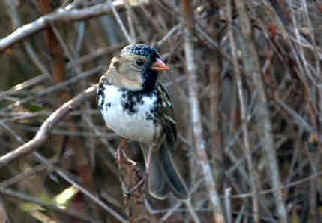
A Harris' Sparrow photographed in Delaware in 2008
(photo by Marie Gardner)
- Dark-eyed Junco (ph) ______
DE
bh MD bw VA ch
Junco hyemelis
"Oregon Junco" (r/DP) ______
Junco hyemelis oreganus
"Pink-sided Junco" (r/DP) ______ VA
Junco hyemelis mearnsi
On the Eastern Shore of Virginia, a single "Pink-sided
Junco" was at Kiptopeke from November 10, 1999 to January 29, 2000.
It was photographed.
- Lapland Longspur (u/DP) (ph) ______
DE bh(rare) VA ch
Calcarius lapponicus
On the Eastern Shore of Virginia, a total of 75 Lapland
Longspurs were at Chincoteague Wildlife Refuge on November 27.
1981.
- Smith's Longspur (r/DP) (ph)
______ MD
Calcarius pictus
A Smith's Longspur was in Maryland at the Assateague
Island National Seashore from November 27, 1976 to January 16, 1977.
- Chestnut-collared Longspur (nt)
(r/DP) (ph) ______ MD VA ch(very
rare)
Calcarius ornatus
There was an adult male Chestnut-collared Longspur in Maryland,
in West Ocean City, over a hundred years ago, back on August 20,
1906.
On the Eastern Shore of Virginia, a Chestnut-collared Longspur
was at Chincoteague Wildlife Refuge on June 5, 1977.
- Snow Bunting (ph) ______
DE
bh MD bw VA ch
Calcarius (formerly Plectrophenax) nivalis
- Eastern Towhee (ph) ______
DE
bh* MD bw* VA ch*
Pipilo erythrophthalmus rileyi
The Eastern Towhee was called the Rufous-sided Towhee.

A male Eastern Towhee
(photo by Howard Eskin)
- Green-tailed Towhee (r/DP) (ph) ______
DE
Pipilo chlorurus
A Green-tailed Towhee was in Delaware on February 28, 1964
near Wilmington.
DICKCISSEL, CARDINAL,
GROSBEAKS, BUNTINGS
- Dickcissel (u/DP) (ph) ______
DE bh(rare) VA
ch(rare)
Spiza americana
Dickcissel
numbers on the Delmarva Peninsula vary from year to year.
- Northern Cardinal (ph) ______
DE
bh* MD bw* VA ch*
Cardinalis c. cardinalis
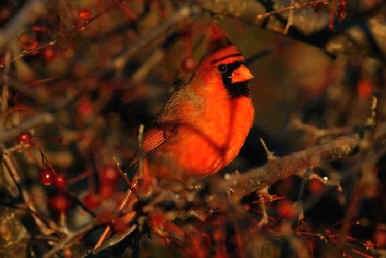
Northern Cardinal
(photo by Howard Eskin)
- Rose-breasted Grosbeak (ph)
______ DE bh MD bw
VA ch
Pheucticus ludovicianus
- Black-headed Grosbeak (r/DP) ______
VA ch(very rare)
Pheucticus melanocephalus
On the Eastern Shore of Virginia, there were Black-headed
Grosbeaks: at Kiptopeke October 16, 1971, at Chincoteague Wildlife
Refuge November 28, 1971, and November 23-24, 1984, and south of Cape
Charles December 30-31, 1991.
The November 1971 bird at Chincoteague was found dead on a road. It was the
subspecies P. m. maculatus.
- Blue Grosbeak (ph) ______
DE
bh* MD bw* VA ch*
Passerina
(formerly Guiraca) c. caerulea
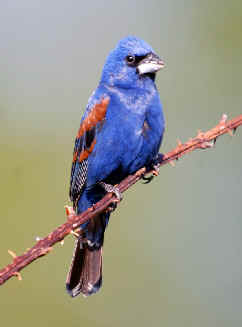
Blue Grosbeak
(photo by Howard Eskin)
- Indigo Bunting (ph) ______
DE
bh* MD bw* VA ch*
Passerina cyanea
(monotypic)
- Painted Bunting (u/DP) (ph) ______
DE bh(very
rare) VA
Passerina ciris
Painted Buntings
were in Delaware: August 19-20, 1989 at Bombay Hook Wildlife
Refuge, January 12-14, 1996 at Bethany Beach, from December 28, 1997 to
January 1, 1998 at the Little Creek Wildlife Area, January 2, 2000 near
Primehook Wildlife Refuge, December 23-30, 2006 at Seaford, January 12, 2008
at Newport, May 5-23, at Georgetown, August 27, 2009 at Primehook Wildlife
Refuge, from January 14 to February 11, 2011 by Deep Branch
Rd.
On the Eastern Shore of Virginia, a Painted Bunting was in
Northampton County on May 12, 1999.
Birds that have been on the
Delmarva Peninsula, not in Delaware
Masked Duck
Trindade Petrel (Delmarva offshore waters)
Scopoli Shearwater (Delmarva offshore waters)
Cape Verde Shearwater (Delmarva offshore waters)
Bulwer's Petrel (Delmarva offshore waters)
Ferruginous Hawk
Western Marsh Harrier
Corn Crake
Southern Lapwing
Snowy Plover
Mountain Plover
Long-billed Curlew
Bar-tailed Godwit
Black-tailed Gull
Elegant Tern
Brown Noddy
Black-chinned Hummingbird
Green Violetear
Red-cockaded Woodpecker
Gray Kingbird
Hammond's Flycatcher
Pacific-slope Flycatcher
Bewick's Wren
Rock Wren
Mountain Bluebird
Bohemian Waxwing
Sprague's Pipit
Virginia's Warbler
Townsend's Warbler
MacGillivray's Warbler
Western Meadowlark
Birds that have been across
the Delaware Bay in Cape May, not in Delaware
Ruffed Grouse
Eurasian Kestrel
Corn Crake
Lesser Sand Plover
Long-billed Curlew
Eurasian Woodcock
Black-tailed Gull
Brown Noddy
Band-tailed Pigeon
Lesser Nighthawk
Black Swift
Black-chinned Hummingbird
Gray Kingbird
Bell's Vireo
Brown-chested Martin
Violet-green Swallow
Bewick's Wren
Rock Wren
Mountain Bluebird
Townsend's Solitaire
Bohemian Waxwing
Townsend's Warbler
MacGillivray's Warbler
Western Tanager
Baird's Sparrow
Bachman's Sparrow
Golden-crowned Sparrow
Chestnut-collared Longspur
Smith's Longspur
Black-headed Grosbeak
Birds that have been on the
Delmarva Peninsula, not in Maryland
Bulwer's Petrel (Delmarva offshore waters)
Clark's Grebe
Wood Stork
Little Egret
Red-billed Tropicbird
White-tailed Kite
Ferruginous Hawk
Western Marsh Harrier
Northern Crested Caracara
Purple Gallinule
Sandhill Crane
European Golden Plover
Pacific Golden Plover
Snowy Plover
Mountain Plover
Eurasian Curlew
Black-tailed Godwit
Bar-tailed Godwit
Common Redshank
Wood Sandpiper
Little Stint
Sharp-tailed Sandpiper
Mew Gull
Black-tailed Gull
Ivory Gull
Elegant Tern
White-winged Tern
Whiskered Tern
Brown Noddy
Black Guillemot
White-winged Dove
Common Ground Dove
Black-chinned Hummingbird
Allen's Hummingbird
Broad-tailed Hummingbird
Anna's Hummingbird
American Three-toed Woodpecker
Ash-throated Flycatcher
Dusky Flycatcher
Gray Flycatcher
Pacific-slope Flycatcher
Say's Phoebe
Vermilion Flycatcher
Bell's Vireo
Boreal Chickadee
Fieldfare
Northern Wheatear
Sprague's Pipit
MacGillivray's Warbler
Bachman's Sparrow
Harris' Sparrow
Lapland Longspur
Green-tailed Towhee
Black-headed Grosbeak
Painted Bunting
Birds that have been on the Delmarva Peninsula, not in Virginia
Pink-footed Goose
Masked Duck
Trindade Petrel (Delmarva offshore waters)
Scopoli's Shearwater (Delmarva offshore waters)
Cape Verde Shearwater (Delmarva offshore waters)
Roseate Spoonbill
Swallow-tailed Kite
Mississippi Kite
White-tailed Kite
Northern Crested Caracara
Corn Crake
Northern Lapwing
Southern Lapwing
European Golden Plover
Pacific Golden Plover
Eurasian Curlew
Common Redshank
Wood Sandpiper
Red-necked Stint
Little Stint
California Gull
Yellow-legged Gull
Ivory Gull
Ross' Gull
Whiskered Tern
Black Guillemot
Broad-tailed Hummingbird
Calliope Hummingbird
Anna's Hummingbird
Green Violetear
American Three-toed Woodpecker
Tropical Kingbird
Hammond's Flycatcher
Dusky Flycatcher
Gray Flycatcher
Bell's Vireo
Boreal Chickadee
Fieldfare
Pine Grosbeak
Virginia's Warbler
Western Meadowlark
Western Tanager
Baird's Sparrow
Lark Bunting
Golden-crowned Sparrow
Smith's Longspur
Green-tailed Towhee
To Top of Page


 Delmarva
Birds
Delmarva
Birds












































































































